3 Volumes
Philadelphia Medicine
Several hundred essays on the history and peculiarities of Medicine in Philadelphia, where most of it started.
Health Reform: A Century of Health Care Reform
Although Bismarck started a national health plan, American attempts to reform healthcare began with the Teddy Roosevelt and the Progressive era. Obamacare is just the latest episode.
Second Edition, Greater Savings.
The book, Health Savings Account: Planning for Prosperity is here revised, making N-HSA a completed intermediate step. Whether to go faster to Retired Life is left undecided until it becomes clearer what reception earlier steps receive. There is a difficult transition ahead of any of these proposals. On the other hand, transition must be accomplished, so Congress may prefer more speculation about destination.
Medical Economics
Some Philadelphia physicians are contributors to current national debates on the financing of medical care.
The Hospital That Ate Chicago (1)

|
| George Ross Fisher M.D III |
One evening in 1979 my visiting son, puzzled by health financing, asked me to explain. A decade of asking myself the same question led to the prompt reply that there seemed to be two central problems, both of them man-made. It's axiomatic in our family that man-made problems can have man-made solutions.
I believed you adequately understood health care financing if you understood the price reduction which hospitals give to subscribers of Blue Cross but not to subscribers of their competitors, and if you also understood the income tax dodge which the Federal government gives to salaried, but not to self-employed people who buy health insurance.
He asked how in the world these two subsidies were defended, and I told him. He then asked how these monopoly-inducing subsidies related to other weird quirks of health finance, and I told him that, too. He listened quietly for thirty minutes, and then exclaimed, "Wow. That's really the Hospital that Ate Chicago!"
So he went to bed, while I stayed up and wrote a short fancy for the New England Journal of Medicine, called, "The Hospital That Ate Chicago". Next morning I polished it a little and sent it off to the editor. Within a few days, it was accepted. Six weeks later it was in print.
The Nation's Future Health Profile
 As the nation's health steadily improves, it's going to cause some problems of a social nature. 
|
The most astoundingly good news about health is frightening, precisely because it is so astoundingly good. The average life expectancy of Americans has increased by three years during the last decade. That's right, we got thirteen years for the price of ten. Most of that improvement has come from taking daily aspirin tablets, or from taking the anti-cholesterol "statin" drugs, with a resulting decrease in the death rate from heart attacks and strokes by roughly 30%. It seems possible to hope for another three-year extension of lifespan in the next decade; when statin drugs lose their patent protection they will become a lot cheaper, and many more people will take them regularly. It seems churlish to emphasize the negatives of such a miracle, but unfortunately, it's questionable if our political and financial mechanisms can readjust to such an unprecedented commotion.
It could get much worse. The improvements in cancer treatment have lately been much slower and more expensive. If someone invented a treatment for malignancy which proved to be safe and cheap, we could get another five years, followed by still another five years as the patents run out and doctors get the hang of using it. Everybody could then reasonably expect to live to be ninety. What the Social Security and Medicare budgets would look like under those circumstances, must simply boggle the mind. If people mostly lived to be ninety, comparatively few of them would have much serious illness before they were sixty-five. The vast bulk of medical expense, for practical purposes almost all of it except obstetrics and psychiatry, would become Medicare expense. People would of course eventually die of something, and all of those terminal care costs would be Medicare costs. The government would, of course, begin to see what is happening and attempt to change the political arrangements for financing it, but that would be resisted bitterly, and it would be slow. What would not be slow would be the decision by employers that there is no sense in accepting financial responsibility for health costs which no longer have much impact on working people. Right now, health insurance amounts to forcing employees under the age of forty to subsidize the costs of other employees between the ages of forty to sixty-five. If that curve shifts to the point where everybody under sixty-five is essentially subsidizing people on Medicare, well, say goodbye to employer-based health insurance. Not later, right now. At the end of whatever calendar year, employers all wake up together and start a stampede out the door.
The first issue, of course, is not how to shift around the costs of medical care, but how to pay for staying alive. We can raise the age for beginning Social Security benefits, but that doesn't create money, it just shifts retirement cost from the government to the individual. What matters is that people must keep working longer, earning at least enough to support themselves; and that implies greater competition with younger people for available work. It may mean greater resistance to immigration, particularly illegal immigration, and a greater appreciation for frugal living. But shifts of twenty or thirty percent in the workforce within a decade probably cannot be accomplished, any more than they could be accomplished in Africa after the elimination of epidemic diarrhea and other tropical diseases. Genocide as an avocation does not seem very appealing, either. One suspects something similar happened to India with British colonial rule, better water and drains, and all that. And one has to speculate that something like that is being concealed in China, for all its vaunted growth in Gross Domestic Product. Selectively killing all girl babies at birth, and all boy babies after the first one seems more drastic than we would accept. But we must eventually do something, with the first step being a general appreciation of the problem. Overpopulation may or may not be the problem; the problem is too many healthy people past the traditional age of employment.
Somewhere in the writings of Aristotle is the maxim that all culture comes out of the wealthy classes because only the wealthy have time for it. Aristotle is obviously now out of date on that topic, because we can easily foresee a population of healthy old folks with time on their hands. Our cultural institutions seem painfully slow to recognize, not just their new customer base, but the potential creative base. Surely, Grandma Moses is not the only artistic self-promoter in her age group. And surely, adolescent love affairs are not the only topic capable of attracting a mass audience. Improved cataract extractions, better hearing aides, and outstanding dentistry will surely make it possible to foresee more grown-up tastes in music, the visual arts, and culinary skills. Once these old folks stop predicting their own impending deaths and face a twenty-five-year future on the golf course, a flowering transformation of the arts is safely predictable.
But that's not enough. Most people were not born with the talent to carry a musical tune or draw a straight line, and many of those who do have some talent feel the arts are trivial. For most people, the way to fill up a quarter of a century is to go back to work. I didn't say it was easy. There is just no feasible alternative.
Abortion
The official position of the Pennsylvania Medical Society on the topic of abortion is, we have no position on abortion. I ought to know because I was the author of this position, proposed at a moment when the PA Medical House of Delegates was obviously going nowhere. After two hours of angry debate, we had to stop before we split into two warring medical societies. The Pennsylvania delegation to the AMA was then obliged to hold the same no-position on a national level. As I recall, our position was likewise greeted by the AMA House of Delegates with great relief, and word quickly circulated in the corridors that Pennsylvania had a position everyone could endorse for the good of the organization. For several years, this no-position position was widely referred to whenever the topic threatened to arise. It almost invariably stopped the discussion in its tracks, as it was intended to do. In going back over the minutes, it would appear the AMA never actually voted to adopt a no-position motion, a discovery that surprised but did not change the basic determination to let the rest of the nation settle this. We were going to stay out of it.

|
| Roe vs. Wade |
Because, one hundred forty years earlier, we started it. If you actually read Justice Blackmun's opinion for the majority in Roe v. Wade, as very few agitated proponents seem to have done, the original medical origin is clearly laid out. Blackmun had been a lawyer for the Mayo Clinic before his appointment to the Supreme Court, acquiring unusual medical resources and experiences for a lawyer. Now prepare for a logical leap, to the The Gross Clinic, Thomas Eakins masterpiece painting of Philadelphia's pre-eminent surgeon in a black frock coat, holding a dripping crimson scalpel in his bare hand, encapsulates the original situation. Note carefully that anesthesia is being given to the patient, but the surgeon is not wearing a cap, mask, gown, or rubber gloves.
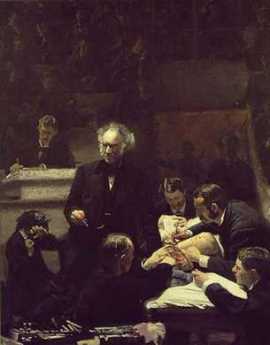
|
| Gross Clinic |
In 1850 medical science had progressed into a forty-year time window when anesthesia made abortions painless, but Pasteur had still not identified bacteria, and Lister had not devised a way to cope with them. Abortions, common in ancient Greece but forbidden by Hippocrates, suddenly were widely demanded by 19th Century women in a situation when their judgment was vulnerable. Abortions were easy to do, all right, but women died like flies from the resulting infections, and the American Medical Association was distraught about it. The Oath of Hippocrates was brought forward to emphasize its prohibition of abortion, and the performance was made unethical for a member of the Association, sufficient cause to warrant expulsion. When that proved inadequate, the delegates agreed to go to their local state legislatures and seek legislation prohibiting the performance of abortion by anyone, member or non-member of the Association. These laws were quickly passed, and it was the Texas version which was overturned by Roe v. Wade as an unconstitutional denial of privacy. Roe was a pseudonym for the patient, and Wade was then Attorney General of Texas, the officer charged with enforcing Texas law. By 1900 abortions became both easy and safe for the mother, and by 1911 the AMA had reversed its position. The scientific surgical situation is well illustrated by a later famous painting about Philadelphia surgery by Thomas Eakins, the Agnew Clinic, in which the surgical team is portrayed in its modern costume of sterile gowns and rubber gloves. But it didn't matter since by that time various churches had hardened their doctrines. Religious leaders and their constituent politicians simply no longer cared what the medical profession thought about it. For at least the following century, ideological combatants were plainly only interested in whether physician opinion might advance one side or the other of their argument with useful official statements. Our real position, if anyone cares, is that we started out seeking protection for the safety of the mother, but the issue got twisted by others into disputes about the welfare of the unborn fetus.
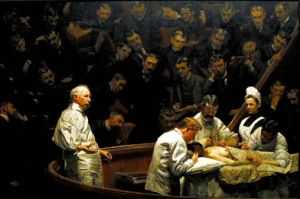
|
| Agnew Clinic |
Since this is the case, there plainly may be a reason for state legislatures to reconsider the state laws they passed in the 19th Century, during that forty-year window of time when the scientific facts were in transition. But when a leap is made by the appointed referees of the federal government to overturn state laws, even about a basically medical issue, there has to be some legal reason to intervene; a medical reason somehow doesn't count. Justice Blackmun's discovery of an unnoticed right to "privacy" in the Constitution, where the word does not appear, is just too hard for us non-lawyers to deal with. Suppose we leave the fine points of the Bill of Rights to those constitutional lawyers. What's at stake here, among other things, of course, is whether the Federal Courts are justified in overturning well-intentioned state laws which had served well for at least fifty years -- simply out of impatience with the sluggishness and political timidness of state legislatures to revise obsolete laws. That's unbalancing the Constitution for a comparatively minor cause. Even major cause is something we have agreed to adjust in other ways, by amendment, not judicial opinion. And that's my opinion, having comparatively little to do with abortion.
Why Are Hospital Prices So High?

|
| Aspirin |
Cost analysts maintain it really does cost ten dollars to write a simple business letter, so maybe it's no surprise when hospitals charge ten dollars to administer an aspirin tablet.
But there's also another form of hospital overcharging. Mark-ups of prices of several hundred percents over audited costs are routine in hospital bills. These are not hidden cross-subsidies, either; they emerge on the yearly audit as multi-million dollar "losses", neatly balanced by "contractual allowances". Translated, these are discounts to insurance companies.
Why do hospitals raise prices, then turn around and discount them? Why do they overcharge, then call it a loss when they write it off?
It's an important question, because it results in confronting patients without insurance with much larger bills than the effective price to insured ones; patients who can't afford to pay are charged more than those who can.
The old-time system of hospital wards to care for people who couldn't pay have been replaced by collection departments and hospitals are very aggressive in pursuing the very people who can least afford to pay, and who are grossly overcharged in the first place.
Health savings accounts with high deductibles were conceived as a way for people to self insure but they have been thwarted by hospital overcharges. Since HSA deductibles are guaranteed, hospitals perpetuate their present largest source of loss -- unpaid deductibles. So why do hospitals continue to post abusively-high prices for patients without large-insurance-company coverage?
Until hospital officials come forward with a coherent defense of their practices, outsiders can only guess at motives. Start with the old legal approach of "Cui bono?" (Who might have a motive?) and divide the answers into those with a motive and those with the means. The line-up will then consist of hospitals, insurance companies, limited-license practitioners, and the state government. Limited licensees, acupuncturists and the like, surely must hate high-deductible health insurance because their fees mainly fall below the two or three thousand annual deductibles. Old-line health insurance companies also have plenty of motive to keep out competitors, fearing antitrust action if they get too obvious. That leaves the state government.
States have ample power over hospitals. Substantial annual payments are negotiated with hospitals for Medicaid services, charity care, and educational grants and subsidies. Tax exemptions are repeatedly challenged and re-negotiated, and overall non-profit corporations are entirely creations of the state legislature. So, unless it is a violation of federal law, the state government has the means to compel hospitals to do anything. Power, yes, but where is the incentive for states to wish for exorbitant hospital prices? Or confer monopoly status on certain insurance vendors by according them sweetheart discounts?
All current plans for "reforming" health care involve providing government-paid insurance to those without. Will the result be to permanently institutionalize the artificially-high public prices to be paid in full by the government? If so, you can well understand why hospitals support these "reforms".
So hospitals are no better than stores that mark up their prices and then loudly proclaim that they will give you a discount. 200% mark-up, 10% off; terrific.
Specialized Surgeons
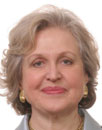
|
| Regina E. Herzlinger |
Local attitudes always somewhat persist among migrants from home. What's distinctive about the Philadelphia diaspora is how unconscious most of them are about still carrying the hometown mark. Philadelphia leaves a prominent birthmark, but it's sort of back between your shoulder blades and you forget it's there. What occasions this observation is a Christmas call from a prominent California surgeon who was once my roommate, back in the days when residents were actually resident in the hospital. More than fifty years ago Bill Doane also served as best man at my wedding. Our conversation turned to clots in the lung, and he related a story. He had once fixed a hernia for a 22-year old girl in the days when it was customary to keep hernia cases in bed for a while. Getting out of bed for the first time, she coughed and turned blue, suddenly on the edge of death. Taken back to the operating room, her chest was opened, and Bill removed a clot which was essentially a cast of the blood vessels of one entire lung. As surgeons like to say, she then did very well.
One doctor can tell such a story to another doctor in four sentences, while lay people who overhear it miss the whole point. The fact is, not one surgeon in ten thousand today could carry this off. Nowadays we train thoracic surgeons to open the lungs; they never repair hernias. Conversely, we train hernia surgeons to fix a dozen hernias daily through a little telescope; they never open a patient's chest. So it is hard to imagine many contemporary surgeons who could recognize this disastrous complication of hernia repair, then fix it themselves in time to rescue the patient. Although this disheartening decline into repetitive super specialties has been forty years in the making, it has been recently popularized with the general public by Regina E. Herzlinger, a Harvard business professor. Writing books and speaking to businessmen groups, she has popularized the proposal to outsource the general hospital into what she calls "focused factories." She rightly characterizes the medical profession as reluctant. She's a nice person, and undoubtedly sincerely believes focused factories will save money, improve quality. But we must not let this idea take hold.

|
| Pennsylvania Hospital |
Specialty hospitals have actually been given more than a fair trial. About a hundred years ago, the landscape was peppered with casualty hospitals, receiving hospitals, stomach hospitals, skin and cancer hospitals, lying-in hospitals, contagious disease hospitals, and a dozen other medical specialty boutiques. With a few notable exceptions, they all failed for the same reason. Sooner or later they found they could not adequately service their specialty without the backup of a full hospital service. Children's hospitals do thrive, but they have patients who are generally of the wrong physical size to fit adult hospital facilities and equipment. There are plenty of things to regret about general hospitals' design, but the inescapable fact is they all must have a very wide range of services to perform any mission, no matter how discrete. It would be still better if the doctors had an equally wide range of skills in their own heads, but the avalanche of innovation and lawsuits has forced sub-specialization, compartmentalizing, and narrowness of viewpoint. Circumstances have forced the profession to hunker down, but that trend must be resisted, not celebrated.
The instant and successful repair of pulmonary embolism make a dramatic illustration, but the reasons for broad medical training are more extensive than that. In the first place, it is much cheaper to use the generalist office than to bounce people to a gastroenterologist for heartburn, a psychiatrist for anxiety, and a dermatologist for pimples. The American employer community is desperate for a way to reduce its burden of employee health costs, and flocks back to their nurturing business schools for advice. They would do better to seek repeal of the tax dodges which tempted them into their present muddle, of course. But in any event, they must be persuaded to recall the disaster of managed care and at least, avoid meddling in hospital design.
That's the cost issue, where specialization surely raises costs. Constant repetition of the same procedure seems superior to first-time fumbling, although it is questionable how long it takes a well-trained surgeon to pick up a new procedure and do it well. But for this system to work, the referring physicians need to be more skillful, not less, in choosing a good one to refer to. There's just nothing like the experience of working for a few weeks in the specialty as a rotating intern, to tell you what to look for and what to avoid. If every doctor in a hospital is making a dozen internal referrals a day, the cumulative effect on the quality of the whole institution is dramatic -- when they have had sufficient past involvement in the specialties to which they now only refer patients. Some specialists will become popular and rich; others will sulk around unnoticed for a while, then go elsewhere. This process, of course, occurs everywhere; what's institutionally distinct is the culture underlying the standards for preferences.
We'll talk later about the Doane brothers of Bucks County, who were judged to be too handsome to hang. Right now, the point of this story can be summarized by the old Pennsylvania Hospital adage, that you must first be a good doctor before you can be a good specialist. Not only was the Pennsylvania Hospital the first in the nation. For sixty years it was the only hospital in the nation, and for decades after that, it was the only hospital in Pennsylvania. In medical history circles, it is said that the history of American medicine, is the history of the Pennsylvania Hospital.
Medicare/Health Savings Accounts Legislation
New Health Insurance Reform Proposals
 "SUPPLY SIDE" HEALTH INSURANCE REFORM a) reduced small-claims insurance costs b) reduced "moral hazard" overutilization costs c) compounded internal investment of reserves d) utilization of the now-wasted labor potential of young retirees It does not aim directly at the goal of reducing the number of uninsured, except on the principle that if something becomes cheaper, more people can afford it. 
|
| Dr. Fisher |
1. HIGH DEDUCTIBLE. The annual deductible of health insurance should be high, in the range of $ 3000 per year. The main reason for a high deductible is to make health insurance premiums cheaper, especially for currently uninsured people. But high deductibles serve other important purposes. 80% of costs concentrate in the most expensive 20% of illness episodes, but these "big ticket" expenses generate far less than 80% of administrative costs. The cost of healthcare to society can be markedly reduced (at least 30%) by eliminating small-claims administrative costs, as well as the disproportionate "moral hazard" costs of minor illnesses. "Moral hazard" includes wasteful utilization of services and insensitivity to price, both deriving from interposing insurance "third parties" rather than paying the providers directly. Note: the advantages of deductibles are not present in "co-pay" features, which in fact increase administrative costs, particularly when a second, or coinsurance, a policy is employed to cover them.
2. COVER DEDUCTIBLE PORTION WITH MEDICAL SAVINGS ACCOUNT. Because high-deductible insurance may give poor people a financial barrier to access, the 2003 Law encourages linking high-deductible policies to a tax-sheltered Medical Savings Account, renamed Health Savings Accounts. Thus, although medical bills (up to the deductible threshold) require cash, reimbursement reserves are supplied by the individual's Account.
These reserves also create new and unexpected value, including portability between jobs, a more level playing field for tax preferences, a longer horizon for health coverage than traditional one-year policies, and neutrality of employers to individual employee health preferences. Although conventional health insurance could be paid for by credit or debit cards, it has somehow never been conventional to use them. Medical Savings Accounts, by contrast, commonly use credit cards, because they simplify record-keeping for the deductible.
What is the source of the money in Medical Savings Accounts? High-deductible premiums are roughly a third of conventional health insurance, depending on the individual's age. The remaining two-thirds go into the tax-deductible savings account. Current law permits additional contributions (out of pocket, but tax-exempt), scaled to the individual's age. If the account is mostly untouched by a healthy person for two years, it becomes increasingly difficult to exhaust it later because of a) its internal income generation, and b) the top limit on expenditures created by the insurance policy. For low-income individuals, funding might be publicly supported.
3. NOTICE THE TWO DIFFERING PROVIDER PAYMENT-METHODOLOGIES. The level of $3000 annual deductible was chosen as within the current band of outpatient-inpatient price separation and requires an inflation adjustment clause to keep it there. One of the chief advantages is to permit two different reimbursement approaches to co-exist, one for outpatients and one for inpatients, without mandating either one.
A high deductible is intended to save cost, preserve individual choices, and to restore consumer negotiating power: consumers gain control to negotiate prices for better service. They can readily observe what is happening, and can readily move to another provider.
However, for incapacitated patients within an inpatient complex, such advantages become unrealistic. Their bundled services (psychiatry may be an exception) should be priced by diagnosis. Although the present DRG (Diagnosis Related Group) system badly needs revision, its introduction by Medicare in 1983 proved so superior to item reimbursement and cost reimbursement, that almost all health insurers employ it.
Moral hazard, which is much lessened for services within the deductible, reappears when the deductible is satisfied, especially when the decision is made to enter the hospital. A financial incentive exists for patients to prefer more expensive but fully insured inpatient care. 1) Accordingly, it would be wise to allow the deductible threshold to rise when excess funds appear in the Medical Savings Account; since that would lower the insurance premium further, the individual has some incentive to agree to it. 2) The patients who select more economical care should share the savings they create. Therefore, policymakers (and providers) should reconsider their instinct to limit the benefits of health insurance strictly to health expenditures. 3) To this end, Medical Savings Accounts should be unified with some or all federal, and federal qualified, tax-preference funds, including possibly Social Security itself. 4) In order to sharpen the focus of most concern to the matters where moral hazard is greatest, a series of insurance carve-outs should be added. These carve-outs would focus on issues where other concerns are greater than the moral hazard feature, for example, obstetrics and terminal care, or where the moral hazard is significantly different, as in-home care and durable medical equipment.
In all efforts to structure incentives away from moral hazard concerns, it should be remembered that draconian countermeasures have already been tested and failed. If individuals desire care-managers to work on their behalf, they should be charged for that unbundled service out of their Medical Savings Accounts, shifting the risk it will lower their medical costs, and the profit if it does, to themselves. Rationing has been firmly rejected by the public, as well as deliberate limitation of medical facilities in order to ration by shortages. All of these approaches are bad politics. Finally, it should be noted that the preference for insured inpatient services has historically been addressed by expanding the limits of insurance to include outpatient care and home care. This might be good politics, but it is not good arithmetic since it has been one of the main sources of healthcare inflation in recent years.
4. LIFETIME COSTS RATHER THAN ANNUAL COSTS. BEGIN WITH TERMINAL CARE. Medical costs are rapidly concentrating in two places: the first year of life and the last year of life. Because of the technology cost to achieve that transition, it makes take several decades for it to become obvious. Meanwhile, the design of health insurance should begin the process, incrementally, of moving to lifetime health insurance instead of annual insurance. Eventually, it can be expected that the cost of living too long will be equal to the cost of dying too soon, but cost predictions are presently difficult. We could rather easily begin the process -- by carving out the cost of terminal care, insuring it separately from the rest of Medicare, and demonstrating to the public the remarkable power of COMPOUND INTEREST ON INTERNAL INSURANCE RESERVES. For example, it has been loosely stated that two thousand dollars invested at birth, compounded tax-free, would roughly pay for an average lifetime's medical expenses.
Carving out terminal care could be accomplished without the public much noticing it, by the following means. Medical care would continue to be paid for by conventional methods, but all costs which fall in the last year of life would be designated "terminal care" and retrospectively reimbursed to the insurance entity which paid them. Since substantial proportions of Medicare funds are now being paid out during the last year of someone's life, the reduction of Medicare's pay-as-you-go "premium" would be considerable. Accordingly, a comparable amount could be set aside from Social Security payroll taxes, invested at compound interest, and eventually made available to pay the individual's terminal care. Transition costs, future cost projections, interest rate risks, and methodology of investment are set aside in this discussion since this project would have to develop some actual experience before a final design is possible.
5. CARVE-OUTS. By limiting health insurance premiums to the current year, the uncertainty of future medical cost inflation is addressed. However, this insurance advantage is confounded by treating all medical costs as if they were random events, including any costs which can be deferred into a different premium year, and other costs (like birth and death) which lack the individual potential for occurring randomly in multiple years. To the degree that such medical costs can be teased out of their mixture with more random risks, opportunities for patients, providers, and insurers to game the system are reduced.
A carve-out system for terminal care has been mentioned, as well as a carve-out of managed care management costs. The latter might be paid for outside of the Medical Savings Account, just as investment advice is often paid for outside an IRA, in order to preserve tax-exempt funds. (The same may be true for preventive care costs). If managed-care management advice actually saved money, fee-based advice might be a prudent option to adopt. It seems very likely that prescription drug costs will be handled as a carve-out. Psychiatry has long proved unsuitable for payment by diagnosis; failure to confess to this has almost destroyed inpatient psychiatry, and there is some urgency to carve out and significantly revise psychiatric care reimbursement. The same applies to home care, durable medical equipment, and probably other areas of healthcare. No reimbursement system can be carried to the present extreme of "one size fits all, let's extend it to other things."
A carve-out of the COST OF OBSTETRICS AND POSTNATAL CARE sounds radical but could be mostly transparent, as well. It is more likely to provoke political resistance, however, since it represents a reversal of parents paying for children, to individuals paying their own birth costs. One birth cost per person paid for by health insurance in the usual way and repaid to that health insurance like a mortgage or a tax on the Medical Savings Account. Just as is true of a mortgage prepayment, the individual would have various options for early, average, or late repayments, reflecting the accumulated funds in his account.
PREVENTIVE, OPTIONAL, COSMETIC AND OTHER ELECTIVE MEDICAL COSTS should also be carved out, for the reason that present rules excluding them from coverage are unworkable. (Preventive care has already been carved out of Health Savings Accounts by excluding them from the deductible; it might be wise to demand proof of effectiveness before making this sweepingly inclusive). It would be equally unworkable to insure them all. It seems better to create carve-out insurance for these costs, provided with funding that does not affect traditional healthcare premiums. Such a system would provide a funding mechanism which must be paid for, rather than the present system of futilely insisting that these costs are illegitimate when in fact they are not. The main argument against using insurance to pay for preventive care is that there is no risk, everyone ought to have it. So the insurance just adds unnecessary costs. When Medical Savings Accounts become more widely adopted, this issue may disappear.
6. CCRC Retirement communities should be encouraged to become the center of health care delivery in their regions, by removing regulatory or tax obstacles, particularly the IRS opposition to accumulating healthcare volunteer activity credits against later healthcare needs of their own. Tax and regulatory obstacles to the use of vacant infirmary and outpatient facilities, community physician and laboratory/x-ray facilities, and pharmacy/durable equipment providers should be removed. Since this trend conflicts with locally established providers, mechanisms should at least be developed to match these transitions to the migrations of elderly populations in any particular region. * * *
IN SUMMARY, this whole scheme can be described as "SUPPLY SIDE" HEALTH INSURANCE REFORM. It generates new funds for healthcare by a) reduced small-claims insurance costs b) reduced "moral hazard" overutilization costs c) compounded internal investment of reserves and d) utilization of the now-wasted labor potential of young retirees. It does not aim directly at the goal of reducing the number of uninsured, except on the principle that if something becomes cheaper, more people can afford it.
Or, A Few Bad Apples?

|
| Surgeons |
Plaintiff lawyers and physicians do occasionally meet socially. A common way to skirt the awkwardness is to nod agreement that the malpractice problem is caused by a few bad apples in both professions. As competitors, physicians can be censorious; doctors who have never been sued find it easy to accept that those who do get sued must be substandard. This contention has been examined many times, and it is pretty firmly established that doctors who are sued are at least as competent as those who are not. While it's undeniable that sociopaths can creep into any profession, this truism has led to few reform proposals of any great promise. It's not true that every doctor gets sued at least once, but in some specialties like obstetrics a majority are sued, and those specialties soon develop shortages. Certain cities and states have a greatly increased incidence of a suit. Put that together, and you can safely predict impending shortages of particular specialties within certain zip codes. It would be a simple matter to examine the quality of particular medical specialists in those zip codes, and then for fairness examine the local legal climates. The outcome of such a study is rather easily predictable.
To assess the matter in a less confrontational way, look at insurance premiums for malpractice coverage. Doctors with a single case in their history can usually obtain insurance at standard rates, but premiums go up considerably after a history of two or more claims. Shopping the market through a broker will usually not discover an insurance company which will yield on this point. All states permit higher premiums for applicants with a history of multiple claims. Since insurance companies keep careful statistics and analyze them constantly, it seems likely they do have proof that one predictor of future claims is a history of having prior claims. There are other predictors, not necessarily marks of criticism: practicing in certain states or cities is risky. Working in certain surgical specialties is a risk. The bigger a doctor's practice, the more opportunity for claims to arise. Mix all this together, correct one factor against another with computers, and you seem to find a small proportion of cases concentrated in an unlucky few physicians. No further tweaking of the data will specify any characteristics of the suit-prone group. Since that leaves you with the conclusion that the only way to identify the suit-prone is to wait for three or four suits, the matter must be approached with resignation. Fortunately, the contribution of these people to the problem, while undeniable, is small.
In desperation, some even suggest an approach once adopted by Napoleon. He said he didn't like unlucky generals and fired them summarily. The managers and coaches of sports teams are similarly treated, and somehow we accept the injustice of it. But regardless of the merits of such pragmatism in win-lose team encounters, it misses a central point in negligence suits.
The patient, counseled by his lawyer, makes the decision to sue. Studies of many hospitalizations reveal the cases brought to the law are not materially different from many other cases that do not result in a lawsuit. The cases brought to court seem chosen by anger, mendacity, or just bad luck. Their grievance may or may not be justified, but it is not a degree of justification which distinguishes them from 90% of similar cases. Many studies of suit-prone physicians have been made, but it's uncomfortable to conduct studies of suit-prone patients. Who can doubt that identifiable suit-prone patients would discover they had difficulty finding a doctor? In summary of this point, the published levels of malpractice premiums are reasonably good measures of multiple suits. Since some regions have vastly higher premiums than others, it remains to be demonstrated whether those areas somehow have a vastly increased number of suit-provocative doctors. Or whether the variability is more fairly described as a local legal one.
Philadelphia in 1976: Legionaire's Disease

|
| The Yellow Fever |
No other city in America is remembered for an epidemic; Philadelphia is remembered for two of them. The Yellow Fever epidemic, for one, that finished any Philadelphia's hopes for a re-run as the nation's capital. And Legionnaire's Disease, that ruined the 1976 bicentennial celebration. One is a virus disease spread by mosquitoes, the other a bacterial disease spread by water-cooled air conditioners. Neither epidemic was the worst in the world of its kind, neither disease is particularly characteristic of Philadelphia. Both of them particularly affected groups of people who were guests of the city at the time; French refugees from Haiti and attendees at an American Legion convention.
In 1976, dozens of conventions and national celebrations were scheduled to take place in Philadelphia as part of a hoped-for repeat of the hugely successful centennial of a century earlier. Suddenly, an epidemic of respiratory disease of unknown cause struck 231 people within a short time, and 34 of them died. Every known antibiotic was tried, mostly unsuccessfully, although erythromycin seemed to help somewhat. The victims were predominantly male, members of the American Legion of a certain age, somewhat inclined to drink excessively, and staying in the Bellevue Stratford Hotel, one of the last of the grand hotels. Within weeks, it was identified that a new bacterium was evidently the source of the disease, and it was named Legionella pneumophila. Pneumophila means "love of the lungs" just as Philadelphia means "city of brotherly love", but still that foreign name seemed to imply that someone was trying to hang it on us. Eventually, the epidemic went away, but so did all of those out-of-town visitors. The bicentennial was an entertainment flop and a financial disaster.
Since that time, we have learned a little. A blood test was devised, which detected signs of previous Legionella infection. One-third of the residents of Australia who were systematically tested were found to have evidence of previous Legionella infection. A far worse epidemic apparently occurred in the Netherlands, at the flower exhibition. Lots of smaller outbreaks in other cities were eventually recognized and reported. It becomes clear that Legionnaire's disease has been around for a very long time, but because the bacteria are "fastidious", growing poorly on the usual culture media, had been unrecognized. And, although the bacteria were fastidious, they were found in great abundance in the water-cooled air conditioning pipes of the Bellevue Stratford Hotel. Even though the air conditioning was promptly replaced, everybody avoided the hotel and it went bankrupt. When it reopened, 560 rooms had shrunk to 170, and it still struggled. Although there is little question that lots of other water-cooled air conditioning systems were quietly ripped out and replaced, all over the world, the image remains that it was the Bellevue, not its type of plumbing, that was a haunted house. There is even a website devoted to its hauntedness.
Please Don't Lose Any Sleep Over This
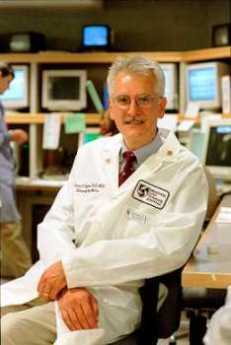
|
| Dr. Charles Czeisler |
The Institute for Experimental Psychiatry Research Foundation meets alternatively in Boston and Philadelphia, in recognition of its rather complicated historical relationship with Harvard and Penn. The Spring 2005 trustees meeting was held in Boston, with Dr. Charles Czeisler of the Brigham and Women's Hospital making a presentation of his work with sleepy resident physicians. Sleep is now a central focus of the work of the Institute, particularly the effect of lack of sleep on performance. Resident physicians are a group with lots of experience with sleep loss, so much that such experiences as residents are central imprinting in the lifelong brotherhood of the profession. The public tends to regard the torment of protracted craving for sleep as some kind of dangerous hazing inflicted on professional newcomers by sophomoric seniors. Every once in a while, someone gets hurt by these games. That seems to be a general public reaction. For the most part, by contrast, members of the profession who have themselves undergone the experience turn away silently from such unfeeling remarks. As the old contraceptive joke about the Pope has it, if you don't play the game, don't make the rules.
In the first place, it is wrong to suggest that resident physicians are somehow helpless victims of authority, abused slaves of somebody's profit motive, or warped masochists enduring the process in order to inflict it on someone else. Perhaps the example of my classmate Seibert is useful. As a freshman medical student, Seibert was so overwhelmed by the volume of facts he was expected to learn, that he decided to give up sleep entirely. Seibert, by the way, was no moron; he was an honors graduate of a very selective Ivy League university. And he actually did stop sleeping for more than two weeks until he collapsed and had to be stopped. This was his own choice, gamely adopted in spite of general ridicule. And to show that overachieving is not limited to physicians, there was my oriental patient, the daughter of the President of her country. She related that as a graduate student she did not go to bed for three years; during all that time, she sat at her desk, slapping her face to keep awake. What we are talking about here is a self-selected group of committed and dedicated people, perhaps overly shamed by the specter of failure.
The work of our Institute has helped document and understand the injurious effect of sleep loss on performance; no one can go very long without sleep before responses and vigilance begin to deteriorate. A great many vehicle accidents are caused by drowsy drivers; it is a concern that pilots of airplanes on long-distance flights are to some provable degree less competent to land the plane. Therefore, it is not completely surprising to find that interns on protracted duty do make 20% more errors in medication orders, and nearly 50% more diagnostic errors. It is jarring to discover a measurable increase in the number of intern auto accidents, particularly when driving home from work. Maybe we ought to pass a law about it.
Commiseration is one thing; proposals to interfere are quite another. For one thing, the time-honored protection against the harm of this problem is redundancy. The complex, fast-paced and dangerous environment of a hospital, like that of an airline cockpit, has very little tolerance for lack of vigilance. Our solution has been to do everything three times, with overlapping responsibilities and repeated opportunity for catching errors before they get through to the patient. Although the malpractice lawyer seeks to pin the whole blame on some person, particularly one who is covered by insurance, the reaction of doctors to adverse events is to presume that at least three people must have cooperated in letting it slip through. At night and on weekends, the reduced staff tends to weaken the defensive network. But by every assessment, the greatest threat to our protective screen of redundancy is cost control. Any manager of managed care can find duplication and overlap in ten minutes of searching for it in a hospital; redundancy is a big factor in the high cost of running a hospital. The law of decreasing returns will dictate that it becomes very expensive to eliminate the last one percent of errors. To state it in reverse: it is very tempting to save a bundle of money in a competitive world, by accepting only a small increase in the errors. Since it is a matter of opinion, physicians are grimly determined that it shall be physicians who strike that balance. Those who press for more punitive treatment of physicians in the matter of errors should reflect that it surely will convince physicians to flee the risk of responsibility for the decision of where to strike the balance.
If you bend metal repeatedly it will crack; if you stretch a rope too hard it will snap. These unfortunate events are not called errors, and it is improper to search for blame in them. The medical profession is aghast that the public does not seem to appreciate that average life expectancy has increased by thirty years in the past century. That's not ancient history; life expectancy has increased by three years in the past ten. A system that produces a result like that is entitled to a certain amount of tolerance for its errors if we must call them errors. In other environments, that's known as pushing the envelope. Anyone who thinks it's fun to stand on your feet for thirty-six consecutive hours -- hasn't tried it.
Surgeons are perhaps somewhat more conscious of the need to train young professionals to drive themselves beyond ordinary endurance. After all, if an operation is unexpectedly prolonged, the surgeon can't just quit, he must finish. Neurosurgeons, with their fourteen-hour procedures, are particularly vehement on the topic. But it is true of every physician, too. When the telephone rings in the middle of the night, will this young fellow haul himself out of bed, or will he tell the patient to take an aspirin and call again in the morning? Increasingly, we hear complaints from patients that other doctors didn't even take the trouble to examine them; the implication that we are somehow not like that is very flattering. Part of the training is forbearance, too. At three in the morning, it is very easy to feel sorry for yourself and to reflect that an administrator with four times your income is home in his nice warm bed. The fact is, that if the person who is up and on his feet doesn't do the job, no one will.

|
| Cadwalader |
Some incomprehension from bystanders must simply be endured with patience. Beyond that, it could be futile to seek a complete understanding. Quite recently, I was explaining to a young lady in a tailored suit who Thomas Cadwalader was. His portrait, beneath which we were standing, hangs in the great hall of the Pennsylvania Hospital. Although he died in 1789, Dr. Cadwalader is still famous for his remarkable, unfailing courtesy. A sailor in a tavern on Eighth Street once waved a gun and announced to the crowd he was going out the swinging doors to shoot the first man he met. The first man happened to be Dr. Cadwalader, who tipped his hat and said, "Good morning, sir." So, the sailor shot the second man he met.
The young lady in the tailored suit brightened up. "The moral of that story, " she said, "Is always wear a hat."
Medical Generation Gap

|
| Miriam Schaefer |
To understand the dynamics of the following medical anecdote, the reader should understand the thrust of Miriam's First Rule of Management. Miriam is my oldest daughter, with long experience managing many firms, large and small. Her rule is that when an employee starts misbehaving for no good reason, eliminate the position. Invariably, well almost invariably, an employee who starts acting out doesn't have enough work to do. If you are managing a large organization, you should also consider firing the supervisor of that person, on the grounds the supervisor should have noticed there was not enough work for the employee to do and was probably covering up.
My anecdote concerns a session at the 2006 annual meeting of the American College of Physicians, ostensibly devoted to the conflict between generations of doctors. It didn't take long before the meeting turned into an uproar about the new work rules which prohibit a resident physician from working more than 80 hours a week. That's supposed to protect patients against mistakes of sleepy doctors, although some suspect it is mainly an outgrowth of a gap between what they do and what they expected to do. From the time they entered high school, future doctors have been taught to expect workaholic employment conditions, and while more normal people haven't been taught that message, that's irrelevant. The situation is aggravated by the increased admission of women to the profession, who for their part have been taught to expect a breathless race between finishing their work and getting home to relieve the babysitter. Perhaps in time the newly invented specialty of "hospitalists" will get established and accepted, along with accident room work as another harrowing occupation which abruptly ends its day by the clock rather than the backlogs. At the moment the pioneers must overcome the suspicion, only partly fair, that Miriam's First Rule applies to them.
If not, that Rule clearly does apply to the youngsters who now must go home to spend quality time with their families, because they are not allowed to exceed the new work rules. At the ACP meeting, a dozen of us Civil War veterans were treated to an appalling amount of teenage mumbo jumbo apparently emanating from unsuspected warfare between Generation X and the Baby Boomers, their supervisors, mentors, and colleagues. All of us Civil War veterans held the private opinion that Baby Boomers were a little self-indulgent, but in the eyes of Gen Xers the boomers are workaholic fanatics, incapable of relaxing even for a moment in order to enjoy the life of the good, the true and the beautiful.
As we passed out of the room at the end of the session, one of the silent gentlemen with white hair came over to me. We didn't know each other, but we recognized the signs of a silently shared opinion. The old doctor leaned over to me and muttered, "They offer nothing, but they want everything." I smiled, and we parted. I guess I might have told him about Miriam's First Rule, but it would have taken too much explaining.
Medical Tort Reform (1)
The U.S. House of Representatives will soon consider a medical malpractice reform (limiting awards for pain and suffering to $250.000) which it adopted seven times in the last ten years. Following almost certain House passage, the proposal will then confront the Senate,
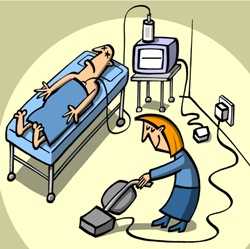
|
| cartoon malpractice |
where it has failed seven times. The politics of the two chambers are not chief concerns of this paper, which strongly advocates passage. The paper contends that unwise incentives for patients to bring suit are important causes of present difficulty, and reducing such incentives offers a comparatively simple opportunity to bring the complex issue to quick stability. Stability is essential before more sweeping changes can be examined. The collection of data in certain areas would reduce the scope for vituperation and ideology, another important step toward a solution. Full recognition must eventually be given to the intertwined complexity of industrial product liability, the McCarran Ferguson Act, hospital and corporate governance in general, the tort system, pass-through of Medicare and Medicaid overhead reimbursement to malpractice premiums, even universal health insurance. Some small step must begin such an interlocked rearrangement, and a cap on pain and suffering has the major advantage of being successfully tested by twenty-five years of experience in California and Indiana.
This paper makes no claim of identifying all the root causes or predicting all the calamitous consequences of inaction. Advocating passage of national laws to reduce plaintiff incentive to sue, it chiefly focuses on the chief arguments historically made against the present proposal, offers some comparatively novel insights in favor, and makes suggestions for collecting data to reduce the latitude for disagreement.
Congress will again take up malpractice tort reform (MICRA) in 2005. perhaps successfully. The 2004 outcome was close. Since the Republicans subsequently made electoral gains in both House and Senate, the leadership is considered likely to re-introduce the same bill and try to hammer it through. The bill's medical essence is to limit awards for "pain and suffering" to $250,000, contrasting strongly with recent escalating awards which have sometimes reached $100 million. Newcomers to the issue may be surprised that so much emphasis gets placed on this point, but thirty years of wrangling experiences in state legislatures have produced this reform alone with proven effectiveness. In the course and semi-jocular language of politics, "nothing helps the malpractice problem unless it involves on
The Blue Cross Discount (6)

|
| Blue Cross Blue Shield |
Since I've alluded to the two basic problems in health financing today, perhaps I need to explain them. What's known in hospital circles as the Blue Cross discount refers to the wide disparity between what the hospital will accept from an insurance company and what they will demand in payment from someone who has no insurance. It's often double the price. It's a tragedy that forty million Americans don't have health insurance, all right, because it costs them twice as much. It's a punishment for the terrible crime of not buying insurance, to call a spade a spade.
That sounds like a pretty easy problem to fix, doesn't it? Stop overcharging them, and half of the problem of the uninsured would go away.
Furthermore, most of the people who do have health insurance are effectively able to buy it at seventy cents on the dollar, because they don't pay income tax on the money that goes for "health benefits" which is to say health insurance premiums.
Taken together, most people thus pay seventy cents for health care which will cost uninsured people two dollars. Most people would suppose that we ought to give a break to some poor devil who can't afford insurance, but in fact, we skin him alive financially. It's impossible to name any other necessity of life that's treated this way, and it's hard to think of any other problem that would be so easy to solve -- just charge everybody the same amount. If you are really bighearted, charge poor people just a little less,
Now, I refuse to get drawn into a history of the origin of these egregious situations. It has to do with price controls during World War II and the fact that investment capital for the health system was impossible to raise during the depression of the 1930s. But it doesn't matter in the slightest how this came about. What matters is how to make it go away.
Health Care Rationing, American Style

|
| Hayek |
The 2006 annual scientific meeting of the American College of Physicians used six or eight auditoriums simultaneously over a three-day period, to accommodate the gratifying number of new advances in medical science. I wandered into one session devoted to pulmonary embolism because it affects a close member of my family. But every citizen ought to ponder the non-scientific message of this session. Indeed, the anti-scientific message.
It turns out that 1% of the relatives of patients with pulmonary embolism will test positive for inheriting a gene that promotes this often fatal disease. But the speaker, invited as a national authority to speak for the College, cautioned the audience that it would be wrong to test the relatives of their patients with pulmonary embolism for the possibility of running a significant risk of this disease themselves. Why so? We have a pretty good way of preventing this often-fatal disease, by giving blood-thinners, and blood thinners are getting better all the time. So, naturally, there were questions from the audience of doctors. Why in the world wouldn't you test people for this preventable condition?
With obvious discomfort, the speaker did a little tap-dancing in his answers; but here is the substance of it. There is a risk of complications from the therapy, of about 5% a year so you must choose carefully among those who have a positive test. If the individual tests positive but is not treated, he may develop an embolism and sue you for not having treated him. Even if he doesn't develop the condition, he will probably be stigmatized for life and find that health insurance is overpriced or unobtainable. If you treat everybody, you will cause problems more often than the disorder would. So, don't test. If you don't know about the problem, you can't get into trouble for acting in an ambiguous situation.
Personally, I doubt that. If the person has an embolism, a keen lawyer can ask if any relatives ever had the same thing, and if so, the other doctor can be sued for not testing the relatives, hence not discovering, and not preventing the present sad, sad, situation. I'd like to think the rest of the medical profession will join me in disregarding this preposterous advice, testing these families to identify the people who are at risk, and then treating them with the best method then available.
But, you know, in the present climate of managed care and lawsuits, I'm not so sure that's what will happen. Meanwhile, my own children are all going to be urged to go get themselves tested, whether the test is covered by insurance or not.
Health Savings Accounts
The legislation removes the hampering restrictions of the 1995 Law. What follows is a brief outline of the main features of the HSA/MSA clause in the 2003 law,

|
| U.S. Capital |
as published by the main authorizing committee, the House of Representatives, Committee on Ways and Means. From this point forward, more specifics of the program will probably be written by the Executive Branch and published in the Federal Register. The Ways and Means Committee will continue to exercise oversight authority, however, in conjunction with the Senate Finance Committee. As a consequence, statutory modifications of the program are likely to appear in future annual budget reconciliation acts, or else in any new Medicare amendments. The legislative route map becomes more understandable when it is recalled that Medicare itself is considered to be an amendment (Title XVIII) of the Social Security Act.
Committee on Ways and Means
Medicare Prescription Drugs, Improvement And Modernization Act of 2003
Health Savings Accounts (HSA's)
Lifetime savings for Health Care
Working under the age of 65 can accumulate tax-free savings for lifetime health can needs if they have qualified health plans.
A qualified health plan has a minimum deductible of $1,000 with $5,000 cap on out-of-pocket expenses for self-only policies. These amounts are doubled for family policies.
Preventive care services are not subject to the deductible.
Individuals can make pre-tax contributions of up to 100% of the health plan deductibles. The maximum annual contributions are $2,600 for individuals with self-only policies and $5,150 for families (indexed annually for inflation).
Pre-tax contributions can be made by individuals, their employers, and family members.
Individuals age 55-65 can make additional pre-tax "catch up" contributions of up to $1,000 annually (phased in).
Tax-free distributions are allowed for health care needs covered by the insurance policy. Tax-free distributions can also be made for the continuation coverage required by Federal law (i.e., COBRA), health insurance for the unemployed, and long-term care insurance.
The individual owns the account. The savings follow the individual from job to job and into retirement.
HSA savings can be drawn down to pay for retiree health care once an individuals reach Medicare eligibility age.
Catch-up contributions during peak savings years allow individuals to build a nest egg to pay for retiree health needs. Catch-up contributions allow a married couple to save an additional $2,000 annually (once fully phased in if both spouses are at least 55.
Tax-free distributions can be used to pay for retiree health insurance (with no minimum deductible requirements), Medicare expenses, prescriptions drugs, and long-term care services, among other retiree health care expenses.
Upon death, HSA ownership may be transferred to the spouse on a tax-free basis.
Contain rising medical costs- HSA's will encourage individuals to buy health plans that better suit their needs so that insurance kicks in only when it is truly needed. Moreover, individuals will make cost-conscious decisions if they are spending their own money rather than someone else's.
Tax-free asset accumulation- Contributions are pre-tax, earnings are tax-free, and distributions are tax-free if used to pay for qualified, medical expenses.
Portability- Assets belong to the individual; they can be carried from job to job and into retirement.
Benefits for Medicare beneficiaries- HSA's can be used during retirement to pay for retiree health care, Medicare expenses, and prescription drugs. HSA's will provide the most benefits to seniors who are unlikely to have employer-provided health care during retirement. During their peak saving years, individuals can make pre-tax catch-up contributions.
Chairman Bill Thomas Committee on Ways and Means 11/19/2003 12:56 PM
Financing a Research University

|
| Harvard |
Fifty years ago, only three American universities, Harvard, Yale and Princeton, were considered world-class. The benchmarks for them were Oxford and Cambridge Universities; both British universities had long history and great prestige. Making allowance for wartime disruption, it was also considered pretty classy to study at the Sorbonne, or Humboldt University in Berlin. Sweden, Vienna, Rome were right up there in prestige.

|
| Oxford |
By 2004, a London magazine was offering its view there were thirty American Universities better than anything in the European Community, in particular, Oxford and Cambridge. We'll pass over the Economist's anguished analysis of what's wrong in old Europe, and focus here on what American universities are doing right. They certainly do seem to be doing something right, but nevertheless, it's still possible to be uneasy about where they are going.

|
| Cambridge |
For example, the top three all have more than ten billion dollars apiece in their endowment funds, and thus each perpetually generates roughly half a billion annually in disposable income from passive sources. You can accomplish a lot of worthwhile academic things with that much money. Operating revenue like student tuition, fees, research grants, and royalties should support normal running expenses, so endowment income is available for new frontiers of learning, research, and social endeavor. These well-run institutions unquestionably do accomplish many innovative and important advances, to the point where it is simply trivial to point out a few areas of waste or misjudgment. Multiplying their annual discretionary funds by thirty offers an overwhelming force for good in the nation, and in the world.

|
| British |
The other twenty-seven premier research universities may not all have ten billion dollars apiece, but they have the Avis or we-try-harder motivation that may make up for it. The nation really does appreciate its worth. Applications for admission outnumber available places twenty to one, would be even greater if more people thought they had a chance to get in. Outstanding professors are in scant supply, commanding higher and higher salaries. In fact, a patient of mine who is a trust and estate lawyer tells me he gets a little uneasy about the growing number of university professors he sees with million dollar estates. A calm view would be that the nation recognizes the value of superior education, and is forcing the pace for a greater supply of it. Unless our economy experiences a disastrous decline, it is reasonable to expect a hundred universities to migrate up the quality chain in the next generation; most of those eligible for it are grimly determined to see it happen. China can make all the widgets it pleases, but that won't make them catch up with this champion competitor. The French can maybe make better wine, but unless they pep up their schools, they're going to have no shot at glory.
Whew. That's intentionally laying it on thick because American academic triumphalism has a darker side to give one pause. In the first place, the arrogance of it shows. Even the European aristocrats, formerly world experts in flaunted put-downs, are irritated; and red America is really sore at blue America. Sprinkling a few research universities into Arkansas and Idaho might relieve regional divisiveness somewhat, but lasting social peace can only derive from starting in the third grade of, say, North Philadelphia, Kensington, and Norristown. In economic downturns, the country would have big trouble financing universal, bottom up, academic excellence. The tragedy is that money isn't the main problem in the science classes of the thirty research universities we already have; an alarming number of those seats are filled with foreign-born students, not even to mention the honors students.
Secondly, the system is already under strain. The families of students are hard pressed by tuitions of fifty thousand dollars a year, and increasingly ready to complain about the inability, of classes of three hundred taught by non-tenured teachers, to justify to them such breath-taking fees. They may not understand educational financing, but they can count, and then multiply two numbers together. Faculty rewards favor research, not teaching, and teaching is what the students think they are paying for, their parents think they are sacrificing for. If what they are truly paying for are just credentials, they worry that affirmative action will cheapen the credentials. One clear sign of unease is the tendency of children from wealthy families to walk about the campus in torn overalls. This may be more than just a fad, it may be a sign they hope to hide from the university's system of redistributive taxation. Some people pay those high tuitions, but mostly tuitions are discounted for the eager family's ability to pay. Wearing blue jeans won't help, the universities demand to see the family's audited tax returns. In my presence, a university president remarked that the system was designed to extract the last dime from every student. The whole middle class is being asked to give until it hurts, for the unspoken goal of elevating a hundred more research universities to world class. Very few question the premise that unmatchable universities are the key to American world eminence. Quite a few, however, have anxiety that it may not work out for each individual. It may only be a lottery with slightly better odds.
Now, let's get to the research part of the research university. In the past ten years, American universities have collectively received six or seven billion in commercial patent royalties; the aggregate now runs appreciably more than a billion dollars a year and it's growing.
The normal arrangement is to give 20% of royalty income to the professor whose name is on the patent. Since most research is performed by large teams, it is possible to imagine considerable inequity and academic bad feeling in this system. In other walks of life, striving for a bigger share of two hundred million a year would cause differences of opinion about fairness. Here and there, you read articles by participants in this system who are concerned over the message it is sending to the students about personal values. Universities that began with a mission to educate the clergy are now seemingly overpraising the big payoffs.
Many business analysts feel that a successful corporation needs to spend 10% of its revenues on research and development. Behind that is a realization that prices and profit margins are largest for new inventions, steadily declining as the new invention attracts competition and eventually becomes a mere commodity. The scientific term entropy is a perfect description of the way world economies seemingly work, like clocks gradually winding down. So businessmen get rid of old products and look for new ones, and the universities are the source of most new ideas and products. Put every last cent into R & D for new products, while the developing countries grind out widgets. If we eventually graduate hundreds of thousands of Americans from unmatchably excellent research universities, the outcome will take care of itself. Even flying airplanes into our tall buildings can't make much difference in this academic arms race. It's essentially how Ronald Reagan defeated the Soviet Union, and it's discouragingly difficult to argue it is totally wrong.
However, you can imagine ways that it might all fall apart. The source of at least half the capital now pouring into the research universities comes from the federal government, particularly the National Institutes of Health, the National Science Foundation and the Department of Defense. It only takes fifty-one votes in the U.S. Senate to change that suddenly, for reasons of national defense, to defend the value of the dollar, to combat inflation, or lots of other reasons. Even now, universities often face annual crises at the end of a funding cycle, when projects have been awarded, people hired, but funding is delayed for uncertain periods of time because of distant political wrangles within the budget process.
That's known as a cash flow problem, and even it is trivial compared with what would happen if federal research funding were delayed a full year. Just look at any university and see all the big tall buildings. They have largely been built to house research activity, and the university would have big difficulty selling them if they were empty. They've usually been paid for with mortgages, and it costs a lot of money to heat, air condition, clean and repair them. Just cut off the cash flow long enough, and you will see how risky it was to get into the research arms race.
Flexner Report, Revisited
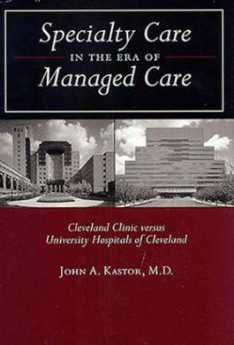
|
| Specialty Care In The Era Of Managed Care |
Book Review
Specialty Care In The Era Of Managed Care
Cleveland Clinic
versus
University Hospitals of Cleveland
John A. Kastor, M.D.
0-8018-8174-9
The Johns Hopkins University Press
Abraham Flexner's 1910 Report practically canonized the notion that medical schools must be owned by universities. Forty years later, Dwight Eisenhower firmly disagreed. Asked why ever would he give up the pleasant life of Columbia University president to get into the nastiness of national politics, he replied, "The White House doesn't run a medical school." During the same era, Secretary of State Dean Acheson and Senator Robert Taft, political enemies but personal friends, were riding to New Haven together to a Yale trustee meeting. The two agreed it was unfair for 40% of university budget to be spent on 1% of the student body, and decided Yale should get rid of its medical school. Their subsequent motion failed by only one vote at the meeting. And as a final Flexner footnote, Princeton University which shrewdly never owned a medical school, is now nonetheless in the news over the central underlying discordance -- managing huge sums which, either by contract or donor restriction, are inflexibly assigned to a single department, thus substituting the donor's priorities for those of the University president. Medical school ownership of teaching hospitals raises the same issue except in reverse. It is politically impossible to treat an affiliate as a cash cow without learning the harsh reality of the Golden Rule: the affiliate with the gold will promptly remake the rules.
Understanding these issues but seldom emphasizing them, John A. Kastor has done us all a great favor by studying and publishing the unseemly disorders which result, in many cities and institutions. His particular focus in this book is on Cleveland, where all that matters medically is the prospering Cleveland Clinic and its struggling rival, Case Western Reserve. The book is mainly focused on a particular question: under managed care, should teaching hospitals adopt the Cleveland Clinic's style and organization, in order to prosper as they do? In the end, he cannot quite bring himself to recommend it. Essentially, the Clinic is run by doctors, for doctors. The clinic pays salaries, but (so far) bills fee-for-service. The over-reimbursed procedural specialties such as surgery subsidize the under-reimbursed cognitive specialties (prompting East Coast colleagues to sneer at "organized fee-splitting".) Cleveland's Clinic, like all group practices, must devise strategies to a)induce acquiescence to the subsidy of internists by surgeons, b)discourage physicians from starting competitive practices in the neighborhood or c)turning their salaried incentive into an instant 40-hour week. Not everyone will submit to what is between the lines, most notably at the Clinic's Florida satellite. But since the alternative is to hire non-physicians with concealed animosities to doctors to run hospitals and medical schools, all physicians who actually treat patients must give the physician-run group practice model some thought based on experience with its alternative.
We all have an unfortunate tendency to assume that weakness of character is the main cause of the executive misbehavior so widely observable in all corporate environments. In the medical world, a much more powerful force is generated by shifting quirks of reimbursement. Once the pecking order is established between hospital and school, medical school and university, it gets violently upended by the underdog suddenly getting riches from the Senate Finance Committee, then upended again by Ways and Means a few years later. Or bureaucrats in Rockville, in Baltimore, or the Executive Office Building. Eisenhower was wrong, the White House does run medical schools and hospitals when they would very likely be better run by physicians. In fact, Flexner's offhand interposition of the University into this dogfight seems a little quaint. Just to mention the indirect residency reimbursement program, the institutional research overhead allowance, the old cost-plus reimbursement of hospitals, the institutional patent revisions, is to start a list which can get to be quite long. In most of these cases, an institutional component which needed to be subsidized in the past has now become prosperous and is asked to return the subsidy. The chief executive is then caught between duty to his institution, the threat of investigation if funds shifting is suspected, and his own sense of fairness. That these upheavals are so frequently pacified without serious harm to the patients, is a credit too seldom given.
Dr. Kastor's writing is somewhat hampered by a need to footnote, document and defend everything he says. Nevertheless, the book will be read by physicians like a novel with a great many villains. It's encouraged reading. One hopes that the next book in the Kastor series will examine the Florida satellite clinics of the Cleveland Clinic and of the Mayo Clinic, one making money and the other losing money. Maybe some basic issues of an effective medical organization can be resolved by making different comparisons.
But don't expect permanent axioms to emerge; Medicare Risk contracts are coming. Under capitated systems, administrative incentives are slanted to discourage expense, especially expensive surgical procedures. Perhaps group practices will soon face a need to have their internists subsidize their surgeons, reversing the traditional arrangement. The threat to collegiality, so evident in this book, is destined to continue.
Friends Lifecare at Home
Over thirty Quaker retirement villages scatter through America, more than twenty in the suburbs of Philadelphia -- "under the care of the Yearly Meeting", as their expression has it. But for some people, community living seems unattractive. It does not speak to their condition.
For one thing, it may not be affordable.

|
| Friends Lifecare |
Or the style of may seem too fancy, or too plain, for some tastes regardless of cost. The increasing emotional rigidity of growing older is a factor; by the time people get to be seventy-five, they had better make this decision or forget it. Plenty of people are hale and hearty at ninety, but they establish pretty firm ideas about the sort of person they want for neighbors while they are still in the workforce. Quite often it's just a habit, people have lived in their home for several generations and cannot imagine another neighborhood, lifestyle, or environment. This is home, and they intend to die there.
So, to address this need, or market, a group of Quakers conceived of a retirement village without walls. Live in your own home and someone will come to oversee things, will know what to do if there is an emergency, and may eventually make the decision for you that you absolutely must go somewhere else. All of this is wrapped within an insurance vehicle, to recognize the fixed incomes of retired people, the inevitability of terminal illnesses, and the occasional risk of monumental medical expenses. At present, about 1600 people in Philadelphia are enrolled in the unique plan of Friends Lifecare at Home, making it one of the largest retirement communities in the country. The organization receives universal praise for its imaginative responses, as well as the dependability and high quality of the people it sends out to the homes of subscribers. Friends Lifecare is a pioneer, and it is gradually weeding out the ideas that didn't work and adding new features that were not originally contemplated. One of its greatest challenges is the need to adapt to unexpected and uncontrollable changes in the Medicare program. Slashes in the Medicare program could bankrupt Friends Lifecare, and even sudden windfalls like the Medicare Drug Benefit create management problems. There can be no doubt that one element of trust exists for which there is no substitute; Philadelphians know that the invisible support of the community and its Quaker core is behind them. If anyone can possibly preserve a moral commitment to the elderly, it will be the Quakers.
Ultimately, the commitment is not so much to 1600 subscribers as to the notion of finding out what works. Life expectancy has extended by three additional years, during the past ten; that's a joy, but it's a problem to finance. The optimum size of the organization is also an unsettled question. Although this program is relatively large by comparison with individual retirement villages, it may not be large enough to have spare capacity to cope with influenza epidemics or record-breaking spells of bad weather. Since it's the only one of its kind, it is vexed by the popularity in ever-widening geographic areas. It must grow to some reasonable size in one area before it can spread its resources to another. By the same reasoning, it must have a reasonable number of prosperous subscribers if it is to accept even a limited number of poor ones.
The idea of creating a seamless partnership with the residential-type retirement villages is certainly attractive, but Friends Lifecare must be careful to avoid becoming too much of a life raft for other people's problems. When the resale price of residential housing rises in a housing bubble, people wish to cling to a rising investment. During the same economic period, the entry and rental price of residential villages also rise. With a great many uncertainties that are specific to this pioneering effort, it is hard to know what policies to develop to insulate the lifecare environment from speculation in the mortgage and housing markets. Or, right now, high-rise apartment development. All of this creates a need for clear minds in the governance, determined to see and acknowledge difficult reality. If anyone can do it, Quakers can.
A New Food and Drug Category

|
| Nervous System |
An editorial in the April 7, 2006 Wall Street Journal rouses a proposal germinating in my mind for twenty years, a new compassionate status of pharmaceutical regulation for dangerous but effective new therapeutic agents, not presently provided for in law.
The editorial concerned a new drug treatment for multiple sclerosis, a crippling and usually ultimately fatal condition which destroys the nervous system. In a hearing of the tests of this new drug, we hear numbers like 85% total remission. Unfortunately, we also hear of four patients who died, quite possibly from the treatment. From that point on, you could write the reports from memory. Patients come forward, declaring their willingness to run any risk to get the drug; politicians are sympathetic. The Food and Drug Administration feels forced to withhold the drug from the market until the situation is clarified; other politicians are sympathetic. We are reminded of thalidomide, which was luckily withheld from the American market until the German experience showed that pregnant women who took thalidomide could have babies without arms or legs. This lucky illustration of the value of bureaucratic procrastination gave Senator Kefauver the strength to push through an amendment bearing his name, demanding proof of efficacy, something quite irrelevant to the safety of thalidomide. Seldom mentioned is the fact that thalidomide has since proved to be quite useful for the bone cancer called Multiple Myeloma; this value took a very long time to surface, under the circumstances. The efficacy rule accomplished the purpose, however, by delaying all drug approvals, unfortunately also shortening the time left for patent coverage, and vastly increasing the cost of drugs by shortening the time on a patent to recover development costs. After thirty years of hearing the same arias re-echoing about one drug introduction after another, it begins to look unlikely that Congress will ever be able to stand the political heat which would be generated by a serious attempt to fix this problem. But surely that can't be allowed to continue forever.
Taking the multiple sclerosis treatment as an example, the patients want the drug, and their doctors want to use the drug but they don't want to be sued or prosecuted. It's almost certain that most of these patients would sign anything, accept any risk, even agree to a shortened life expectancy in return for an 85% chance of stopping the disease in its tracks. All the doctors want is to be held harmless by the courts for exercising reasonable care under the circumstances. The same is probably true in a political sense, for the FDA and Congress, who surely would be satisfied to have the doctors take the blame for any problems encountered. The drug companies want to preserve their patent protection, surely that can be accommodated. Perhaps they should be asked to contribute to a fund for the victims of unforeseen accidents; they would probably agree. What would satisfy the trial bar is less certain; they should be asked to stipulate something. As a matter of fact, anyone at all who has qualms about such a system of special defined exemptions should be asked to come forward with serious suggestions. There would then ensue a lengthy and ultimately tedious debate about details.
This would all take some time; at the end of it, someone would have to make some arbitrary decisions. But at least we could expect more progress than we have seen in the last thirty years of indecision.
Cost of Medical Care
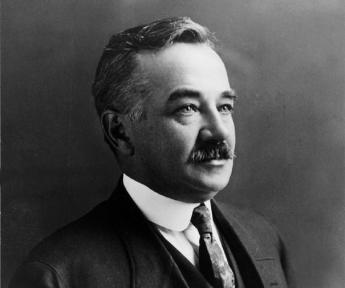
|
| Milton S. Hershey |
On several occasions, Richard A. Kern M.D. (1891-1982) told the story of his part in the founding of the Hershey School of Medicine. Dick Kern was a distinguished professor of Medicine at Temple University, well known for his contributions in the field of asthma and allergy, a past president of the College of Physicians of Philadelphia, and a former Grand Master of Pennsylvania Freemasonry. The Milton S. Hershey School was considering the creation of a medical school and needed advice.
Milton Hershey had been a strict Mennonite, which is closely related to Quakerism, and had accumulated a huge fortune making chocolate candy. He left generous trusts to endow a theater and various other public services in the town of Hershey, but his ownership shares in the chocolate company had been left to the Hershey School for orphans. The value of the shares had far outgrown the ability of the school to employ them usefully, and they were considering a medical school. In 1963, as at present, everybody else was wondering how to get out from under the crushing cost of running a medical school. The sudden inquiry from a donor both willing and able to start a whole new medical school from scratch was an opportunity not likely to appear again soon. Kern carefully considered the options, including the danger of scaring off the naive potential donors with too high a price. Finally, he screwed up his courage and suggested a price to the trustees, of fifty million. The prompt answer was, done, you've got your medical school.
In due course, Kern found himself on the platform at the inaugural ceremonies of the school, sitting next to the guest of honor, that man who had made such an instant decision. Chatting amiably, Kern mentioned that he had always wondered how high the Hershey Foundation would have been willing to go. The answer was just as prompt as the original one. "Hundred-twenty."
The American Health Non-system

|
| Dr. Jock Murray |
Dr. Jock Murray has recently been Chairman of the American College of Physicians. He is also a Canadian. Recently, he was invited to address the College of Physicians of Philadelphia on an evaluation of the lessons to be learned from comparing the health systems of the two neighboring nations. It was an excellent, fair, and well-balanced address. The man who introduced him referred jokingly to the American non-system and Dr. Murray emphasized two epigrams about national systems in general. No nation on earth can afford to fill all of the health demands of all its people. So, all nations confront the three main demands, to deliver everything, to deliver it to everyone, and to do so immediately (ie without waiting lists). Fulfilling any two of these three demands is possible, but to deliver all three is impossible. Comparison of health systems in various countries amounts to identifying which two of the three they have chosen to have, which one they choose to surrender. I hope and believe Dr. Murray would mostly agree to this caricature of his remarks.
As a member of his audience, it does seem to be fair to acknowledge we have a non-system, and probably even fair to go further and observe we fundamentally resist those irksome constraints implicit in having a planned system. No organized system, and proud of it. But we do have something else. Let's call it a vision.
Without formally stating it, or even widely acknowledging it, Americans seem to have embraced a dream that we can indeed have everything for everybody right away. Yes, we can. The method available is to gamble that research can eliminate the disease. We hope, although we know it is not certain, that cancer, schizophrenia and Alzheimer's disease will reduce the cost of care. Our model exists in Rheumatic Fever and poliomyelitis, for which there are essentially no remaining treatment costs. We know that everyone ultimately dies of something; we assume we are already paying everybody's terminal costs. Eliminating diseases postpones terminal costs, but surely does not add to them.
We have knowingly and recklessly embarked on a program of pouring huge amounts of money into medical research. I believe the public mostly suspects that much of our present high cost of health insurance eventually finds its way into supporting research, and the public mostly acquiesces in whatever cost-shifting is involved. The people who devote their lives to research in turn vaguely recognize that we might reach a point where the country cannot afford this gamble any longer, and they could have half-wasted a career. We all vaguely understand it's a gamble; major elimination of disease might not be just over the horizon and might lead us on to indefinite postponement of a foolish dream.
But those are the chances you take; we seem resolved to take them. We are going to give it a go. If we can, we are going to spend whatever it takes to give everything to everybody, right away. We are going to eliminate diseases, on the unproven but plausible assumption that doing so will eventually bring costs down.
Employer-based Health Insurance: End of the Trail?
 America's health care crisis may well be solved by curing all disease 
|
| Dr. Fisher |
America seems determined to invest whatever it may cost to eliminate diseases through medical research. It's pretty hard to know which diseases will experience a miracle cure, and how soon. So it's difficult to make major changes in the system in anticipation of what we all hope for. But it's not so hard to predict what will happen if we are successful.
Health insurance will progressively seem less necessary, and that will prove particularly true for young and middle-aged people. Since our present system of health insurance is largely based on employer-based groups, employers can be expected to become particularly restless about paying for it. Long before all diseases of working people have been completely eliminated, some clumsy political intervention could well cause a stampede among employers -- for the exits.
Even if everyone in the unions and in government is circumspect about alarming the mullets, steady erosion of disease costs among workers will lead to a steady migration of costs to retirees. For practical purposes, that raises the possibility that essentially all medical costs will become the responsibility of Medicare. Since it is universally agreed that demographics will make Medicare expenses unbearable for the national budget in ten or fifteen years, a shift of even more expenses toward the retiree group would be even harder to deal with. It's pretty hard to wish for some particular solution to a problem, when no one has even made a plausible suggestion about it.
So let's focus on the problem which is most likely coming first. Employer-based health insurance, and even health insurance, in general, may well be a thing of the past -- reasonably soon. The main component of it which will not be eliminated is the cost of obstetrics, the cost of perpetuating the human race. The charges being made for this normal and essential process are so burdened with liability risks that it is tempting to blame them all on lawyers. Cost-shifting to other activities and other age groups, however, is also pretty likely. If the concentration of overhead costs on obstetrics goes beyond a certain point, however, I would predict we will see a migration of obstetrics out of the general hospital environment into specialized birthing centers. That's not entirely desirable, because all specialty care is safer when conducted within reach of the whole range of supporting specialties. But if the financial pressure gets great enough, we will surely see a migration back to the specialty hospitals so common in the early 20th Century, then abandoned in the middle of the same century.
Worker's Compensation is another carve-out which will relieve central anxiety of employers, and hence hasten their indifference to general health insurance for their employees. And scandals in the health insurance industry are just going to accelerate the dissolution of support which is inherent in medical progress. Anyone who reads the papers carefully can name at least three billionaires among the ranks of health insurance CEOs.
The pace of coming medical progress is hard to predict, so it is daunting to propose a solution to the problems it will create. That includes proposals which many people would like to advance, like universal health coverage. Patchwork makeshift for uninsured people seems timid and defective. But grandiose proposals for fundamental reform of the whole system are simply foolhardy, at a time when health insurance may well become an obsolete concept, and far greater problems could be made much worse.
House that Love Built: Ronald McDonald of Philadelphia
Kim Hill had the misfortune to develop leukemia, but the great luck to have Fred Hill of the Philadelphia Eagles football team for a father. Driven by gratitude for the treatment at St. Christopher's Hospital for Children

|
| Audrey Evans |
Fred demanded to be told what he could do and was referred to Dr. Audrey Evans. This world-famous pediatric oncologist was well known for her philanthropic activities and had frequently expressed the need for a temporary residence for families of children needing protracted medical treatments. Young children have young parents, whose savings are soon exhausted by travel, hotel and other non-insured costs related to a seriously sick child. The Hills had just been through such an experience and grasped the problem immediately, adding to it the discomfort and loneliness of families in such a situation. Fred Hill quickly enlisted the enthusiastic support of the whole professional football organization, and Jim Murray the Eagles' general manager recruited Don Tuckerman from their advertising agency, who got to Ed Rensi, the regional manager of McDonald's. Together, they got the project financed and started with a seven-bed facility near Children's Hospital of Philadelphia.

|
| Fred Hall |
In 25 years, the Philadelphia Ronald McDonald House has grown to a capacity of 44 families, in a century-old mansion at 39th and Chestnut Streets filled with Mercer tiles and the like. The operation uses eighteen volunteers at all times, runs two jitney buses, and is one huge teeming family home for people confronting a common issue, supporting each other through a wrenching emotional experience. Although it actually costs about $65 a day per family, the charge is $15 and over half of the clients cannot afford even that. Although an effort is made to have family cooking, the McDonald's restaurant chain supplies 20% of the budget along with generous help with exigencies and in-kind assistance with such things as clowns for the entertainment program, birthdays and the like. Although McDonalds's is probably the world's premier franchising corporation, every one of the 300 worldwide Ronald McDonald Houses is an independent local organization, run without a central headquarters or any sort of standards-setting and the like. Every one of the other 299 Houses got the idea from Philadelphia but proceeds in its own way. Philadelphia created it, but Philadelphia does not own the idea.
In this connection, it is probably worth reflecting on the history of this topic. When Benjamin Franklin and Dr. Thomas Bond started the Pennsylvania Hospital in 1751 at Eighth and Spruce Streets, it was the custom to be diagnosed, treated, be born and to die in your own house. The unique perception behind the nation's first hospital was that poor people generally did not have home facilities that were adequate to support home care. In Franklin's own handwriting the purpose of the Pennsylvania Hospital was stated to be "for the sick poor, and if there is room, for those who can pay." It was understood that poor sick people needed a place to take care of them, not merely for their surgery and overwhelming illness,
<but for convalescence and rehabilitation as well. Two centuries later, in the first thrill of founding the Medicare and Medicaid programs, it was imagined that things would remain exactly the same, only paid for by the Government. But after four or five years, it became abundantly clear that it was far too expensive to use hospitals in that way. The very act of federally paying for the program undermined its volunteer spirit, raised its mandated standards, and made it financially unsustainable. And so, although the 1965 Amendments to the Social Security Act insisted, and still pretend, that no change was to be made to the delivery of care, the delivery of care simply had to be changed. Not only was domiciliary and custodial care to be excluded, but heroic efforts were to be made to reduce the length of stay in the hospital to what would once have been regarded as special intensive care. In effect, if a type of service could normally be handled at home by non-indigent people, it was to be prohibited for everybody. Since the cost of care in hospital has continued to escalate far in excess of the cost of living, it seems unlikely we will ever go back to the days of rest and in-hospital recuperation.
So, just as Dr. Bond recognized the problem and went to Ben Franklin to handle the philanthropy, Dr. Evans had the idea and Fred Hill made it work. Around the Ronald McDonald house, the idea is frequently heard expressed that every hospital needs such a place nearby, for people of all ages. Perhaps that is workable, but it offhand seems more likely that Retirement Villages, so-called CCRC, will be called on to supply this badly needed service, at least for senior citizens. And that what we now call hospitals will evolve into the scientific "focused factories" so popular in the minds at the Harvard Business School.
"New" Health Care Reform, 1965
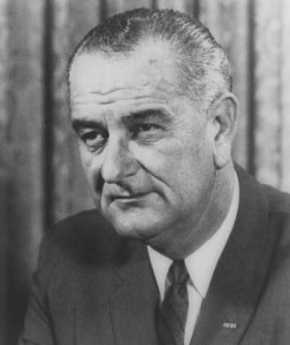
|
| Lyndon Johnson |
In 1965, Lyndon Johnson caused the enactment of two amendments to the Social Security Act, Titles 18 and 19. Title 18 is now called Medicare (for the elderly), and Title 19 is called Medicaid (for poor people). These two laws were cobbled together as negotiated compromises; the history of this contraption no longer concerns us. The outcome is that Congress created a Federal program for the elderly, and a state-administered program for the poor, partly financed by the states but mostly financed by federal taxes. The states howl that Medicaid is an unfunded mandate, and the Federal bureaucracy snarls that the states are mismanaging someone else's money. The welfare patients are bitter about second-class treatment, and doctors have as little to do with this system as possible. The focus of this article, however, is on the harmful effect of Medicaid on hospitals. Of all the stakeholders affected by Medicaid, the hospitals have historically been the best treated. Nevertheless, it has brought them to the brink of ruin, most of them acknowledge it, and matters are so hopelessly snarled that it is time to call for a transfer of the medical components of Medicaid to Medicare. In plain language, that means replacing state administration with federal Medicare management.
It may seem peculiar to call for extracting the medical components from a medical program. Forty years of creeping modifications in fifty different state directions have resulted in many state Medicaid programs spending more on nursing homes, home care, and various educational programs -- than on the activities of doctors and hospitals as originally intended. After forty years, this creeping mandate shows no sign of abating. It may never abate, but certain parts of it could rather easily be transferred to federal Medicare program, leaving the innovative fringes to fight their own battles with state legislatures, arguing those merits independently of this issue.
From the hospital point of view, Medicaid pays substantially (20-40%) less than the costs it claims to cover. The chiseling is worse in some states than others, but it is hard to find a single state Medicaid program which clearly pays its costs in full. Medicare is pretty tight-fisted, too, but at least a majority of knowledgeable insiders would admit it comes pretty close to paying its audited costs. Everybody else pays more than costs, but for this discussion that is irrelevant. Government as a whole is not paying its fair share, the state-administered portion is responsible, and there was never any non-political justification for having two programs. So, combine them. Other components of Medicaid, however worthy in intent or effect, are the responsibility of the various states which created them. When the states have got non-hospital, non-doctor issues carved out and audited, the merits of federal funding can be examined.
Two other features of the Medicaid mess can be mentioned, so long as they are not allowed to befuddle the main message of program consolidation. In general, the proportion of elderly or poor clients in rural hospitals does not materially differ from the proportion of such clients in urban hospitals. There is institutional variation, of course, but the principal distinguishing feature is that small rural hospital is necessarily semi-monopolies within fifty-mile districts, whereas urban hospitals face competition more directly. State governments, therefore, are unable to impose discounts on rural hospitals with the same leverage and severity. Seeing this, urban hospitals have often applied political pressure on the legislature to extend comparable relief to them. Since local labor and living costs are lower in rural areas, an excuse is created to word regulations and state laws in a way which recognizes parity in the ratio of audited costs to charges rather than the charges or costs themselves. Quite often, hospital accountants can outwit legislatures in these obscurities, leading to rather obscenely high list prices for hospital services, to shift the ratio. Although it has the temporary advantage of further obscuring public market prices for such services, it constitutes a serious injury to uninsured patients. Other persons, who might perceive no personal need for insurance, are driven to buy it in order to protect themselves from gouging.
Medicare itself is certainly not perfect. The largest remaining issue confounding hospital charges can be traced back to weaknesses of a 1983 Medicare law, the Budget Reconciliation Act. Reimbursement legislation traditionally overpays initially, with every intention of paring prices down later. The providers, hardened to this maneuver, try to stonewall all subsequent amendments as long as they can. In this case, the overpayments have persisted so long they have become basic assumptions, triggering internal re-adjustments which make resolution still more difficult. A number of hospitals have been severely fined for violating the spirit of this law, however close they may come to obey the letter of it. On the other hand, other courts have held that a situation which has been allowed to persist so long can be deemed to be settled law. The result is a predicament which is quite unnecessary, and might be rather readily corrected.
But let's not wander too far from the basic proposal. The corresponding (doctor and hospital) portions of Medicaid should be consolidated into Medicare, with remaining issues settled independently. Consolidating two government programs may not quite be the "single payer" concept that others had in mind, but it resolves most of the legitimate problems which provoked that mysterious slogan.
Illicit Drugs are Eliminated in Philadelphia
It seems fair to say that America is nearly desperate to find a successful way to eliminate the illegal narcotic trade. We've had a war on drugs, which seems to have three components, all failures. We have an occupying army in Afghanistan where most heroin comes from. We've sprayed weed killers on Bolivia, Colombia, Mexico, and found various other ways to assist local narcotic agents in their efforts to break up the planting of cocaine in Latin America. We've got high-speed patrol boats and helicopter patrols around southern Florida. Spies of all sorts have been hired to infiltrate the distribution channels. We've spent other tons of money educating school children that experiments with chemical recreation are risky, immoral, dumb, whatever. Sly, naughty allusions to drugs with cute code names have been pretty well driven off the television, night club acts, and even glitzy cocktail parties in the advertising business. Ronald Reagan had a simple solution --"Lock 'em up" which led to the passage of national law, leap-frogging the trials of drug offenses ahead of all other criminal offenses. The consequence was that prisons filled up and overcrowded conditions became a scandal. It may cost more to send someone to jail than to send them to Harvard, but the situation seemed to require us to ignore the cost, get them off the street, bring this problem to an end. If any of this work, or if all of it collectively worked, it didn't work very well. This is a very big problem that seems to defy solution.
So, one of the desperate ideas put forward has been to decriminalize drugs. That is, stop making their sale and use illegal. Abundant drugs would become cheap, cheap prices would eliminate the drug dealers' profit, and lack of supply of pushers would cause the supply to dry up. That is, no one would bring the heroin from Afghanistan, or the cocaine from Bolivia -- because there was so much of it around that the profit disappeared. Wait a minute. Did you just say that no one would import expensive narcotic because we would already have so much cheap narcotic? Somehow, it isn't persuasive that decriminalizing drugs would eliminate addiction. So, what other methods can claim proven success?
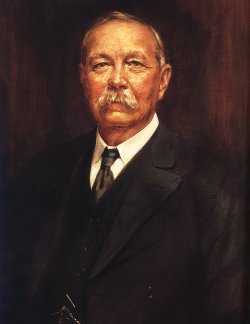
|
| Conan Doyle |
Let's try Philadelphia's system, by which I mean Philadelphia from 1940 to 1960. I graduated from medical school in 1948, filled with instruction about how to recognize the signs of drug addiction, how to detoxify, what precautions you ought to take to keep the student nurses from stealing the ward morphine supply, how carefully you had to monitor the pharmacy and anesthesia departments. Our older instructors were full of anecdotes about how clever the addicts were in fooling the doctor, how they themselves had been tricked or almost tricked, medical friends they knew who got hooked. Bad business, and it's important that every new innocent doctor is warned about how prevalent and how deceptive it was. Just read detective novels by Conan Doyle, who was a physician, addict, or De Quincey confessing to being an opium eater, or Coleridge writing Kubla Khan while in a drug stupor.
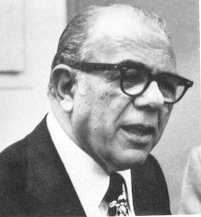
|
| Angelo Bruno |
So, my teaching and mentoring prepared me to believe that narcotic addiction was rampant before 1940. But when I came to Philadelphia I absolutely never encountered any of it, or at least until about 1970 when the Beatles and the Flower Children of California made it a deliciously tempting adventure. And I spent most mornings during that period doing teaching and charity work at Philadelphia General Hospital for thousands of indigents. If drug addiction had been anywhere in the city, it seems to me it would have been at PGH. We had thousands of cases of alcoholism, of tuberculosis, of syphilis in all its forms, suicides, homicides, bullet wounds, a prison ward full of manacled prisoners. But no drugs, nossir. It was a nice situation, and after a little while, you stop wondering about dogs that don't bark, and drug addicts that don't come in the accident room door. But a couple of decades later, when we had lines of heroin addicts waiting for their treatment, it all came back to us that we had experienced a remarkable absence of what was now quite common again. It had apparently been prevalent, it disappeared for twenty years, and then it came back. It now seems quite evident that we were enjoying a two-decade drug holiday, but what isn't so clear is what caused it. Whatever could have caused this remarkable temporary disappearance of illicit drugs?
Well, I don't know; and when you say that, you invite everybody to make some wild conjecture. So let me make my own well-ruminated guess, first. It seems worth investigating whether Angelo Bruno, the head of the mob, did it. It is a widely-held belief that Bruno hated the narcotics trade, and issued orders that there was to be none of it in his territory. It's quite possible that this was a purely business decision since there was plenty of money to be made from bootlegging and loan-sharking, whereas the narcotics business got you a lot of unwelcome heat from the police that would interfere with your profitability. By that reasoning, perhaps the war on drugs did have a beneficial effect, but it operated indirectly on the mob boss. Who was in a position to know what was going on in his territory, who was responsible, and what methods might be effective in discouraging the trade. But that explanation assumes the worst possible motives on Bruno's part.
Let's at least consider the possibility that Bruno had a large streak of decency in him, and really didn't like the narcotics racket even if it cost his organization money to get rid of it. And got his head blown off when greedier folk decided to eliminate this obstacle to their prosperity.
So, by that analysis, you have the Philadelphia System for a drug-free city. A system of proven effectiveness, when every other proposal has failed. Just pass the word that nobody will bother you in your loan-sharking and bootlegging, just so the distribution of illegal drugs stops completely. How you accomplish this is up to you.
Insuring the Uninsured is Not Entirely a Health Issue
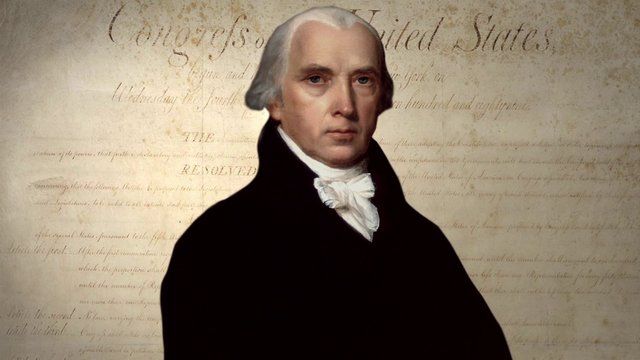
|
| James Madison |
shrewdly observed that people could and would restrain state taxation by moving to a neighboring state. The founding fathers never contemplated health insurance or Medicaid, of course, but the same principle applies there in reverse. If one state gets too generous with health and welfare benefits, people in neighboring states will nowadays hear of it and get on a bus to relocate advantageously. A flood of new low-income citizens may or may not be what a particular state wants, depending on local economic conditions.
For example during the great depression of the 1930s,

|
| The Great Depression |
Unemployment was so widespread that no state dared attract still more of it with generous welfare benefits. On the other hand, during the recovery period that followed World War II, the industrial northern states definitely did attract cheap labor from the southern states, using better health care, freely available, along with better unemployment benefits. In each case, employers alternate between wanting cheap labor or low taxes, while labor representatives relax or toughen their resistance to the cheap competition. Politicians are always looking for the argument that carries the most votes. If you want to understand the persistence of employer-based health insurance alongside unobtainable health insurance for others, look into this trio of motivations.
While it's true state legislatures must tend to the infrastructure, crime conditions and education, they can in the main be regarded as debating societies between employers and labor. There is some, but not much, the difference between Republicans and Democrats on the Medicaid issue. A Democratic Governor will welcome an influx of low-income voters who will normally vote for his party, but labor unions will soon remind him that enough is enough. A Republican Governor will gladly supply cheap labor for the state's employers until rising taxes bring an end to his support. Since the financial stability of the local hospital can be badly jarred by the instability of Medicaid payments, doctors soon get annoyed with the misalignment between state motives and the welfare of their patients. It is not much of an exaggeration, that state coffers might be overflowing with the surplus, but the budget of Medicaid will not rise a penny if it would attract poverty migrants from neighboring states during a period of high unemployment.
The obvious solution is a federal one, imposing uniform standards. But think that over a little before you jump at it. If the federal government pays all of Medicaid costs, it is going to want to administer the program. All states resist that idea, more so if local and federal political domination is in conflict. Small states will universally be fearful of being overwhelmed by large neighbors, particularly when they have achieved advantageous niches. The disastrous condition of the auto industry might persuade Michigan to agree, but Tennessee and other states with Japanese car plants might disagree. As you get close to the border of large states, hospitals near the border can often attract many patients from the other state; strange political bedfellows can link arms in Congress when you might not expect it.
None of this, absolutely none of it, has to do directly with medical care. But the quality of health care is strongly affected, and doctors are sick of hearing about poor sick folks when the real issue is labor availability. The voice is Jacob's voice, but the hand -- is the hand of Esau.
What Good Did Medicare Do?

|
| Amy Finklestein |
An article in the Wall Street Journal Amy Finkelstein of MIT describes evidence that Medicare seemingly produced no provable increase in longevity during the period she studied, which was 1965 to 1975. Thinking back to that time in the practice of Medicine, the conclusion while surprising seems entirely plausible after a little reflection. Our system of charity care was good enough so I really doubt if very many people were allowed to die prematurely because of poverty in 1965, at least in Philadelphia. Charity took care of them. Elective repairs were an entirely different matter, however. Working in charity clinics at the time, I well remember that almost every patient seemed to have bad teeth, an unrepaired hernia, untreated varicose veins, or a positive Wasserman and similar threatening but non-fatal conditions. There existed a vast backlog of untreated non-fatal conditions, almost to the point where it seemed we would never catch up, but of course, we did eventually catch up. Whatever the costs of the government health programs during that decade, they mainly reflect that huge backlog project of correcting health impairments which were nevertheless not an immediate threat to life, in addition to lifting the former financial burden from our charity institutions of treating conditions which were undeniably life-threatening.
From this historical experience it can be deduced that any new proposals for modifying or reforming the medical system should start with the medical situation as we happen to find it. If a great many people are dying of treatable conditions as they are in Asia and Africa today, then it is likely that extra finance will promptly reflect itself as improved population longevity. If that's not the case and other institutions are providing emergency care, you must then look among the backlogs of untreated conditions -- in that locality -- for a justification of new costs and disruption. Since even the non-urgent backlog in America has now been almost totally eliminated, something else must be proposed as a goal for legitimate improvement. Otherwise, you would have to be so far-sighted that you make a decision to spend an extra 10% or so of the Gross Domestic Product for benefits, every year for ten years until some unpredictable long-term benefits appear. It's difficult to imagine our political process launching forth on such an adventure.

|
| NIH Map |
However, let's continue to look at what did happen, to see what arguments we might have been imaginative enough to adopt. First of all, we can see that the quality of life of the elderly generation, the one I now belong to, has been enormously enhanced by joint replacement and cataract repair --significantly reducing wheelchair crippling and blindness. Neither of these benefactions can be said to result from a brilliant insight by a genius, but rather a slow, incremental process of adding small enhancements until the desirable result becomes standard practice. This sort of development, as in research and development, is very likely a response to a general increase in the funding of the provider community, as contrasted with targetted extra appropriations to the NIH for example. A plausible case can be made for asserting that the undesignated increased funding of the early Medicare program gave tens of thousands of elderly people -- in the next generation -- a comfortable life rather than a miserable one, several decades sooner than a more frugal medical system would have done.
Secondly, life expectancy did finally increase substantially, perhaps extending an average of ten or more years of life in the period subsequent to the enactment of the Medicare Act. But it did so only after a fifteen or twenty-year lag. It's uncertain how much we may credit Medicare with this benefit, however; the increased basic research funding of the National Institutes of Health seems plausibly responsible. However, at least half of the longevity benefit must be credited to research efforts in the private pharmaceutical industry, which was funded in large measure by Medicare dollars, recirculated through drug purchases. But there's restrained exuberance about even these miracles, which were surely the greatest medical advances in human history.
We have greatly extended the comfortable, useful life of our population, but now must grudgingly admit we directed these benefits to a group of people who are no longer engaged in economic activity. Unemployable people have been transformed into employable ones, but sadly we have mainly given a twenty-year vacation to people who are capable of doing productive work, but don't. Instead, we import millions of foreigners to do the work or outsource it, which accomplishes much the same result without the demographic disruptions. Worse still, we may find these people will often outlive their savings, so the extra longevity could result in years of economic misery and despair, not necessarily an improvement on the physical and medical varieties. In other words, if we had possessed the foresight to see that ultimately improved longevity and life quality was a worthwhile goal, we should then have simultaneously taken the steps to improve economic circumstances which make that medical miracle seem worthwhile.
As we now consider further steps to over fund medical care, or reform it, or make it universal or whatever, perhaps there will be time to consider whether other improvements in American life are needed before there is a net beneficial effect. Either undertaken simultaneously with the health care financing initiatives or even possibly, instead of them.
Unequal Health in an Unequal World
 |
| Sir Michael Marmont |
In 2007, the Sonia Isard Lecture was delivered at the College of Physicians of Philadelphia by Professor Sir Michael Marmot on the topic of Health in an Unequal World . Sir Michael is the Director of the International Institute for Science and Health, and MRC Research Professor of Epidemiology and Public Health, at University College, London.
His starting point is the commonly accepted view that the richer you are, the better your health. The life expectancy of the poorest level of society is almost everywhere seen to be shorter than the local average. In less developed countries and in children, the excess mortality is concentrated in infectious diseases. However, in more affluent nations, it is obesity, diabetes, hypertension which seems to account for it. Regardless of the cause, the common denominator everywhere is poverty, which leads to a general opinion that the alleviation of poverty contains the solution to the health gradient. There is even another logical presumption, that improved health care will directly remedy the problem, without necessarily addressing a more daunting obstacle, the elimination of poverty. Although the provision of equal access to quality health care may be almost more than we can accomplish, in this analysis of causes, it is a short-cut.
Sir Michael is not so sure. Great Britain has had a national health service for fifty years, but it is still clear to British physicians that the class distinction persists in health if not in health care. Mortality statistics confirm the professional opinion. The conclusion is general that the British health system must be flawed, or underfunded, or poorly run. Not necessarily correct, not necessarily correct. Buried in a mountain of data from the Whitehall Studies of British civil servants, Dr. Marmot teased out the fact that a striking inverse gradient of mortality and morbidity existed in a highly educated group that had essentially equal health care and, while not rich were certainly not poor. The gradient persisted at all levels; the higher you rose in the bureaucracy, the longer you were destined to live after retirement.
Evidently a huge amount of statistical work followed this insight, confirming its thesis in a wide variety of situations. The caste system in India provided a confirming example that was unrelated to education or occupational strivings. Marmot's observation is a gradual gradient, not a two-part, either/or. Not rich versus poor, but richer versus less-rich, less-rich versus even-less rich. Every occupational, social or financial step up makes you live a little longer.
I wish he had stopped there. But the pressure to explain has generated the hypothesis that what we are looking at maybe progressive degrees of empowerment. Others who have contemplated Professor Marmot's observations suggest it is due to progressive degrees of happiness. Sorry, but that's a little too touchy-feely for me. I don't know what empowerment is, or how to measure happiness. The monk in his cell may have achieved serenity, not necessarily happiness, certainly not empowerment. The prisoner in his cell has no serenity, happiness or empowerment. I prefer to believe it is premature to speculate publicly about the mechanisms which produce these observations.
Meanwhile, it seems to be true that if you aspire to be rich you may not become happy, but you will probably live longer. If you want to rise in the hierarchy and still live longer, you need not be afraid to strive. For at least a little while longer, that's going to have to suffice as a definition of wisdom.
Big Pharma Loses Momentum

|
| Chemical Heritage Building |
listened to the analysis by G. Steven Burrill, a noted venture capitalist who specializes in this area. The big firms, like Merck, Wyeth, Johnson and Johnson have recently reported disappointing earnings, and it seems they have been reducing their American research divisions, with more use of small niche research firms as subcontractors, both American and foreign. As they tend to reduce their emphasis on research and manufacturing, Steve Burrill feels they will concentrate mainly on marketing. That sounds like good news for Wyeth, with its traditional focus on marketing, and bad news for Merck, which has always been strong in new product development.
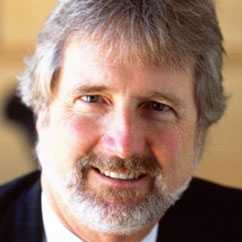
|
| G. Steven Burrill |
Burrill also has his eye on the statistic that only 8% of health care spending is devoted to pharmaceuticals, while 40% is spent on nostrums to promote wellness. The sly observation slipped out that if 40% of health spending goes for products of questionable value, just think how big the market would be for new products that really do promote some wellness. So that, in his opinion, is where investors will prosper.
Some of us in the back of the room were troubled by these thoughts. In the first place, the major drug houses have long operated with a financial business plan that takes profits from old established drugs and uses them to pay for research on the new drugs of the future. Small niche companies, that only work on one phase of this cycle, have had difficulty financing expansion and mostly accepted a subsidiary role. You might develop a wonder drug in your garage, but you had to license it to a big pharma concern in order to thrive. The thought pops up that the protracted wait for

|
| PA Drug Industry |
Food and Drug approval might be stretching the old-drug/new-drug interval to the point where patent expiration on the current revenue generators interrupts the internal recycling of profits into new drug research. That's been a threat ever since the passage of the Kefauver Amendment, but a new twist has appeared in the form of a tidal wave of cheap liquidity from the Far East, working its way into venture capital pools and assisting the niche firms with their historical shortages of capital. If that's a significant feature of the present environment, it could fizzle out when the Far East stops pumping liquidity into world markets. A new Premier of Japan might be all it would take, or else a drop in the price of oil. Japan's interest rates are now held below 1%, while a realistic price for oil is $45 a barrel, not $65.
And as far as the promotion of wellness is concerned, that concept might just turn out to be a fad. Congress doesn't try to evaluate scientific trends, but it is very fond of insisting that "if it ain't broke, don't fix it". A major advance in the treatment of cancer and or Alzheimer's Disease might very well dampen Congressional enthusiasm for spending 15% of Gross Domestic Product on what's then left to treat, which would mostly be wellness.
Community Volunteers in Medicine

|
| Comm Volu In Medicine |
Mary Wirshup has a very different medical background from mine, but she's my kind of doctor. I couldn't help wishing, as she addressed our urban luncheon club, there could be thousands more like her, even while understanding more fully than she seems to, the reasons why doctors are driven from her behavior model. As we parted, it felt like saying a last goodbye to the Spartans marching to Thermopylae.
As 46,000 medically uninsured persons in Chester County get sickness and injuries, they know that a Federal Law prohibits a hospital accident room from refusing to see them, so ways are found to shunt patients to the CVIM free clinic, run by volunteers. This law is, in turn, a response to a government-created situation where a hospital which "accepts" patients must keep them. Any economics teacher can tell you that supply/demand issues are best addressed by price adjustment, so price controls in whatever guise lead to shortages. I must say I have little sympathy with the devious strategies which hospitals often employ to disguise their rejection of uninsured patients. At the same time, I know a lifeboat will sink if too many climbs aboard. Nevertheless, the semantic switch from lack of insurance to lack of care implies that only more insurance can surmount the barriers to care, which is absurd. For one thing, I know too many hospital administrators who are paid a million dollars a year, and one who is paid two million. And at least two health insurance executives are in the newspapers with a net worth over a billion -- yes, that's billion with a b. We have reached a point where reducing all physician income to zero would only reduce "healthcare" costs by 10%. As I look at Dr. Wirshup's modest clothing I can only surmise she plans to continue her modest living until she is 80 years old, after which her savings might see her out. Squeezing physician reimbursement is not intended to save significant money, nor intended to restore physician incomes to more equitable levels. It is intended to address the oversupply of physicians without confronting either the universities or the foreign trained lobby.
The elite tranche of medical schools do their part to relieve physician oversupply without reducing class size, through the encouragement of their students to go into research. I was well along at the National Institutes of Health before I finally decided I had not gone into medical school with that goal, and returned to teaching and patient care in a more satisfying model not too different from CVIM's obviously Pennsylvania Dutch spirit. The Amish at the far western end of Chester County reject the whole idea of insurance; their most characteristic statement is "Don't send me no bills." That attitude is rather a contrast with the shiny housing and automobiles in the Silicon Valley developments of Southern Chester County, or even with some rather bewildered Quaker farm families scattered over the rest of the county next to the horsey set. Chester County is America.
On Second Street in Society Hill, next to the park where William Penn's house stood and a few feet from Bookbinders, is the house of Dr. Thomas Bond. Bond conceived the idea of building the first hospital in America and with Franklin's publicity machine succeeded in getting it built, to care for the "sick poor". Dr. Bond started a second enduring tradition as well. When the Legislature expressed doubt that the institution was sustainable, he pledged to convince the local medical profession to serve the poor without charge. Some of the legislators who voted for the measure did so in the belief that charity care would never appear so the gesture would be without cost. The physicians did indeed come forward, in sufficient numbers to run many institutions for two hundred years. In 1965 health insurance made its national appearance and has regarded the benchmark low costs of charity care as a threat, ever since.
Picking Up the Usual Suspects
The federal government directly controls about half of health care spending and makes rules affecting most of the rest.

|
| Claude Rain |
Every group or business which receives some of this money is alert not to lose it. Many other groups are alert for openings to get more of it. All employ sentries in Washington. False alarms are frequent, stealth attacks are a constant threat, constituents paying the bills demand immediate reassurances. Members of Congress seldom initiate a disturbance unless someone from inside an industry brings it to them. Consequently, when proposals do surface and seem to be serious, the question to be immediately answered is -- who's behind this? If you know who starts something, you can readily imagine the motive, assess the political strength, decide how to respond. With what little was generally known about the Clinton Health Care Plan of 1993, it was easy to imagine a host of people with some motive, but very hard to say who was actually pushing one. Must be a Democrat, obviously, but not immediately obvious which of several possibilities was the real agitator.
Health insurance companies would always seem likely to have proposals about national health insurance. Blue Cross dominates the market in large geographical markets, mainly East Coast, and would seem fearful to lose that dominance in a major upheaval. But other market areas of the country are dominated by commercial insurance companies who might seek to upend the Blue Cross monopoly, but whose form of business would be even more seriously threatened by health insurance innovations. Most commercial health insurance was written by large life insurance companies who regard health insurance as a small sideline for the convenience of their industrial customers. Blue Cross was somewhat more comfortable with government work, particularly since the 1965 Medicare and Medicaid programs were patterned after them. However, Blue Cross was non-profit, thus lacking in incentives, and historically controlled by health care providers. That is, Blue Cross was formed by and dominated by the hospital associations, and Blue Shield was formed by and dominated by medical societies. Since doctors and hospitals were very prompt in announcing their deep concerns and uncertainties about the Clinton Plan, Blue Organizations seemed unlikely to make daring proposals so likely to provoke trouble at home.
Not that some doctors and some hospitals didn't try to see what might be made of this opportunity. At the American Medical Association, certain leaders known to have Blue Shield involvement offered conciliatory remarks about waiting for further details before taking a stance but were abruptly halted by a general opinion that things had apparently already gone too far for substantive negotiation. Much the same thing occurred at the Hospital Association; the winners had too much to lose, the losers had too little influence to matter, and nobody stepped up to claim an inside track. Hospital trustees didn't know what was going on, strongly suspected something was going on and didn't like either situation. If the doctors got mad enough at a hospital, they could ruin it, and if hospitals got mad enough at Blue Cross, it too was ruined. The main strength behind the Blue Cross monopoly position was the secret discount provided to them by hospitals, which was refused to competitor insurance companies but could easily be extended in the interest of fairness. If need be. The commercial competitors wanted that discount much more than they wanted new insurance models.
There is one subset of doctors and hospitals that might be suspected of generating a sweeping revision of the medical system -- academia. Medical schools think of themselves as the appropriate source of vision about the profession they are training, and they run large prestigious hospitals. Their heavy dependence on government research grants, teaching subsidies, and tuition support programs puts them in constant contact with Washington bureaucracy and politics; propinquity is a great match-maker. Their style of salaried faculty creates estrangement from making a living by being paid fees for specified services, and they are reasonably comfortable with the flaws and techniques of professional promotion within a large organization. So, a slogan which has been attributed to Wilbur Cohen himself does not greatly jar on their ears. The author of the Medicare Act is said to have announced that the entire medical system of America could be accommodated by thirty or forty Mayo Clinics. Twist that just a little, and you are imagining he said forty or fifty medical school teaching hospitals. The briefest contemplation and rebuttal will knock down that proposal, such as pointing out that we have several times that many teaching hospitals at present without achieving anything like the nation-wide coverage envisioned. After absorbing the administrative chaos of readjusting to that model, you would confront the old repeated history of grossly overestimating, and then grossly underestimating, the future manpower needs of a medical system in the process of constant scientific turmoil. Suppose you built the fifty Mayo Clinics and found you needed two hundred? Suppose you built two hundred and found you needed seventy? And then, finally, remember that each big city could expect to contain one of these organizations, but the fewer of them there are, the longer the distance everyone else would have to travel to get to them. No one has even ventured to speculate how you could go about doing such a thing, let alone doing it three or four times to get it right. But, but. The infeasibility of academia at the center of medical care delivery does not eliminate the possibility that the idea underlying the Clinton Health Plan may have originated in academia, or that academia might support some similar proposal with something else at its center.
Since it was soon clear that the traditional "players" in the health policy arena were unlikely to be sponsoring some self-serving policy that might masquerade as the Clinton Health Plan, the search went on. There were a number of professional groups within the medical community who had traditionally chafed at the domination of the hierarchy by physician leadership. Nurses, hospital administrators, pharmaceutical companies, druggists, corporate human resources officers, public health officials, social workers, biology teachers all represented groups who derived status with the public by displaying inside knowledge of medicine. But all of them fell silent when a physician entered the room, and tended to shift their emphasis to faults of the "system" or the "industry". Their Washington representatives placed their emphasis on changes in the existing system which might elevate the prestige and income of the members and were particularly vigilant for system modifications intended for other purposes which might nevertheless create advantageous loopholes for the members. All of this is normal striving in the good ole' American way, a polite variant of the mixture of bellicosity and restraint usually seen in the Union movement. These people wanted to improve their income and working conditions but were ultimately quite hesitant about radical proposals that might sink the ship. A quick survey showed they were not supporting any particular reform project, even though they could be counted on to support any reform project. Furthermore, they consistently injured their political strength by extending beyond economic goals to issues like radical feminism in the case of nurses, or direct advertising to the public as in the case of the drug companies, or practicing medicine without a license in the case of limited-license practitioners. These people had votes, influence, and lobbyists, but they did not have a national project for health care reform of their own devising, and they surely were not the people behind the Clinton Plan.
During the six months before The Plan was presented to Congress and the Public, a White House task force said to consist of five hundred secret members was meeting under the direction of President Clinton's wife Hillary. No doubt part of their purpose was to give Hillary a public platform on which to show her stuff, with the idea of someday succeeding her husband as President sort of in the back of her mind. But most of it was also quite practical; somebody had to figure out what this proposal was going to be, and newly elected Bill had to spend most of his time learning how to run the rest of the country. Buried in here was an efficiency principle too; the staff members of every important congressman and senator were involved in the process, making the deals and surfacing the political angles before things had to come down to votes and filibusters. Meanwhile, the rest of the country had to wait outside closed doors, fed by rumors and spin.
How well I remember one public seminar on the subject during this period of suspense. The audience was filled with people thought to be influential with the public, the usual suspects in that sense, too. Representatives of various interest groups were seated up front at a table, and for some reason, I had been picked to represent doctors. Next to me was a druggist who had made a billion dollars starting an HMO; it was intriguing to watch how many well-dressed women with no interest in health care paraded up to the table to show their stuff to the billionaire, while we waited for the meeting to begin. All of the usual suspects of Philadelphia medical care were at the table, each of us wondering what the other was going to say. When some last Very Important Person had wandered in and taken a seat, it was time to begin. The moderator told a funny story or two, and then asked each one of us what we thought of the Clinton Health Plan. One by one, to the utter amazement of us all, we each explained how we were opposed to it.
So obviously this proposal was not coming from the usual agitators. But, remember, somebody was surely behind it. Before we take a stab at that mystery, let's humanize the usual suspects by describing a few of them.
Equal Pay for Equal Work
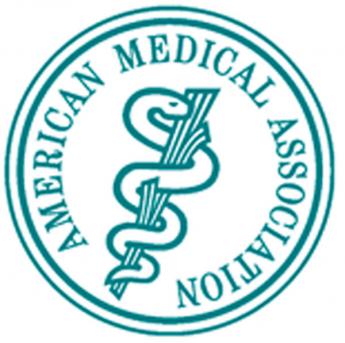
|
| American Medical Association |
The House of Delegates of the American Medical Association holds a five day convention twice a year. The meetings last from 7 in the morning until midnight, although the main sessions in the auditorium only last eight hours a day for three days. The rest of the time is consumed with meals, committee meetings, geographical caucuses, and even cocktail parties. Newcomers often object to the numerous parties until they come to see that these are merely committee meetings in a different form, with different subsets of the organization picking up the necessary costs. This group of workaholics has to vote on several hundred issues each session, and most Delegates have little advance opinion when they enter the headquarters hotel on the first day. But after meeting with their specialty in one committee, and members of their geographical region in another, and members of their medical school alumni association in yet another, and with issue-oriented groups, political allies, and other layers of an overlapping matrix day after day -- by the time the vote is actually called for, most Delegates could safely predict the correct outcome with very few exceptions. The AMA works at its similar job with far greater intensity than Congress does because Congress has all year to do it, while the doctors have to go home to make a living. Don't worry about the parties, they are really working sessions for everyone except rank newcomers, outsiders, visitors, and wives. What is perhaps more worrisome is the rare occasion when just about every delegate arrives with one opinion and is persuaded by the leadership to adopt the reverse. That can only happen if new information is suddenly revealed, with little time to check its accuracy.
There are usually fifteen or so parties every night, hosted by large state delegations, large specialty assemblies, and coalitions of smaller groups. Fifteen drinks a night would be quite a bit for most folks, and some newcomers are duped into trying to be polite about it. The rest of us take the proffered drink, walk over to a nearby plant stand and dump it. I hate to think of how many potted palms I have fried that way. Each delegation has its own system of organizing these minutes, and I'll try to describe the Pennsylvania system.
Nobody will come to your party if you don't go to theirs, so we make a list and divide the group into those who "travel" to the parties of other states, and those who remain to host our own party, "at the door". Everyone is expected to wear a name tag, containing your name in large type underneath which is your caucus designation, in my case "Pennsylvania". The older members instruct the newer ones to put the name tag just under their right shoulder. That way, you can seem to be looking at the hand you are shaking while freshening your recollection of who in the world you are meeting. You can, of course, do anything you please, but time is short for the transaction of a lot of business, and it's just easier to do routine things the regulation way, and get on with it.
On the evening in question, I was "at the door". The formula, repeated many times, was to extend a hand of greeting and recite, "Welcome to Pennsylvania. Are you looking for some friend in particular? Let me see that you have a drink. Come on in and meet my fellow delegate, Scotty Donaldson." You can shepherd a lot of people more or less gracefully if you reduce the formalities to a routine. After several people had been brought in under the tent, a man with highly polished shoes came up, wearing a name tag that said, "Blue Cross of America". He was greeted, his hand pumped, a drink procured, and was introduced to Scotty, our most famous extrovert. I quickly turned to the next person at the door.
Well, this lady was six inches taller than I am, and fifty pounds lighter. She wore a name tag, identifying her as President of some Nurses Association, "Welcome to Pennsylvania! Is there someone from Pennsylvania you know or would like to meet? Can I......" The apparition didn't even look at me as she brushed past through the door. Heading straight for the gentleman from Blue Cross, she poked her index finger into his chest, stopped him in mid-sentence as he talked to Scotty.
"What I want to know, " she announced to this startled man, "Is when are you people in Blue Cross going to pay nurses as much as you pay doctors?" And here I must admit I have to give this guy credit for unperturbability.
"Well, madam," he said cheerfully, "I think that's going to be quite some time."
A New Gorilla in the Cage

|
| William Clinton |
News reports began to surface that big business was talking to Democrats in the White House about major revisions in the national health delivery system. That in itself was news, because big business normally forbids its employees to talk with regulators, and does not commonly welcome any new regulations. But the Clinton Administration was looking for political allies, while the business community was willing to examine proposals to lighten the burden of employer-based health insurance. The discussions soon probed whether a common system might reduce government costs of Medicare and Medicaid, and simultaneously reduce the costs of employer-paid health insurance. For years, big business had been suspicious that the health community had somehow forced employers to pay an unfairly large share of other people's health costs, through some arcane manipulation of hospital cost accounting. Their term was cost shifting.
The administrators of government programs believed the same thing was happening to them. Since the only group left to benefit were uninsured, the arithmetic was somehow wrong. A 7% population group, most of whom are young and healthy, could not account for annual premium jumps far in excess of the cost of living, occasionally as much as 30% in one year. In both governmental and business minds, the main beneficiaries of cost-shifting must be the hospitals themselves, and the doctors who control them. Somehow, it seems not to have occurred to them that this news was brought to them by their fiscal agents, the health insurance companies, and was therefore likely slanted to avoid attention to middle-man costs. Whenever major negotiations are to be held, CEOs and top politicians take over to make the deals, necessarily basing their judgments on filtered information. Since this is a familiar situation, they employ high-priced consultants.
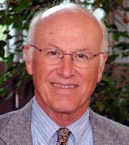
|
| Clark Havighurst |
The five hundred secret members of Mrs. Clinton's task force were willing to listen to the ideas of anyone who had political clout, especially staff members of Congressional committee chairmen. But these people had been struggling with the problem for fifty years to no avail, so the emphasis had to be on change, on big new ideas. Universities and think tanks were especially welcome to comment, and
Clark Havighurst was particularly influential. But there had to be some kind of track record, some practical experience on which to base such an enormous national initiative. The best available model was the Health Maintenance Organization (HMO), whose most famous proponent was Paul Ellwood, a former midwestern pediatric neurologist who had gravitated into health insurance consulting. Ellwood had a vacation home in Jackson Hole, Wyoming, where he then gathered the non-government component of this movement into his front parlor. Insurance companies, human resources officials, academics, and in later stages the news media, were given the Word, an opportunity to criticize, and an opportunity to have their views coordinated with the government group in Washington. There was a rough division of labor, establishing general regions of dominance; but ultimately, the two components intended to fit together in a unified health system for the whole country, bar none. The business community began to see that inevitably, in that case, the final overarching decisions would be made in Congress.
Health Maintenance Organizations (HMO)

|
| HMO |
It's an ancient wrangle whether a manufacturer should actually own its suppliers or the reverse; or instead whether it's healthier for industry components to stand at arm's length from each other. At issue is not only what is best, but what is fair. If industry mergers seem sufficiently unfair, it will be proposed they should be illegal. That's the main substance of a lot of antitrust argument. Unfortunately, what is valid in good times may be reversed in a downturn. A prosperous supplier of materials often acts as a "cash cow", saving a merged enterprise from bankruptcy. Unfortunately, within a different economic climate one badly failing supplier can bring down the whole merged enterprise. There's also organizational friction; a temporarily prosperous unit may get to thinking it should boss the less prosperous units around. At the very least, the cash cow resists the use of its cash reserves to help "losers". Several centuries of experience have thus left a minefield of old laws, traditions, and ingrained prejudice to undermine any broad standards for what is best. In no field is this truer than the Medical Industry.
Eighty years ago in Houston, the first Blue Cross health insurance company was started for a single group of school teachers to pay for service in a single hospital. That expanded to other subscribers and other hospitals, soon making it more workable for insurance, subscribers, and hospitals to stand at arm's length, allowing for a variety of local combinations. During World War II, combat in the Pacific led shipyards to be built on the West Coast, but westward migration of steelworkers was hampered by lack of local medical facilities for them and their families. Taking advantage of the loophole provided in the wartime wage and price controls, Kaiser Industries attracted medical personnel by building hospitals, paying salaries, and offering physicians ready-made medical practices. Because of various licensing laws, Kaiser's medical enterprise was divided into two corporations, Kaiser and Permanente, so a specialized corporation within the Kaiser-Permanente Foundation could accommodate the licensed practitioners. The salaried nature of the physician organization immediately caused trouble with local fee-for-service practitioners, who were thus excluded from a large population in their neighborhood when they could not readily adjust to varying mixtures of the two payment methods. Their reaction, led by an obstetrician in Stockton, California, was also to organize dual-corporation structures which were exclusively fee-for-service. Because Kaiser had a Foundation, they also called their organizations Foundations for Medical Care. Then, as now, it proved difficult to run a practice with two different reimbursement philosophies in the same waiting room; in time, friction between the two styles tended to increase as doctors who were more comfortable with each style tended to segregate themselves. Since offers of salaries are more immediately attractive to newly-trained physicians, they flocked to California to serve the steelworkers who were in need of doctors. Fee for service, on the other hand, allowed the gradual assembly of a more durable practice composed of patients who could test what they liked before making a permanent allegiance. Essentially, the transients went to Kaiser, more permanent settlers used fee-for-service.
Thus, it came about that several models for health care reform were tested in a few smallish towns of central California. These demonstration experiments may perhaps not meet everyone's standard for scientific purity, but at least they were public examples with the dumber features knocked away. They certainly provided a laboratory where ideas could develop about topics that otherwise were merely opinions and unsupported conjecture. The Foundations demonstrated that physician-dominated organizations could contain costs and maintain quality in a satisfactory way; there had previously been doubted about their ability to contain cost. The Kaiser organization showed that salaried practice performed acceptably as well, both to most staff physicians and to a majority of the patients; there had been doubt about the willingness of the public to limit choices to a panel of assigned physicians, mostly young and usually from elsewhere. Finally, the two systems seemed to be able to live together more or less peacefully; indeed, the California public seemed reassured that two systems apparently kept each other in check.
The first main difference rested on the system of quality control. The local Foundations developed review systems based on peer review and peer pressure; these worked remarkably well, particularly in constraining non-physician costs like pharmacy, tests, and hospitalizations. Cost and quality control in the Kaiser system was more rule-bound and quicker to apply discipline, kept within bounds however by the ability of both patients and staff to jump ship for the other system. Aside from professional peer review, the Kaiser system experimented with owning hospitals, laboratories, pharmacies. Here, the experience directly paralleled the experience of manufacturing industry with its suppliers; when reimbursement was generous suppliers generated welcome revenue. When reimbursement was constrained and substandard, ancillary service losses were unwelcome. Taken overall, the Houston experience was repeated, that ownership of such facilities was mostly a headache. Indeed, subsequent experience has shown the two systems usually co-exist nicely within independent ancillary facilities.
The Stockton, or Foundation for Medical Care, approach grew popular in the West. The variant which grew up in Utah was locally popular and attracted the attention of Senator Wallace Bennett. The Bennett Amendment to the Medicare Act then picked out the peer review system as the secret of success and set up a nationwide system of Professional Standards Review Organizations (PSRO) to conduct peer review of Medicare and Medicaid patients. The drawing of boundaries around these organizations was the most difficult part, and sometimes the boundaries were inept. Rural districts were adamant that the standards of big-city medical schools were not to be applied to their scattered resources, and urban areas saw themselves as ancient Rome surrounded by hostile tribes. Although these difficulties were foreseen, it is not always possible to draw a line that will separate the cultures, particularly where the outward migration of suburban housing was more rapid than the construction of suburban medical facilities, leaving the medical culture unstable. The PSRO system was quite successful in many areas but caused trouble in others that were not adequately addressed. The central concept of the review system was that the doctors who worked together could quite readily identify the outliers, and better than anyone else could judge whether the local situation was justified. True, some practitioner might try to abuse the system to the disadvantage of his competitor, so no adverse decision was final until there had been an opportunity for outside appeal. There might even be a few circumstances requiring a still higher appeal. The system was new and untried, but it produced eminently satisfactory results from the point of view of the Federal Government paying the bills. As former President of one of the largest PSROs in the country, I will assert that there was remarkably little friction or resistance in the medical community. My very good friend, the President of the New York City PSRO says much the same, and most people would say that if you can carry off a new system in New York without a lot of argument, it must work pretty smoothly. The Government wanted to eliminate unnecessary Medicare costs, particularly in hospitals, and it wanted to maintain peace with the medical profession. Hospital costs are obscured by the wide gap between posted charges and true underlying costs, compounded by disagreement about the proper assignment of overhead charges. Charges were not the assignment of the PSRO, utilization was. Days of hospitalization per thousand enrollees fell from roughly 1000 days per thousand to roughly 200 days per thousand, and that satisfies me at least that we were doing our job; physician peer review was doable.
It is likely, however, that peer review was much more apt to produce friction in rural districts. Philadelphia has had more than a hundred hospitals for more than a century. Birds of a feather tend to flock, so the sorting-out process was already far advanced by the application of constrained referrals to practitioners who failed local standards. Mixing members of different hospital staffs on appeals committees was easy in the big cities, and the naturally censorious tendencies of many physicians could be safely counted on to produce adversary balance. Most committees seemed visibly pleased, even relieved, to discover generally good quality in their competitors' practices. However, in the much smaller and more scattered institutions in the nation's regions with low population density, these informal arrangements cannot stretch as well. When there is only one specialist in a field, for example, it is sometimes hard to know whether he is a good one or not, but always easy to say whether you like him or not. Where the population thins out, much greater wisdom is required to make judgments, the number of close cases is greater, and the limited supply of judicious reviewers is similarly stretched. At least that is my surmise, based on knowing the background of most of the AMA delegates who eventually voted 105-96 to condemn the program in a standing vote. The result was the Dornenberger Amendment, which much weakened the system when instead it should have triggered a more profound analysis and reconsideration.
Perhaps we spend too much time here describing a technical process. It is, however, at the heart of what makes the Foundation approach (sometimes called IPA or Independent Practice Association) superior to the HMO. It is now perfectly clear that both doctors and patients vastly prefer the IPA approach to the HMO, and any reasonable politician would jump at it. But there is one fear, summarized by the slogan that the Fox is guarding the Henhouse. In both systems, an attempt is made to combine insurance with the delivery of health care. In the IPA, the physicians are taking the financial risk that aggregate income will exceed aggregate costs; it's a risk contract. In the case of an HMO, the employer or the government is taking the financial risk and therefore wants to control it. If revenue is good, the doctors will prosper in an IPA; the insurance company intermediary will prosper in an HMO. Doctors will care about that little difference, but why should the rest of the country care?
Because the prospect is overwhelmingly likely that future revenues will be constricted until something hurts, and when you starve with a tiger, the tiger starves last. In the case of an HMO, the insurance middlemen will starve last, and the quality of health care will starve fairly early. That's an unwise design. When we get to the point where Congress cuts the budget and watches to see what happens, Congress will cut it some more if nothing bad happens; it will back off only if something bad happens, so something bad is certain to happen. In designing the system, you need to design the internal review authority so it will cut the waste, inefficiency, and luxury first. The reviewer, no matter who it is, will cut himself last, so you need to arrange the incentives for waste to be cut before the reviewer suffers, and quality of care only after the reviewer has suffered. If you wonder why a whole lot of special interests hate physician-dominated review systems, a short answer will be found in this synopsis. A special exception must be devised for rural health systems, which do have a unique problem.
To return to the well-worn slogan about foxes and henhouses, we have overlooked the central question. Who's the fox, and who is the hen?
National Business Coalition on Health

|
| NCOH |
In 1992 the National Business Coalition for Health was just forming at a convention in Chicago. Before I really understood what it was all about, I agreed to their flattering invitation to be the keynote speaker at the kick-off luncheon. Who suggested my name was and is a mystery to me, and I arrived in Chicago with very little idea what they wanted to hear. However, it followed the familiar pattern of inviting the speakers to stay overnight at the hotel on the evening before the meeting began and to meet for drinks at the bar with the organizing leaders. I had enough experience with public speaking to know I could learn the general slant of the thing at such an informal party and adjust the speech to the audience to whatever degree seemed needed. Among the people scattered around at tables was Harry Schwartz, who was also there to give them a speech. Harry had been on the editorial board of the New York Times for many years and was known to be generally quite favorable to physicians. We had both written books about medical care, The Hospital That Ate Chicago in my case, and The Case for American Medicine, in his. We liked each other immediately and fell into an animated cocktail conversation that would eventually be renewed every six months at the American Medical Association House of Delegates meetings, where I was a delegate and he covered the topic for various news media. As we chuckled together about one anecdote or another of medical politics, the bar gradually emptied out. It soon became clear that all the other cronies had wandered off to dinner together, so we ordered dinner on the house, neither one of us have learned just what we were there to talk about. It really didn't bother either one of us very much, since from long experience we could tell some jokes and make it up as we went along. I knew what I wanted to tell businessmen, so it was just a matter of finding a way to lead into it.
The speech seemed to go well. There were several hundred, perhaps even a thousand in attendance, quite convivial and prosperous. As executives usually do, they looked younger than you might expect from the titles on their name tags; they laughed at the appropriate points and applauded at the end. In other words, I went home from Chicago with no more idea what this organization was up to than I had before I came. At the very least, it is clear they were forming a national organization of businesses, with constituent representatives largely drawn from Departments of Human Resources. They wanted to speak for American Business with a more or less unified voice, and the topic seemed to be health care. Although fate had put me into the debate at the very earliest moment at Wills Eye Hospital, this convocation of extroverted Republicans seemed to know a lot more than I did about what was secretly afoot among the Democrats in Washington.
This Chicago tea party did one other thing for me. Many months later, when the editors of USAToday were in search of an editorial page writer who was both a physician and opposed to the Clinton Health Proposal, they called Harry Schwartz. And he suggested to me. They ultimately ended up with a Medical Editorial Advisory Board of five members, at least three of whom were far to the left of me. At the New York Times, of course, Harry Schwartz was considerably more outnumbered than I was. After it was over, Harry and I used to joke that both sides were fairly evenly matched.
Nowheres-ville

|
| Jacob S. Hacker |
In more recent writings, Jacob S. Hacker seems obsessed with social inequality, but while he was a graduate student he wrote an excellent and objective book, The Road to Nowhere containing unique insights into the politics of the Clinton Health Plan of 1993. After that hubby was over, he interviewed most of the important actors in that drama, at least those active in the liberal politics of it, and they talked freely. Like the rest of us, he was unable to identify let alone talk with the leaders of big business, who are of course still pursuing their original goals. What emerges does sound roughly accurate; Hillary Clinton and Ira Magaziner designated to find out what this health business was all about; solicit every proposal on the mind of political, particularly congressional, allies; gather and examine all the useful ideas in circulation in academia and the insurance community; and negotiate possible solutions with a surprising new ally, the big corporate employers. A huge semi-secret task force was then assembled to exchange ideas, discard really bad ideas, and work the proposal into legislative form. There would be internal inconsistencies and conflicts but no matter.

|
| William Clinton |
Congress would work it out, differing versions would appear in House and Senate bills, and President Clinton himself would eventually be able to intervene when things got to the House-Senate Conference committee. Since the Clintons really had no pre-conceived ideas on this complicated topic, the will of the people would emerge from a huge debate, and the will of the people would prevail.
That's one version. The other way to picture this circus would be that a highly skilled politician would offer everybody a chance to propose pet projects, and those who failed adversary process would be obligated to support the ones who did prevail. Trade-offs would be made, as needed, and the political ringmaster in the White House would have the final say.
But the final version was the one that came through to the public and the leaders of big business. You weren't going to know what the plan was all about until it was too late to do anything but accept it after a big sales talk full of snake oil. Big business, which had a serious interest in a particular outcome, also had an army of experienced Washington lobbyists. These people were aware of the unpredictable quirks of the house-senate conference system, were completely confident that the membership of that committee would be stacked in favor of a particular outcome, and knew that a congressional staff with agendas different from those of business would, in the end, be perfectly capable of stealing the show. For major employers, that settled it.
Big business had been wavering about whether to go ahead with their own plans, anyway. They had listened politely and carefully to what the government wished for its own insurance plans, Medicare and Medicaid, and were probably willing to agree. But as matters approached a unified approach, too many things surfaced they didn't like, and too much chance the decisions would go against their wishes. There was too much to lose, too little to gain, and well, we're sorry, we can't go along. This or something rather like it seems to have been the final outcome. The press had been furious about exclusion from major news items, coupled with annoyance at the favoritism toward Mr. Weinstein of the New York Times. The whole medical industry was jittery about exclusion from consultation or even notice; the insurance industry was pretty comfortable with the status quo; the public was in a state of utter confusion After the main partner dropped out, the proposal never even came up for a vote in Congress.
Hold the Presses
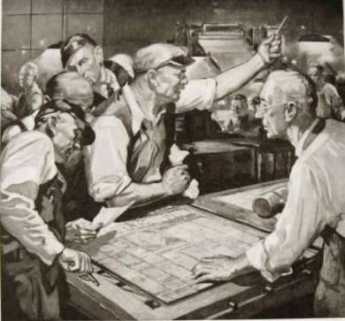
|
| Stop the Presses |
At USAToday, techniques are astounding. After getting an 800-word piece, an editor by phone will suggest cuts to 300 words; the piece is always improved. Last-minute speed, trying to watch television, is unbelievable. On one occasion, after a medical meeting in Kansas City, watching a baseball game go into extra innings I fell asleep with the game undecided. The next morning a newspaper was pushed under my door. It was USAToday, not only carrying the final score but a full story, under a color photo of the winning play. Just consider the precision Chicago reporting, Washington DC editing, Kansas City printing and local delivery that took place in seven hours. By contrast in book publishing, a full year often intervenes between manuscript submission and actual bookstore sales.
So on a certain Monday night, the editor called. The Senate Majority Leader, George Mitchell, finally was to unveil the Clinton Health Proposal tomorrow morning. Would I please submit an editorial to run in the morning paper; he would supply the title. It was to be called, What Should Congress Do Now? and the deadline was 7 PM tonight. My watch read 5:30 PM.
Well, what fun. After a few minutes of stumbling around, I resolved to build the editorial around the theme, Don't Make Things Worse. It then seemed natural to allude to similar proposals gone famously wrong, define some predictable traps, and end up with Hippocrates. Over and over it is thundered at medical students: Primum non nocere. First do no harm. It all came together in my head, and I sat at the typewriter to bang it out. But when I came to that last sentence, pleading at least do no harm, I was hit by terrible doubt.
That phrase comes to us in Latin, and Hippocrates was a Greek, living at least five hundred years before the Roman Empire. Famous though the saying is, it wasn't (then) in Bartlett's Quotations, or Roget's Thesaurus, or anything else I could lay my hands on in what was, after all, a medical office. It was 6:50 PM. I called a learned friend from his dinner-table, and he agreed it was a strange business, looked at a couple of books, couldn't help, sorry. So, I drew a deep breath, said the Hell with it, typed in, "As Hippocrates said, At Least Do No Harm," and shoved it into the fax machine. The next morning it appeared, next to two million copies of my photo; so at least the editor seemed to like it. Some friends soon called to say that Senators Dole and Moynihan had adopted the line on the noon and six o'clock news, each attributing it to Hippocrates. No matter what happened to the Clinton Health Plan, it looked to me as though I would be forever guilty of supplying the world with a highly quotable misquotation.
Since then, with more time to do a proper search, I'm unfortunately still uncertain. William Safire at the New York Times, was intrigued but could only refer me to a nice lady at the Library of Congress who was a crony. She tried to help but was stumped. Some Hippocrates scholars at the Library of the Philadelphia College of Physicians were able to find a reference in The Epidemics which seems to say what we are looking for, and that reference has tardily crept into Bartlett's latest edition. Some people think Galen really wrote it, which might account for the Latin; but even that is unsatisfying to scholars. Somebody or other took that phrase, whether written by Hippocrates or not and pounded it over and over until it became a medical student incantation. Even if Hippocrates actually did express that sentiment in passing, it doesn't come through as a really important statement, and there isn't much evidence that his students were repeating it over and over as the words of the master.
My present suspicion is that vague rumors about Samuel Hahnemann, the father of Homeopathy having a hand in promoting the slogan during the Nineteenth century, may have some underlying substance. Homeopathy was a belief system which emphasized the prescribing of infinitely minute doses of medicines. It had a flurry in the 19th Century when conventional Medicine was reeling from excesses of bleeding and purging, which surely did a lot of harm to victims of, say, Yellow Fever. The acrimony even spilled over into the emotionalism of the abortion debate, because laws prohibiting abortion had been sponsored by the allopathic American Medical Association. The verbal warfare between doctors of Homeopathy and "Allopathy" was bitter beyond describing. Although conventional medical care finally got its feet on the ground, and homeopathy is now pretty much a historical relic, the homeopaths did have that big strong point. Doing nothing is clearly better than doing something harmful. Nobody takes Latin, much, anymore. So the modern medical way of saying the same thing has come to be, "The hardest thing to do, is to do nothing". This way of stating the same idea is widely believed to have been offered by William Osler, but after all the controversy about Primam non-nocere , I am now reluctant to be too sure about anything in this area.
Be Careful What You Wish For

|
| Pulse |
Events at the time of the introduction of the Clinton Health Plan to Congress were a confused jumble, but one vignette stands out in my memory. The five hundred or so members of the secret work group were all invited to the White House for a big party, with saxophones and all. On a television interview at home in Minnesota, Paul Ellwood said he wasn't going to the party. Indeed, he looked rather morose and had little to say. It is clear he had advance notice, before the plan even reached Congress, that things were not going the way he wanted. Since the public, even Congressional leaders, were still unclear just what was to be proposed, Ellwood's dejection, or rejection did not come from them. No one has said so, but it must be presumed the rejection came from his sponsors, the business leaders. Business, in short, had pulled out; responsibility probably lies with no more than half a dozen CEOs who continue to be anonymous fifteen years later.
At that confusing time, the reasoning of the masterminds was obscure. Perhaps they decided HMOs were no good; perhaps an outrageous political demand had been linked to the proposal; or there was to be too much political control, too little business control; or perhaps government costs had been shifted onto the backs of employers; perhaps the whole idea sounded too leftist to be comfortable. And perhaps a lot of other things, who knows. Even today, no one has written a book or even listed a few plain sentences of reminiscence.
What is known is that major business employers immediately launched a nationwide initiative to go ahead with a strong push to convert employer-based plans from fee-for-service to managed care HMOs. This was to be the way employers handled health care they were paying for; the government could do as it liked. It must be admitted it was a bold stroke, quite effectively handled. When you consider the rather uncertain legal right they had to impose a system of health care on their employees, it took more audacity to go ahead than you would suppose they could summon. It was a gamble that the Clinton White House would lack the courage to challenge a private initiative to go ahead with what they had so publicly endorsed, and that providers would be so surprised by the concerted coup that they would hold back legal challenge until evidence of antitrust or conspiracy emerged. It was a sort of Battle of the Bulge in reverse, and it might well have been hugely successful except for one thing they did not anticipate. Their employees almost universally hated HMOs when they tried them out. No one likes to be hustled into something he doesn't understand, no one likes to change doctors, no one like to be told he can't have what he expects to have. Employers expected resistance of this sort, but it simply had to be done to save the fiscal health of the business. Unfortunately, what emerged was that it didn't save much more money than its own extra cost to administer. The hard reality of business life is you regularly have to bully people in order to make any money. But bullying people without making any money is a quick route to dismissal. No wonder there have been no memoirs written.
A quick re-appraisal of the Clinton Health Plan was that the two systems, Medicare for people over sixty-five and employer-based for people under sixty-five, were to be merged into a single system for efficiency and better control. There were to be local, regional, and national governing bodies; evidently, the purpose of the National Business Coalitions for Health was to supply a unified business hierarchy to match it up and down the line. Hated politicians, hated bureaucrats and hated unions could be counted on to apply strong pressures; business would have to remain well informed, sternly disciplined, and speak with a single voice for any hope of surviving in such an environment. It is my surmise that such a prospect seemed to guarantee failure for a business. No, we're sorry, Business would draw a bright line at age sixty-five, and run its own show where it ruled the roost.
Computerizing Medical Care
Note: This article was written in 1999, long before Computerized Medical Insurance Exchanges were such a disaster:

|
| First Computer |
My first encounter with a computer was in 1958, and I have loved them ever since. As president of what called itself the Delaware Valley Hospital Computing Society, I remember giving a dinner speech concluding as follows: "If you want to be happy for a day, get drunk. If you want to be happy for a week, get married. But if you want to be happy for a lifetime, get a computer!" After fifty years, my affection continues. But to be candid, billions of dollars about to be spent on computers in medical care will mostly be wasted. Even worse, like malpractice suits computers will induce behavioral changes in the system costing far more than the directly visible costs.
That's unpopular news at present since the National Business Coalition for Health has launched a major lobbying campaign to persuade Congress to spend an initial billion dollars inducing physicians to maintain an electronic medical record. Various health insurance companies already provide financial incentives to doctors to file electronic claims forms, eventually threatening to reject any claim submitted on paper. The American College of Physicians has established a rather large department to develop programs for physicians to use in their practices; twenty years ago the University of Indiana started much the same thing. The College of Physicians of Philadelphia has spent close to a million dollars on such a project. It is reported that Microsoft Corp. has a massive project underway to supply electronic medical records. It sounds fairly easy to obtain large research grants from the government to devise something, anything, useful in this area. In my own case, training funds really weren't necessary, since I eagerly got into the field when everybody was a beginner. I was just as good a beginner as any other beginner. But let me repeat: the electronic medical record has been in the past and will be for decades, an expensive digression. In health care, creating more administrative work isn't the solution, it is the problem.
For fifty years the problem with an electronic medical record was that it took too much of the doctor's time to complete his part of the input, and then cost him too much to pay employees to do the rest. Presumably, automatic voice recognition and dictation will soon make it possible to record doctor's notes without handwriting or typing. Since, however, the elimination of current paper forms and check-off boxes will create a major problem in organizing the dictation verbiage, it could add five or ten additional years before programmers manage to rearrange dictation material and effectively integrate it into organized form, complete with laboratory results, dictated x-ray and EKG reports, even small images of the original material. Temperature, blood pressure, weight, photographs and the like can all be readily integrated into the stored electronic record, but to do so usefully is an expensive programming project. Doctors are quite right to be anxious they will lose control of the usefulness of their records in order to ease the task of programmers, speed up the sluggish pace of development, and reduce what will surely be an unexpected cost overrun. Storage and retrieval of such records is known to be an achievable but expensive task, which however also risks sacrificing the speed and ease requirements of the medical task it is supposed to serve -- in the name of cost-effectiveness.
Computers are no longer an unfamiliar tool; physicians have altogether too much experience with "vaporware", unrealized promises of convenience, and the damaging effect on the medical quality of the philosophy of Quick and Dirty. To respond to their resistance to design blunders with an accusation of undue conservatism is to provoke an icy stare and gritted teeth. Inevitably, the effective use of automation will require a redesign of workflow with major disintermediation of "gopher" staff; after all, that is how cost savings are to be achieved. That will provoke outcry that physician time is the most expensive component in the process, but unfortunately, physicians will discover Information Specialists with a business background will brush that argument aside. The most overpaid people on the face of the earth are investment bankers, but information consultants have persuaded business executives that inefficiency of the investment process is more expensive than even an investment banker's time. Having been through this themselves, insurance executives are unlikely to pay the slightest attention to physicians dancing to a familiar old tune.
For all that, data input is not the real problem; it's just the first problem. It's in a class with data storage and retrieval, which is expensive and cumbersome when you add a need for instant access and total privacy. But costs will come down steadily, and eventually, we can expect automated fingerprints or other biological identification, and cheap instant retrieval. Doctors will be able to make rounds in the hospital with a computer in their pocket, record telephone calls in their entirety, dial automatically and whatnot. There are problems with wireless transmission inside buildings with steel girders, and legal requirements for signatures on narcotic orders, but if we are determined, these problems can be overcome as easily as they were with electronic check writing and stock brokerage. Cost may top twenty billion dollars in twenty years, but it all can be done if we insist.
But then you encounter the real problem. Information will accumulate in these records in staggering amounts. Even if you resolutely resist demands to have the nurses record every groan, and the orderlies file every laundry slip, the legitimately important medical information will be exposed as the massive heap of transients that they really are. Plaintiff lawyers will insist no scrap of data may be deleted, hospital administrators will insist on compliance, when in fact most of a doctor's concentrated effort is devoted to brushing aside momentarily distracting data in order to see what's going on and react to it instantly. When a quick look doesn't solve the problem, the doctor goes back for additional data. If you disrupt these skills and traditions of coping with information overload, evolved over centuries, you will at best impose frustrating delays on a complex system under pressure, and ultimately inspire elaborate systems of short-cuts. The Armed Forces are famous for paperwork, but even they know better than to ask a pilot for his Social Security number as he starts a bombing run. The hospital nursing profession has already just about collapsed under paperwork pressure. If you see five nurses in a hospital, three of them will be sitting down writing something. The terrible truth is that no one reads it, no one checks it, and ultimately it sits in the record room waiting for a plaintiff lawyer with unlimited time to sieve out some misrecorded misconception or uninformed conclusion. My faith in the computer is such that I feel sure that methods can be devised to produce periodic summaries, automatic alarm signals, and mostly effective prioritization of data elements. Unfortunately, medical care is changing at such a rapid rate that ad hoc automation of physician thought processes cannot keep up with the current pace of change in medical progress. You would think some things would be unthinkable, but since I can remember the organized campaign to suppress the CAT scan as an unnecessary expense, I confidently predict that programmer inability to keep up with some advance in medical care will at times lead to organized outcry that we should slow down the pace of improving medical care, so that computer clerks can keep up with it. But that is only a small part of the issue, which at its center is that physician time will be dissipated and his attention distracted by presenting him with unwieldy amounts of neatly printed, spell-checked, encrypted and de-encrypted, biometrically secure, hierarchically prioritized -- avalanches of data which are irrelevant to the issues of the moment. The goal is not, after all, an electronic record. The local goal is to decrease the cost of medical care by increasing the productivity of the physician, and the overarching goal is high-quality patient care at a reasonable price. Behind all that, since the impetus comes from NBCOH -- the ones paying the insurance premiums -- suggests that the local goal is not so much the improvement of care as oversight reassurance that cares provided has been as good and as cheap as possible. The goal is legitimate, but this cybernation approach looks to be self-defeating by being overly specific.
If the reader has the patience for it, let me now cite a historical example of the third-party tail wagging the medical dog. In this case, third-party health insurance similarly overextended its reach by imposing internal health system changes, trying to facilitate the role of monitoring it externally. Specifically, the system of diagnostic code numbers was changed from one devised by the medical profession for its purposes, into a different coding system devised outside medial profession sponsorship, which seemed to suit the needs of payment agencies better even though it suited medical purposes less. After twenty-five years, it is now clear that third-party payers have shot themselves in the foot on this matter, and everyone is worse off. The topic, please pardon the obscurity, is the diagnostic coding system.
To go back to beginnings, the American Medical Association perceived a need for a diagnostic coding system in the 1920s. Organizing or even merely indexing vast amounts of information about a disease required more specificity than freestyle verbal nomenclature could provide. Quite a distinguished panel of specialists and consultants then produced the Standard Nomenclature of Diseases (SNODO) which in time became the Standard Nomenclature of Diseases and Operations. In order to reduce ambiguity, this system developed a branching-tree code design for anatomy, linked to a branching-tree for causes of disease, ultimately linkable to a branching tree of procedures. These three sets of three-digit codes linked the components together with hyphens (000-000-000). The first digit of each was the most general, as in Digestive, Musculo-skeletal, etc. and subsequent digits were progressively more specific and detailed, as in "Digestive, large intestine, sigmoid colon". The causes of disease would resemble "Infections, bacterial, streptococcal". An example of Procedures would be "Incision, incision, and drainage, drainage and insertion of the drain". In nine digits, it was thus possible to represent " incision, drainage, and insertion of a drain into a streptococcal infection of the sigmoid colon". After a while, the codes grew from three to five and six digits, again repeated three times, so an immensely detailed, unambiguous description might be coded in fifteen digits by a physician who knew the rules but didn't own a codebook. This code was ultimately taken over by the Academy of Pathology, expanded and is called SNAP. The pathologists absolutely refused to give it up.
The rest of the profession gradually yielded to the pressure of hospital administration, who was pressured by the Association of Medical Record Librarians, responding to the views of outside statistical interests, particularly insurance. A simpler, shorter coding system was needed, they felt, concentrating on the thousand most common diseases. The International Classification of Diseases was produced, reducing the millions of SNODO diagnoses to 999 by heavy use of several varieties of "Miscellaneous" or "Not Otherwise Classifiable (NOC)". Since the goal was to count the incidence of common diseases, the coding system was stripped of any logical tree-branching and became a short list of what was most common, starting with 1 and going to 999. In time, of course, the common-ness of conditions changed, and various complaints from various directions forced the ICD to go to 4 digits, then five. Unanticipated conditions or complications eventually required the patchwork of some alpha "modifiers", and the original short hodge-podge became a long and bewildering hodge-podge. Coding accuracy declined markedly, but ho-hum. The health insurance companies paid the bill, no matter what the code said. At another place, we will discuss the entertaining way that Ross Perot became a billionaire out of the computer chaos of Blue Cross and Medicare at this time, but right now the central theme to follow is DRG, Diagnosis Related Groups. Try to follow, please.
By 1980, Medicare was fifteen years old. It was clear that certain things just had to be changed because the excuse that the system was new and untried was beginning to wear thin. The early designers of the system based their payments on auditing a hospital's yearly costs, auditing the proportion of patients who were Medicare beneficiaries, and paying a proportionate share. That was easy and reasonably accurate, but it had a rather significant flaw that it took no account of whether the patients needed to be in the hospital in the first place. Or whether they needed to stay so long. The response they adopted (in the Budget Reconciliation Act of 1983) is a measure of just how desperate they must have felt. Knowing full well how inaccurate the ICD coding system was in practice, it was all there was. Consultants, particularly at Yale, ran computer simulations of various subsets of ICD codes to find a formula that would produce approximately the same hospital payments as the system of cost reimbursement. If memory serves, the original formula was to divide the thousand ICD codes into 27 diagnosis-related groups (DRG). Eventually, the process was tweaked to seventy or eighty groups. Walter McNerny, then Past President of the American Hospital Association told Congress hospitals could live with this system, and promptly we had a system for paying out hundreds of millions of dollars. It was touted as a highly sophisticated advance in the arcane science of hospital reimbursement, so it must have included a lot of deliberate overpayment. I can remember trying to remonstrate with McNerny, who felt he didn't have time for the discussion. Physicians had very little to do with the DRG portion of the 1983 Medicare Amendments because the AMA had long insisted that physicians and hospitals go their separate ways on reimbursement. Russell Roth, who was president of the AMA at the time, recounted many times the episode in the Oval Office, when it was announced to Lyndon Johnson that Dwight D. Eisenhower"was in the next room waiting for him. LBJ excused himself to leave, and on the way out said to Wilbur Cohen, "Give him anything he wants." Things were destined to change, but at least for a very long time, physician and hospital reimbursements were strictly independent.
Health Maintenance Organizations, Reconsidered
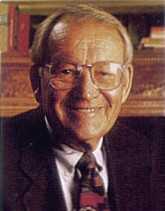
|
| Paul Elwood |
Paul Ellwood once enjoyed the title of Father of the HMO, while the captains of industry who came so close to pushing HMOs down the nation's unwilling throat remain invisible, quite willing to let Bill and Hillary twist in the wind for the near-miss. In the fifteen years since the Plan was dropped by Congress, 10,000 major employers coerced their employees into HMOs; endured much greater employee resistance than anticipated; and watched in dismay as administrative costs ate up the savings. The National Business Coalition for Health has been transformed from its intended role into an information system for encouraging, testing and swapping experience about minor enhancements and tweakings. Much ado about, well, less than was hoped for. But in spite of all that, let me state right here that it would only take one fundamental change to make the HMO model into a popular and desirable system.

|
| HMO |
There's an underlying truism about all effective cost-saving measures in a service industry: regardless of whether you eliminate waste or cut into essentials, you have got to fire a whole lot of people. If you fire the loafers, the quality of your product is improved; if you fire the productive workers, the product is injured. The third choice is to streamline your production methods; you may maintain high quality in spite of firing some good people. But no matter how you go about it, if you are successful, it will be the result of putting good managers in charge. The American Academy of Actuaries once calculated waste in the American healthcare system to be 30%, but in spite of opportunities of that magnitude, the present design of HMOs cannot seem to do more than barely break even. And that is in spite of wide-spread dissatisfaction with denials of care, inconvenient service, and increased paperwork. There's a tragedy here. The alternative model has already been tested, shown to reduce costs, and produced the general satisfaction of both patients and physicians.

|
| Kaiser physicians |
That model was the original one, called the Foundation for Medical Care, devised in Stockton and Sacramento California in the 1950s. The Foundations were expressly created to compete with Kaiser-Permanente, both for patient satisfaction and cost-effectiveness, so judging their success is simply a matter of getting out the records and submitting them to impartial evaluation. The Foundation movement was brought to a dead stop by the legislation which enabled the present employer-based version of HMO, as well as an unfortunate Supreme Court Decision (Maricopa) whose evidence was never put on trial, but based on a motion for summary judgment. The central underlying difference between an HMO and a Foundation is that an HMO is run by an insurance company, while the Foundations were formed and controlled by the physicians who worked for them. While it might be argued that circumstances have changed in the last thirty years, it still seems reasonable to suppose that physician-run HMOs remain superior to the present insurance company-run variety. The reason for this confidence is the benchmark of Kaiser-Permanente, whose only difference is that Kaiser physicians are paid salaries, and a few of the affiliates own hospitals. Kaiser systems are at present having a serious struggle in competition with an insurance company owned HMOs. Some years, some branches of Kaiser are profitable, sometimes they lose money. The triumphant flag that Foundations waved in their heyday was, "We beat Kaiser."
So where is the problem? Actually, there are two. The Foundations were usually although not invariably set up as non-profit corporations because of squeamishness of the doctors about the appearance of self-dealing. That eliminated both insurance profit and incentive to interfere with payments, although it naturally displeased commercial insurance companies. Since I can name at least two HMO operators who rewarded their CEOs with more than a billion dollars each, you can understand the displeasure with the non-profit competition. The other resistance came from hospitals. The Foundation system of utilization review put a weapon in the hands of the attending physicians in their eternal tension with hospital administrators, giving the administrators little choice but to do what the physicians wanted. Essentially, what the physicians wanted was for hospital quality to be maintained while any cost cuts affected hospital revenue before they affected physician revenue. The predictably unfortunate consequences for the hospital were held in check by opening staff privileges to physicians who were not participants in the Foundation. Their vigilance and competitive power were on the side of the administrator, for the benefit of their own patients in the common hospital. Kaiser, by contrast, usually found that owning closed-staff hospitals was itself a major headache.
A hidden advantage to shifting control of healthcare to physicians is that the system acquires the management talents of the staff physicians, essentially without charge. The plain fact is that most physicians hate administrative work, and it comes closer to the facts to say that physicians abandoned management chores than to say they were deprived of them. And just in case it needs restating, it is easier to teach management to a physician than to teach medicine to administrators. While there may be some initial fumbling, physicians are the logical group to be in charge of the management of a medical system, and indeed most lay people suppose they are already in charge. Unlike the situation just after World War II, physicians would now have much more enthusiasm for administration. Not only are their own incomes suffering, but they see their product beginning to disintegrate. And it has not escaped their attention that most large-hospital administrators are paid more than a million dollars a year. No doubt physician income would be enhanced by shifting from HMO to Foundation, but less than you might suppose. Physicians are a censorious lot.
Technical footnote: Two technical obstacles must be overcome before Foundations for Medical Care -- HMOs run by physicians -- can be restored to viability. For sixty years, insurance has been regulated by state governments as a result of the McCarran Ferguson Law. Large corporations doing interstate business have found it quite unworkable to comply with fifty different regulators and were given relief by a Federal law called ERISA. ERISA is so large and complex as a consequence of a large number of trade-off compromises, that for many years it was deemed impossible to amend it in any way. That gridlock was broken in 2006. The Supreme Court decision in State of Arizona v. Maricopa has always seemed dubious as a result of a 4-3 decision which lacked a majority at the time it was handed down, and in any event, never had a hearing on the evidence. The decision was based on a technicality related to a motion for summary judgment. With the passage of time and changing the membership of the Supreme Court, it is easily possible to imagine a reversal of this decision.
On a political level, the climate of opinion has also changed. Insurance companies, and quite possibly hospitals, might well resist. However, it is the business community which supplied the main political force for the present version of insurance company-controlled HMO. Since that model has proven to be a disappointment from the employer perspective, but the cost problem has become much worse, it may now be possible to persuade business to allow a competitive model to emerge.
Healthcare Reform: Looking Ahead (1)

|
| baby boomers |
By this point, a patient reader of these reminiscences has probably learned quite enough about the Clinton Health Plan and its immediate aftermath. There is, of course, more to say, but except for political junkies, the topic doesn't warrant protracted dissection. It might be worth knowing the motivations of the insurance industry when they launched that bombardment of "Harry and Louise" television advertisements. Opinion within the insurance industry must certainly have been divided, however, and the main decision makers are probably all now retired. The Harry/Louise ad campaign is often given credit for the political assassination of the Clinton Plan, but that seems unlikely. The decisions about medical care were made without heeding the opinions of providers of medical care, so it would not be surprising to learn that decisions about insurance were made without completely candid discussion with insurance professionals.
In fact, grieving too much for the past may have led to looking too little at the future, which clearly contains a whole new set of facts. When the largest generation in history, the baby boomers, start to retire in 2012, those boomers own children will then be at peak earning power but will be a very small generation, too small to support their more numerous parents. Consequently, the 12.5% tax the current teenagers pay for retirement benefits will be too small to pay for their parents' health costs. It will be uncomfortable to increase that 12.5% by much. Thus, the Ponzi scheme we have run for eighty years will then be unable to conceal its facts with talk of trust funds and lock boxes. For nearly a century, Congress has spent the Social Security and Medicare tax surplus for non-medical purposes. They will have to stop doing that in less than ten years. Consequently, we can confidently expect the boomers to protest loudly: they contributed 12.5% of income during their whole working lives to support medical care, and now learn that nothing was saved for their own health care. Even more exasperating is that the second Bush administration did attempt to introduce legislation in 2006 to set aside some current surplus to reduce the impact of the coming crunch -- and Bush was howled down. It would thus appear to be the nature of current politics that this boomer health cost shortfall will not be seriously addressed until the crisis is actually upon us. Democrats will apparently stonewall the matter to avoid blame for designing and ballyhooing a welfare expedient of the 1930s that was swept under the rug during decades of affluence. Republicans will be determined not to be paymasters for a welfare scheme they had opposed from the beginning. So what will happen?
Government only has two options in funding programs where the money has already been spent; they can raise taxes or they can borrow money. By raising taxes, they risk precipitating an economic depression. By borrowing, they flirt with hyper-inflation of the sort that destroyed Germany and Austria in the 1920s. By adopting a little of both remedies, we wander into "stagflation", a term invented in the 1970s to describe a very unpleasant episode. Whatever the description, there seems a very strong likelihood of economic pain and political uproar. It sounds pretty unlikely the public will be in a mood for expensive additions to health insurance coverage.
All this is a preamble to impending cuts in the health budget. We must anticipate the only approach government ever uses for program reduction, the only arrow in the government quiver. It goes like this: first you cut a program budget by, say, ten percent and watch to see if anything bad happens. If nothing bad happens, cut it again. If something bad does happen during a series of cuts, deny that it did happen, and scramble around to patch up the damage. If possible governments restore some of the cuts when they go too far, but in Medicare whose unfunded deficit is in the trillions of dollars, that may not be possible. Try to get re-elected after you pull off one of these capers, and you begin to sense how dictators get into office. It really isn't comfortable to talk apocalypse this way, and one would certainly hope there is some flaw in the prediction. There could be other unexpected events in the meantime, deus ex machina, but a stock market crash, a thermonuclear war, or violent changes in the environmental temperature are all going to weaken the world economy, not make things better. This doomsday scenario seems almost certain to include some serious cost-cutting in the health financing system. Therefore, it is only common sense to examine what advance changes might be made in the health delivery system to minimize the damage to it.
My proposal amounts to suggesting that we put the doctors in charge of the cost-cutting. In accident rooms, battlefield medical stations, and even television war serials, the person in charge of sorting out the influx of unexpected casualties is said to be in triage. In triage there is one basic rule: put your best man in triage. If the security guard, the admissions clerk, or the night watchman directs the emergency down the wrong corridor, the ensuing blunders will cascade as the system struggles to get things back on track. We can expect objections to what I have to propose which will take the form of warnings about letting foxes watch the henhouse, but in general, the public already supposes the non-physicians will step aside for the doctors in an emergency. So the more open the discussion about command and control, the better, with ultimate faith that the public will support the common-sense approach of putting your best-trained person in charge.
For present purposes, the general proposal is that when drastic cuts in budget get imposed, it should be the physicians of the local community, not the administrators or the insurance executives or the local business leaders -- who should make the painful choices between what is essential and what can be sacrificed. This is most readily achieved by setting aside the Maricopa decision and clarifying the HMO enabling acts to the effect that it is not an antitrust violation for physicians professionally practicing in nominal competition to participate in the shared governance of health maintenance organizations. In other words, that HMOs such as the Maricopa Foundation need not fear antitrust action, using the experience of a dozen other Foundations for Medical Care as proof of the harmlessness of the approach. It should not be necessary for these organizations to prove positive value, only to demonstrate lack of harmfulness. If they can be established and allowed to compete with insurance-dominated or employer-dominated HMOs, their worth can be established by success in the marketplace. Ultimately, the choice of governance form will thus be made by the patients, and the proposal should be a popular one.
It should also be popular with hospital administrators. They chafed at physician control thirty years ago, but that was before they encountered the far more brutal price negotiations of HMOs dominated by business and insurance. The consequent costly and disruptive wave of hospital mergers is defended by very few, although it would be interesting to examine dispassionate analysis. Probably no one adequately appreciated the threat that employer domination of these practice groups represented to hospital administrations. When hospitals confronted employer groups in serious hard price negotiations, hospitals came to the shocking realization that these people actually had the power to move large groups of people to a competitive hospital, and they certainly talked as though they were capable of doing it. The resulting panic of hospital mergers, consolidation into chains, and the emergence of for-profit competition by hospitals that had no thought of a charitable mission, has created a degree of cost and disorder that was not in the original plan. Hospitals in rural California who told their colleagues of the burdensome power of their staff doctors under doctor-run Foundations would now have to admit that a return to that environment would be a distinct relief.
And there might even be a reconsideration by business leaders. What physicians would bring to the table, what is now new and different, is the undeniable experience that dominating captive HMOs has not proved as useful to employers as they hoped it would be. The cost savings have been disappointing, the exploitation by insurance intermediaries, and the undeniable employee restlessness was not exactly anticipated. Running employee health projects is a large distracting time waster for C.E.O.s who have other goals and mandates to pursue. If employers keep a focus on their reason for involvement in employee health, hardly any of them could defend a posture of resisting the emergence of new choices which make a reasonable claim to reducing employee contentiousness, at a competitively lower cost.
And the government? Among the various unpleasant alternatives that Congress must consider, is the possibility to be discussed next that employers may want to pull out of employee health care entirely. Allowing competitive forms of ownership of existing arrangements might not seem too risky a step, compared with that prospect.
Healthcare Reform: Looking Ahead (3)
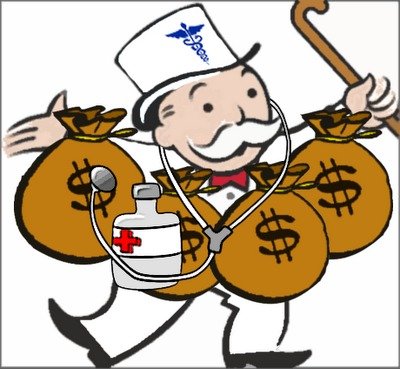
|
For fifty years, turmoil in the health insurance industry has originated in the steel and auto industries. It seems strange that no heroes have come to general public attention, although there may be heroes who are known to insiders; somebody may yet write a book about it. This may be of only passing importance, but the present distress in the American Big Three automakers suggests that unexpected legislative proposals concerning health financing could emerge from that direction. The turmoil in Detroit once centered on the auto industry enjoying windfall profits which labor wanted to share. More recent discord comes from the opposite direction: the automakers now cannot afford to honor those contracts they signed with labor having to do with health benefits.
The contract for the United Auto Workers was certainly generous. Printed up in a little red book for wide distribution, the contract states emphatically that an employee for six months or more will be completely covered for medical expenses for the rest of his life. If Medicare pays some of the cost, that is fine, but if Medicare reduces its benefits, the employer is liable. Some features of this contract may have been changed since it was printed, but it is difficult to imagine what incentives the UAW would have to agree to modifications. Except, of course, the self-interest which emerges when it looks as though the employer might go out of business unless there is some form of relief from wage costs.
To judge what is going to come of this is to judge the likelihood of the various arguments, predictions, and recriminations that are so common in heated disputes. Two things are pretty clear to auto industry outsiders: the UAW contract provides more generous health benefits than almost any other employee group enjoys, while the auto industry has worse earnings than many or most other industries. Consequently, both the employees and the stockholders have an incentive to make adjustments in the auto industry, a situation shared by the steel industry and other major auto suppliers. The form this has seemed to take is to favor some form of national health insurance, in which the taxpayers would take over the obligations of the auto manufacturers. So, look out for proposals from Senators and Congressmen from Michigan, and watch which nominees for U.S. President are favored by the rust-belt political delegations.
Workers in other industries are not certain to go along with such proposals. After all, most people resent it when someone else makes out better than everyone else for decades, and then comes asking for a hand-out.
Segmented Health Insurance

|
| Pie Graph |
Everybody knows the old insurance saw, that the big print gives but the small print takes away. If health insurance pays for one sort of thing but not another, there is anxiety that a bewildered patient can be deprived of coverage he thinks he paid for. A patient knows he was sick, that he saw a doctor, or that he went to a hospital; beyond that, it's better not to leave room for arguments. To a certain degree, this is what has made HMOs seem so threatening; complicated assurances can lead to disappointing loopholes. So, for a century it has almost been an article of religious faith that health insurance should cover everything that costs money when you are sick. However, that headlong faith is exactly why the matter needs to be subject to critical review. Not only does monolithic insurance conceal a vast system of cross-subsidies. It has existed for too long when everything else in Medicine has changed for the original premise to be immune to change.
There are health insurance considerations which go beyond mere convenience of administration. Transparency and flexibility, for instance, suffer when everything is under a single blanket. Women pay a share of prostate surgeries they will never have themselves, people who hate abortions have to pay a share of them anyway. The ability to buy what you think you need is taken away, so some people who could afford what they need are unable to afford the whole package because it includes what they feel they would never need. And then there is moral hazard. Some people reach for what they don't need just because it costs nothing extra. Well, this isn't 1930; we don't need to debate the whole issue top to bottom. But there may nevertheless be a few features of global health insurance which could be advantageously teased out separately.
For a first example, look at terminal care. Everybody is going to die, and mostly the cost is picked up by Medicare because most people who die are elderly. Some insight into the issue and a reasonably workable definition of terminal care is provided by the statistic that a third of the expenditures of Medicare is paid for someone in the last year of life. Statistics on the average age at death are known with great precision, so it would be easy to calculate the yearly premium cost at any age or the size of a single-premium policy needed at any age to cover the average cost of the last-year-of-life. If we are ever to fund the unfunded Medicare program, this is the place to start. And if you are wondering how you know in advance when you are going to die, you don't need to know. Just establish an independent "endowment" fund, which reimburses the current Medicare program for any expense incurred during what proves in retrospect to have been the last year. Presumably, the cost of running the unfunded portion of Medicare would then drop by a third, while the cost of the funded third would be diminished by the investment strategy of its manager. The relatively few people who die without Medicare eligibility might be treated in the same way, reimbursing whoever paid the costs, but the risk calculation would be more difficult, and a life insurance policy might be preferable. Once the younger individual with such a designated life insurance policy attained Medicare eligibility, some sort of coordination would be desirable.
Everyone dies once, and no one escapes death. But terminal care benefits are not so terribly different from some other health issues. Nowadays, just about everybody can expect to have two cataract operations, and most people can expect a hernia repair, a gallbladder removal, and if male a prostate removal. Everybody ought to have a pneumonia immunization, and a colonoscopy, by age 66. It would be easy to compile lifetime risks and update them yearly, for the typical male with 1 death, 1 pneumonia vaccination, one colonoscopy, 0.76 prostatectomies, 0.59 cholecystectomies, 0.37 hernia repairs and so on. The cost of this sort of routine care is not really insurance, it is pre-payment. It is not subject to abuse, and need not be challenged or reviewed unless statistical monitoring shows that the incidence of some component was rising in a particular zip code area. In that case, what would be called for would not claim review, it would be provider review.
Perhaps the reader can see where this is going. Having stripped out routine pre-payment as much as is practical, you are left with the unknowable "all other". Insurance which covers this sort of risk becomes true insurance, in an umbrella form. As medical care continues to advance, more things can be moved from "all other" to "routine". Ultimately, and probably sooner than most people would guess, you can achieve a true insurance system, defined as having a trivial insurance premium for a remote risk. From that point forward, you can direct your cost-cutting attention to reducing the cost of routine care. That would include the devising of strategies to pay for luxury versions of routine care, as desired.
Money Bags
This little morality tale was told to me by two unrelated sources, one of whom was a staff aide to Wilbur Cohen, the author of the Medicare law. And the other was a high official of Pennsylvania Blue Shield, the appointed administrative agent for Medicare in Pennsylvania. Its relevance to the more recent SNAFU with Insurance Exchanges introducing the world to Obamacare should be fairly obvious.
After Lyndon Johnson rammed the Medicare amendment to the Social Security Act through Congress in 1965, he wasn't shy about drawing attention to it. The press was present in great numbers, with staff officials who had a role in crafting the document, members of Congress, and anyone else who was standing around. The legislation was laid before him and signed with twenty different pens to be presented as mementos to the in-group. Each pen was only used to inscribe about half of one letter of his name, so it was a slow but joyful process. As intended, it got lots and lots of publicity.
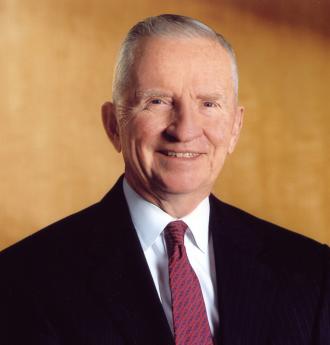 > >
|
| H. Ross Perot |
So, thousands of thankful old folks saw the ceremony on television, though they heard that the law was in effect immediately, and proceeded to dump their medical bills into a shoe box, sending them to Medicare to be paid. Unfortunately, Medicare didn't have an office, a staff, or even a telephone number. These things take time. As fast as they could, the Medicare staff constructed a system of carriers and intermediaries, carriers for part A, and intermediaries for part B. And almost without exception, appointed the local Blue Cross and Blue Shield organizations to be the carriers and intermediaries. Consequently, the organization of Medicare was patterned closely after the organization of the two administrative corporations. Meanwhile, the bills from old folks just kept pouring in through the postal service. It was about all the staff in Washington could do, just to direct the mail out to the local intermediaries and at least get it out of their hair.
Less than a year later, that's how the claims manage to Camp Hill, PA, a little suburban town near Harrisburg. In desperation, Blue Shield had rented a local vacant supermarket and piled the mailbags ten feet high. There were quite a few telephone calls of inquiry, and the old folks were politely told the matter was being looked into. It was beginning to look as though one supermarket wasn't big enough.
Computers were, of course, rented from IBM, who had a policy of renting, not selling, its valuable equipment. Keypunch operators, computer operators were hired, air conditioning was installed, and one team after another of computer programmers was hired -- and fired. Consultants were called, scratched their heads, sent big consultation bills, and turned sadly away. Sorry, but somehow it just doesn't work.
So that's how it happened that one Friday afternoon, a vice-president of Texas Blue Cross named H. Ross Perot came in, accompanied by a fellow with glasses so thick they looked like the bottom of Coca Cola bottles. So far as anyone can remember, the guy with coke-bottle glasses never said one word. The desperate, hopeless mess was explained to Perot, whose salary at that time was rumored to be twenty-five thousand dollars a year, about right for a Blue Cross executive. His background as a kindred Blue Cross person inspired confidence, and the conversation rambled on for an hour or so. Meanwhile, the guy with coke bottles went over to the Penn-Harris Hotel across the street and got to work. By the end of the weekend, he had come back a couple of times, but eventually, would you believe, it really, well it really worked. Contracts were quickly signed, the wheels began to turn, the mailbags in the supermarket began to march through the processing cycle. Blue Shield, the Medicare program, the finances of the nation's elderly, and Lyndon Johnson's reputation -- were all rescued.
As everyone now knows, the Medicare processing contracts made Ross Perot into a billionaire, living on Bermuda in the lap of luxury, eventually upsetting the re-election hopes of George Bush, senior by running for President himself on a third party ticket that had something or other to do with giant sucking sounds. A Congressional investigating committee looked into the outrageous profits Perot had extracted from his homeland's elderly, volleyed and thundered. Whether Perot actually thumbed his nose at them is doubtful, but he certainly was in a position to do so.
Meanwhile, whatever happened to that guy with the coke bottle glasses, no one seems to know.
Making Money (8): Virtual Money
 When money was tangible you had to guard it, now that it's mostly virtual you have to verify it. Hardly anybody can, and that's a problem. 
|
When money and wealth were wampums, precious metals, and paper currency, these physical objects required physical protection. It was all a big nuisance, with six-guns on the belt, bank vaults, and appraisers of one sort or another. But now that wealth is merely a bookkeeping entry on someone's computer, things may be even more nuisance because verification is almost beyond us. Counterfeiting of the computer variety must be left to institutions to detect or deflect, causing them to introduce firewalls of various sorts that also block legitimate inspection by customers. "Trust but verify" doesn't work so well in this environment. Let's use a personal example, slightly fictionalized to protect the innocent.
Several software products now exist to download transaction information automatically from various institutional sources to a customer's home computer; they are either free or cost a nominal amount, and are quite "user-friendly". In my case, however, the reports they generated were quite significantly at variance from the monthly reports which were issued directly by my counterparties. Dear Sirs, Please explain.
What I soon discovered was that everyone blamed someone else, and everyone blamed me for bothering them. Quite obviously, I had little understanding of these specialized accounting niceties, and quite obviously I had too much spare time on my hands. Telephone help desks, often located in India, will not give out telephone numbers for incoming calls and are programmed to check the size of your account before placing you in a call-back queue. The first call is usually taken by a trainee whose job it is to screen out the silliest sort of help request, and then to refer to a supervisor if things rise in complexity. Supervisors have supervisors. That's if you are lucky. More commonly, the tedious software business has been farmed out to a vendor, and the contracting agency has neither the necessary understanding of the issue nor any ability to fix it. From the sound of it, the vendor often gives the contracting agency the same sort of isolation treatment that they would give a customer if he could find their telephone number. And guess what. At the end of the day, one of those high-handed defensive linemen -- turns out to have been at fault.
Let's explain one problem. On the surface, we were talking about a $40,000 difference in account balances; one may have been correct, but a second one must have been wrong. That rises to lawsuit level, so the matter got intensive study. It turns out the stockbroker had misinterpreted instructions for a "sweep-account" system. When a stock in your portfolio pays a dividend, the amount of the dividend is subtracted from that stock's line item and added to the line item of your money-market fund. That's fine, but there is one exception. When the money market fund itself pays a dividend, subtracting that dividend cancels out the addition, and the dividend essentially disappears from your net worth. Was this intentional? Certainly not; no one could stay in business doing that. It's not even a highly stupid error, since you can easily see yourself making the same oversight of the one implicit exception to the rule of sweep accounting. Because of this "bug" in the program involved one institution making a mistake and transmitting it to a second institution, the systematic error did not unbalance any books, until it reached mine. But since I did not detect the error for five months, there must be dozens, hundreds, maybe thousands of customers who did not detect it. Ouch. Do the math yourself to judge whether this was a serious error.
This illustration, only one of several on my personal report, leads to at least two larger principles. The first is that the transformation of money from tangible to virtual has occurred so rapidly that bullet-proof safeguards have not had time to emerge. After a century of use, most people cannot balance their checkbooks, but enough people can balance them so that systematic errors are not likely to slip past. When enough people with home computers repeatedly test the internal complexities of their virtual money accounts, confidence will develop that the system is probably working. Confidence is an important matter; it is possible to imagine quite a bank panic if the public suddenly got the idea that virtual money is maybe a mere vapor. In fact, the securitized credit panic of 2007 is a little like that. With a few new regulations and a lot of computer programming it surely will be possible to know who owns how many bum mortgages. That innovative mortgage system got ahead of its tracking verification, and we now just have to hope nothing serious happens before that gets fixed.
The second important lesson is that our health insurance system has a similar problem of far greater size and complexity. We are here talking about at least ten percent of Gross Domestic Product, in which one daily unit of measurement is in truckloads of insurance claims forms. Stocks and bonds are admittedly complicated but compared with thousands of different diagnoses, drugs, procedures, and hospitals -- verifying financial transactions is trivial compared with measuring medical ones. With a twenty billion dollar budget and ten years of lead time, we might have a shot at it. Except for the fact that during the ten-year interval, medical care will have changed so much, you will have to start over on the project.
Exit, Pursued by a Bear

|
| John Kastor |
Everybody ends up getting fired in a recent book by John Kastor about recent events at the University of Pennsylvania just like everybody ending up dead in an Elizabethan play. The vital difference, of course, is that the dramatis personae at Penn can still relate to a bewildered audience their own versions of those grand events. To protect himself, the author peppers his book with more footnotes than a Ph.D. thesis. And thousands of stakeholders at the University can now realize that during those eventful times they were as clueless as Rosencranz and Guildenstern.
One basic fact about that institution is that the medical school spends three-quarters of the entire university budget. That leads to grudges in the little law school, the little engineering school, and the little president's office, as they knuckle under to the Golden Rule. The department chairman with the gold makes the rules. Since most of that gold comes from research grants, hence ultimately from the federal government, the medical students and the teaching faculty don't have the same power they had during the Vietnam War era, either. Although medical school tuition imposes a crushing burden on the students and their families, leading to debts close to a quarter of a million dollars apiece, the tuition money doesn't amount to much in the university scheme of things, either. In some schools, tuition amounts to two percent of the medical school budget. You could eliminate the students entirely and not see much difference in the "school".
Unfortunately, when you become dependent on government grants, you find they can suddenly be terminated, or awarded without funding, or held up for several months by Congressional bickering. Meanwhile, there are salaries to pay, contracts to fulfill. Even if you can furlough some of the staff, it's not easy to see what you do about a thirty-year mortgage on a research building when there is a lull in its research funding. If you try to save money, the granting agency will try to get it back; they aren't authorized to make grants to be squirreled away. If you shift money to unauthorized uses, you risk going to jail. And yet, if you don't do something along those lines, the whole enterprise can collapse.
Having said that much to be fair, it is still uncomfortable to see the financial transparency of our most valued nonprofit institutions vanish behind a Byzantine fog of secrecy, out of which arise the magnificent towers of new buildings, and in front of which an occasional limousine is to be observed. No wonder the research scientists feel the constant pressure to produce. A Nobel Prize every ten years, or so, would go a long way toward quieting envious remarks from the liberal arts faculty.
Housed in those ivy towers are three institutions, the teaching hospital, the medical school, and the university, with three boards of trustees, and at least three ruling potentates. At irregular intervals, congressional committees do things to the Budget Reconciliation Act which enrich one of the three components of the institution or suddenly impoverish another, or both. Integration of the three under one governance sounds plausible until you notice how radically different is the mission of each one. You can take a big building away from one component and rent it back to them, and things like that, but you can't do it without starting whispers about Enron. You can gather up surplus funds from one of them during the decade of the eighties, but you have trouble giving it back twenty years later. Officials at Blue Cross come snooping to see if health insurance premiums are passing through this shell game, ultimately paying salaries in the department of English Literature. Everybody distrusts everybody else, somebody sasses somebody, and everybody gets fired.
Nothing unusual about that. It happens at every medical school.
War Dance
History Footnote: Before the white man came, the Iroquois "nation"devised rules still characteristic of our modern political parties. At various times, there were five, six, or seven tribes in the Iroquois confederacy headquartered in upstate New York, allied to each other with fluctuating loyalty. Philadelphia's tribe were Delawares or Leni Lenape, but the most warlike and dominant tribe were the Mohawks. Confederations work best when allied against a common foe. The rest of the time, member tribes mostly beat and cheat each other.
The Philadelphia Democratic Party appeals to a number of minority groups and recent immigrants, but it is more meaningful to think in terms of players. For example, university professors are mostly Democrats, but the teachers union is an active political player. Minorities generally vote Democratic, but the Black Ministers are players. Lawyers are rather evenly divided between Republicans and Democrats, but Plaintiff Trial Lawyers, the ones who sue people for a share of the award, are players.
Some people are players but keep it quiet. Certain rich donors are players but don't want to be known as such. The chiropractors and optometrists claim to be players but would rather not have the truth known. The news media and utility companies come close to denying they are players in spite of abundant evidence otherwise.
Well, the local players had a war dance just before the November 2005 elections; the timing was no accident, and it was publicly described as a SEPTA contract negotiation. The issues had mostly been settled in advance, but the real deal-breaker was health benefits, Blue Cross health insurance paid by the employer to escape income tax and to make the pay packet appear smaller to the taxpayers. Step by step for twenty-five years, employers in the form of the Republican politicians had been keeping up a steady drumbeat, trying to reduce the incentive to overspend health insurance because it seemed free, with resulting increase in employer costs. Slowly, business management convinced a majority of the public that "first-dollar coverage" was a villain, since the person covered by the insurance has no skin in the game. Even party loyalists had to admit that it looked as though the tax exemption of health insurance was injuring the image of labor. That concept carried the slogan of "sending jobs to China", or killing the goose that lays golden eggs in the Rust Belt. Five million Health Savings Accounts were sold in 2005 in spite of state laws hampering this form of health insurance, and from experience it seemed certain that five times that many would be sold if early-adopters reported satisfaction. The surrogate was deductibles and employee contribution to health insurance; just about everybody recognizes the need to make some token contribution to health insurance in order to have skin in the game and keep costs down. But not the SEPTA workers. In 2005, the brotherhood of Septa workers would go on strike for fifty days rather than pay one penny of "give-back" for health insurance. Their energy level was high, they were waving their arms, they were ready to overturn ashcans.

|
| Bellevue |
When union contract negotiations go on for days, all day, the public gets an idea the negotiating table is a shouting match the whole time, with "negotiators" carrying on with tom-toms and tomahawks in an even more physical and extreme model for their supporters on the street corners. For about ten minutes a day, that's true. But then the television people can turn off their lights and the war hawks fan out to talk with their supporters outside the room, which in this case happened to be in the Bellevue Stratford Hotel. Perhaps you didn't know the Pennsylvania Governor has quite a nice set of offices there. Perhaps you haven't noticed that all the parking spaces on the side alleys near the Bellevue "belong" to various politicians. Just try parking there yourself to learn a few facts of Philadelphia life.
In negotiating classes, they teach you never to make the first concession. By that reasoning, no negotiation would ever end. The more practical advice is to forget about any serious bargains until the last day of the contract, or even a couple of days after that. The hard reality is that no one will make a concession while there is time for some invisible player to back out; no one wants to give his constituents time to realize he has sold out their trust or violated their loud, insistent, wholly unrealistic demands. And so in 2005, after the shouting had gone on for some time, and even a real strike began, the Governor finally sauntered into his nice Philadelphia office. Time to get to work.
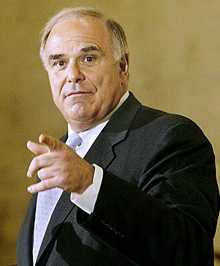
|
| Ed Rendell |
Those who didn't know him made the comment they could almost believe he was a victim of Attention Deficit Disorder. He talked all the time, moved all the time, and apparently showered all the time. That is, he was in and out of sight all night, but invariably reappeared with fresh shirts, clean shaves, and sharp creases. His aides confided he wasn't very good at "detail work", which is to say he conducted the whole affair on a primeval level of dominance, bluster, charm and implied threat. Don't bother me with facts. Mayor Street, on the other hand, would come in and mumble something incoherent, and then had to leave for an important engagement. Word came in that the school teachers felt they really had to pay a small health insurance deductible, and it wasn't so bad. Foo, no guts.
Somewhere along the line, the newspapers started to echo that deductibles had their merits. Foo, bunch of Communists. The black ministers were reported to feel that if their people all had to pay deductibles, why couldn't the transit workers. Bah, bunch of muddleheads. In the hubbub, someone asked what Andy Stern thought. The trial lawyers didn't have as much to say as they once did; SEPTA had reduced liability costs by $87 million through adamantly refusing to settle any case without going to court. Paper tigers. What about chiropractic benefits, we demand the inclusion of chiropractic benefits. No, said SEPTA, we aren't going to agree to any of that sort of thing. Well, what about twenty visits a year to chiropractors?
One by one, the other players deserted the SEPTA workers. The message from the other tribes in the confederation seemed to be, get what you can for SEPTA, but stop the strike by election day. The Governor produced the razzle-dazzle, a loan to the city to pre-pay the Blue Cross premium, in return for which Blue Cross would reduce the premium. The effect of that was to produce enough cash to appear to add ten cents an hour to the pay packet. We'll have to wait a year to see how this money gets restored to Blue Cross, but that's the general idea.
The strike was over, hurray. The next day, the Democrat party elected Democratic governors in New Jersey and Virginia, defeated some California amendments which would have hurt the trial lawyers and teachers unions. Surely, someone in the Democrat party nationally was telling himself that caving on the Philadelphia transit strike was a small price to pay for that.
Nation's First Hospital, 1751-2016

|
| Pennsylvania Hospital |
As commonly stated in medical history circles, the history of the Pennsylvania Hospital is the history of American medicine. The beautiful old original building, with additions attached, still stands where it did in 1755, a great credit to Samuel Rhoads the builder and designer of it. The colonial building on Pine Street stopped housing 150 patients around 1980, supposedly at the demand of the Fire Marshall, although its perpetual fire insurance policy still owes the hospital several thousand dollars a year as an unspent premium dividend. There may have been one small fire during two centuries of use, but its true fire hazard would be difficult to assert. It was just out of date. The original patient areas consisted of long open wards, with forty or so beds lined up behind fluted columns, in four sections on two floors. The pharmacy was on the first floor, the lunatics in the basement, and the operating rooms on the third floor under a domed skylight. It was entirely serviceable in 1948 when I arrived as an intern doctor. Individual privacy was limited to what a curtain between the beds would provide, but on the other hand, it was possible for one nurse to stand at the end of the award and recognize any distress among forty patients immediately. In this trade-off between delicacy and utility, the utility was certain to be preferred by the Quaker founders. Visitors were essentially excluded, and if a patient recovered enough to be unnaturally curious about neighboring patients, well, he had probably recovered enough to go home.
Located between two large rivers, South Philadelphia up to ten blocks away was essentially a swamp until the Civil War. So, there were seasonal epidemics of malaria, yellow fever, typhoid, and poliomyelitis at the hospital until the early twentieth century. Philadelphia was a port city, so sailors brought in cases of venereal disease, scurvy, even an occasional case of anthrax or leprosy. During the Industrial Revolution of the nineteenth century, tuberculosis, rheumatic fever, and diphtheria were part of clinical practice. But underlying the ebb and flow of environmental effects, there was a steady population of illness which did not change a great deal from 1776 to 1948. These patients were all poor, because the rules in Benjamin Franklin's handwriting restricted service to the "sick poor, and only if there is room, for those who can pay." In 1948 there was a poor box for those who might feel grateful, but no credit manager or official payment office. The matter had been considered, but the cost of collection was considered greater than the likely revenue. When Mr. Daniel Gill was offered the position as the hospital's first credit manager, it was suggested that he be given a tenth of what he collected. To his lifelong regret, Dan Gill regretted that he refused an offer that he had felt he could not afford to accept.
So, the wards were filled with victims of the diseases of poverty, punctuated by occasional epidemics of whatever was prevalent. And a second constant feature of the patients was their medical condition forced them to be housed in bed. For centuries, physicians dreaded the news that a new patient was being admitted with "dead legs".
Intelligensia, Philly Style

|
| Mac Bus |
On a hot summer evening, attendance at computer user-group meetings is light, so after a recent one got through discussing spammers and new software, we adjourned to the sidewalk tables of a nearby pizza joint, just off Broad Street. United only by a common interest in computer hardware, software, and techniques, this one comes from many corners of the Philadelphia social scene and goes back to those corners after the meeting. Whatever their background, computer geeks are uniformly good at math. But on this particular evening, the conversation turned to medical experiences.
A middle-aged man with a ponytail related he had recently experienced Bell's Palsy, a paralysis of the muscles of one side of the face. The group was fascinated to hear how saliva dripped from a corner of his mouth, and his unclosable eye dried out and got sore. His doctor told him there was not much to do except wait, an opinion confirmed by a specialist. Immediately, this man who makes his living programming computers set out to find the best acupuncture person he could find. It was a familiar story, and I remained as quiet as I could while he essentially related that when the regular medical profession confesses failure, the patient feels released to take matters into his own hands. His instincts were to do something, anything, even if that something was plainly futile. He could not bear the idea of doing anything, and sure enough, in time he got better.
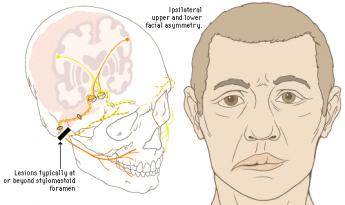
|
| Bell's Palsy |
I said nothing because it was a familiar reaction to conditions that either would or would not get better by themselves. The more serious studious members of our little club were quiet, too, because their instincts were to do what they were told, and in his place wouldn't have acted the same way, didn't completely approve. In a moment, a large muscular man took up the medical subject by telling that he had spent two years in a hospital after falling down an 18-story elevator shaft. Man, oh man, it seemed like it took two weeks as I was going down, and when I hit I wasn't knocked out. He had landed on one buttock and his leg was nearly wrenched off, but he remained awake, not bleeding much. Within minutes, he was headed for an operating room and reached out to grab the clipboard from the nurse. On it was written "amputation", which he circled, wrote "No amputation!!", dated and signed it. No way were they going to cut off his leg. His leg was in fact saved; he now scarcely walks with a limp. Then another computer nerd chimed in.

|
| Motorcycle Jump |
This man's story was that he spent fifteen months in a hospital after a motorcycle accident. He somersaulted seven times through the air before he landed on his chest, and twenty years later he could still remember every single twist of all seven turns. He, too, related many hospital disputes about morphine injections and contemplated surgeries. Both men related dubious experiences with young interns and medical students, and numerous proposed remedies that had been rejected. All three of these medical veterans expressed violent hatred of HMOs, for reasons unspecified. I was quiet; no argument from me. This motorcyclist eventually had his vehicle repaired and proceeded to ride it for six more months until he sold the machine. So there.
We all had different thoughts about this, I suppose. I was lost in thought about why they had survived and imagined that not being knocked unconscious meant that they had not hit their heads. Heavily muscled men like this were probably cushioned by their muscles; a skinny little bony nerd would have been much more smashed up. The negative side of that protection came out in hearing them both describe their heart problems, with by-pass surgery and whatnot later on in life. That's probably the negative side of their muscularity. Neither man smoked, but I bet they both did at one time.
As we strolled home from the pizza joint, it occurred to someone that the national political conventions were on television that evening. The women were fighting with the blacks. The studious nerds were silent; the wild men merely grunted. That didn't seem like something to fight about, or even to comment on.
As I walked into the darkness, I wondered if such a conversation would seem normal in any other city in the world.
Veterans Hospital

|
| Philadelphia VA Medical Center Home |
At a recent meeting of the Right Angle Club, Stephen C. Bennett an administrator, and Alix Esposito a social worker, kindly addressed the club about the Veterans Hospital where they work. The federal government pushes its mass produced products into every city, but gradually a local flavor starts to creep in; how this process works is illustrated by the fact that Steve's grandfather Claude was once the manager of the Bellevue Stratford Hotel. The VA hospital may be a piece of Washington D.C. planted on Philadelphia soil, but Philadelphia will surely absorb it with the passage of enough time. The VA was once a part of the Veterans Administration, but now it is a part of Department of Veterans Affairs, run by a Cabinet Secretary, no less. It's the second largest department of the federal government, and since the only bigger department is the Department of Defense, the combination of the two shows you how far we have come from the nation's original opposition to "standing armies". The fact that these two components of our war machine are separate, on the other hand, surely symbolizes some hidden tensions between our regular armed forces and the American Legion, or the hidden frictions between two congressional committees, or else some other mystery of bureaucratic politics.
The Veterans Administration was founded in 1930, the Philadelphia VA Hospital was built in 1950. Originally, it was designated as a Deans Hospital, signifying the intention to confer prestige and lessen friction with the medical schools. Originally, Philadelphia's VA was affiliated with several medical schools, but in time its proximity to the University of Pennsylvania led to the elimination of ties with other schools. Although the bed capacity is growing in reaction to America's successive wars, its open wards converted after 1960 to more semi-private style, and its focus of medical activity shifting with changes in medical science, the VA remains isolated from the rest of the city and the rest of Philadelphia medicine. Part of this is physical; the hospital is confined by the University of Pennsylvania, the parking complex next to the Amtrak line, and the Woodland Cemetery, so there is little room to grow. And comparatively little commonality with the neighbors. There are 2000 employees and a $30 million budget, marooned in a sea of automobile traffic going elsewhere in a big hurry, too big to ignore but too small to influence the local culture.

|
| Vietnam War |
The patients are distinctly different from those you find in other hospitals. There is a great deal of chronic mental disorder a heavy influence of alcohol and substance abuse and rehabilitation, and even some residential apartments for patients. On a national level, between a third and a half of homeless people are veterans, but for some reason in Philadelphia, only a tenth of the homeless are veterans. During the Vietnam War, the system of draft avoidance through educational exemptions resulted in that generation of veterans coming from an unusual concentration of low income and low educational subgroups. The system of government pensions and promotions tend to retain employees in the system for a lifetime. It's true that informal transfer arrangements allow a certain amount of migration to Florida (in the winter), or Maine (in the summer), or California (to see what LaLa land is all about), but those who do this stay within the VA system. Consequently, the interchange of ideas and techniques that professionals carry with them between hospitals is curtailed, confined somewhat to variations within the VA system, conforming to its social norms. An archipelago, although not exactly a gulag archipelago.

|
| Veteran |
But by far the greatest source of distinctiveness in the VA hospitals comes from the byzantine eligibility standards for the patients. The reimbursement systems of Medicare, private insurance -- which more or less copy each other -- changed around 1988 in a way that more or less eliminated psychiatric inpatient care in the community, especially if it lasts more than a month. The VA, on the other hand, was forced by circumstances to increase its attention to this area. Consequently, all social workers everywhere inquire immediately whether an addict or a schizophrenic might be a veteran. A differential sorting process quickly gets underway, with the VA as the preferred place to send such patients if at all possible. Non-veteran victims of the same conditions tend to have a worsened time of it, because the pressure on state and local governments to make some provision, has been relieved.

|
| Walter Reed Hospital |
At the other extreme, the social elite of the armed forces are not admitted, either. President Eisenhower was unquestionably a veteran, but he had his famous hospitalizations at >Walter Reed Hospital. There's an income limit for VA admission, which automatically cuts off 20-year veterans above a certain rank, possibly major. And there are overlapping disability classifications for military hospitals and veterans facilities, with considerable latitude available to uniformed boards of three serving officers, only one of whom is a physician. The result is a general perception that if you have any influence at all, you can generally avoid the VA and be treated in a military hospital, probably in a VIP unit. Good for them; I'd take advantage of it if I had a chance, too. But by siphoning off the top brass, a lot of pressure to improve quality is removed as well. If a VA hospital had eight or ten Admirals and Generals as patients, with academy classmates coming to visit, it's safe to assume that courtesy, orderliness, and cleanliness would instantly improve. And take it from me, the quality of care would improve, as well.
50 Blogs
The Hospital That Ate Chicago (1)
 A flash of inspiration gets a medical article published.
A flash of inspiration gets a medical article published.
The Nation's Future Health Profile
As the nation's health steadily improves, it's going to cause some problems of a social nature.
Abortion
 As I recall, our position was likewise greeted by the AMA House of Delegates with great relief, and word quickly circulated in the corridors that Pennsylvania had a position everyone could endorse for the good of the organization.
As I recall, our position was likewise greeted by the AMA House of Delegates with great relief, and word quickly circulated in the corridors that Pennsylvania had a position everyone could endorse for the good of the organization.
Why Are Hospital Prices So High?
 The answer is that they are discounts to insurance companies. People with insurance pay a lower price than those without.
The answer is that they are discounts to insurance companies. People with insurance pay a lower price than those without.
Specialized Surgeons
 Specialty hospitals have actually been given more than a fair try. About a hundred years ago, the landscape was peppered with casualty hospitals, receiving hospitals, stomach hospitals, skin and cancer hospitals, lying-in hospitals, contagious disease hospitals, and a dozen other medical specialty boutiques.
Specialty hospitals have actually been given more than a fair try. About a hundred years ago, the landscape was peppered with casualty hospitals, receiving hospitals, stomach hospitals, skin and cancer hospitals, lying-in hospitals, contagious disease hospitals, and a dozen other medical specialty boutiques.
Medicare/Health Savings Accounts Legislation
What Every Voter Needs to Know
New Health Insurance Reform Proposals
 A Complex Reform Reduced to Brief Essentials:
A Complex Reform Reduced to Brief Essentials:
Or, A Few Bad Apples?
 A few doctors do get sued more than others, but research has failed to produce a simple explanation.
A few doctors do get sued more than others, but research has failed to produce a simple explanation.
Philadelphia in 1976: Legionaire's Disease
 Philadelphia's ambitious Bicentennial celebration of the Declaration of Independence was ruined by an epidemic of a new disease that seemed to focus on tourists.
Philadelphia's ambitious Bicentennial celebration of the Declaration of Independence was ruined by an epidemic of a new disease that seemed to focus on tourists.
Please Don't Lose Any Sleep Over This
 New research suggests that when medical Resident physicians stay up all night working, they get sleepy. When a minimum sleep requirement for doctors was suggested, administrators were a little stunned to find doctors were annoyed.
New research suggests that when medical Resident physicians stay up all night working, they get sleepy. When a minimum sleep requirement for doctors was suggested, administrators were a little stunned to find doctors were annoyed.
Medical Generation Gap

Medical Tort Reform (1)
 Executive Summary.
Executive Summary.
The Blue Cross Discount (6)
 Hospitals customarily inflate many charges so far beyond their costs that you must buy insurance to protect yourself. Whatever the dominant health insurers may be doing to encourage that practice, they are the main ones to benefit from it.
Hospitals customarily inflate many charges so far beyond their costs that you must buy insurance to protect yourself. Whatever the dominant health insurers may be doing to encourage that practice, they are the main ones to benefit from it.
Health Care Rationing, American Style
 American doctors are becoming afraid to test for conditions for fear of raising their patients' insurance costs or getting sued themselves.
American doctors are becoming afraid to test for conditions for fear of raising their patients' insurance costs or getting sued themselves.
Health Savings Accounts
 In late 2003, Congress passed and the President signed, legislation enabling tax exemptions for contributions to Medical Savings Accounts. This monumental reform was included in a law which created a number of Medicare prescription drugs benefits which received more attention in the press. Such accounts were renamed Health Savings Accounts, which was the original terminology in 1980 when John McClaughry of Vermont and George Ross Fisher of Pennsylvania, shortly joined by Michael Smith of Louisiana, first introduced the concept.
In late 2003, Congress passed and the President signed, legislation enabling tax exemptions for contributions to Medical Savings Accounts. This monumental reform was included in a law which created a number of Medicare prescription drugs benefits which received more attention in the press. Such accounts were renamed Health Savings Accounts, which was the original terminology in 1980 when John McClaughry of Vermont and George Ross Fisher of Pennsylvania, shortly joined by Michael Smith of Louisiana, first introduced the concept.
Financing a Research University
 Responding to staggering financial temptations, our most prestigious universities are beginning to put both themselves and the rest of the country at unacceptable risk.
Responding to staggering financial temptations, our most prestigious universities are beginning to put both themselves and the rest of the country at unacceptable risk.
Flexner Report, Revisited
 A new book by John A. Kastor compares the doctor-run Cleveland Clinic with the University-run Hospitals of Case Western Reserve under the managed care insurance system. Both hospital systems had plenty of problems, many of them self-inflicted, but it looks like doctor-run is winning the race.
A new book by John A. Kastor compares the doctor-run Cleveland Clinic with the University-run Hospitals of Case Western Reserve under the managed care insurance system. Both hospital systems had plenty of problems, many of them self-inflicted, but it looks like doctor-run is winning the race.
Friends Lifecare at Home
 Philadelphia Quakers run over twenty retirement communities for the elderly in their region. One of them is a virtual village, one without walls.
Philadelphia Quakers run over twenty retirement communities for the elderly in their region. One of them is a virtual village, one without walls.
A New Food and Drug Category
 The Food and Drug Act demands that drugs be efficacious and safe. There needs to be a special exemption for drugs that are efficacious but somewhat unsafe.
The Food and Drug Act demands that drugs be efficacious and safe. There needs to be a special exemption for drugs that are efficacious but somewhat unsafe.
Cost of Medical Care
 Milton Hershey agreed to fund the Hershey Medical School out his own pocket, after a ten-minute conversation.
Milton Hershey agreed to fund the Hershey Medical School out his own pocket, after a ten-minute conversation.
The American Health Non-system
 America is betting heavily that elimination of disease will ultimately reduce healthcare costs.
America is betting heavily that elimination of disease will ultimately reduce healthcare costs.
Employer-based Health Insurance: End of the Trail?
As diseases disappear, both employees and their employers see less urgency to having health insurance. It is Medicare that will suffer.
House that Love Built: Ronald McDonald of Philadelphia
 The idea of a temporary residence for patients and their families near a children's hospital came from Dr. Audrey Evans of Philadelphia. Initial fundraising was driven by Fred Hill of the Philadelphia Eagles. In 25 years, over three hundred others in 26 nations have independently taken up the idea.
The idea of a temporary residence for patients and their families near a children's hospital came from Dr. Audrey Evans of Philadelphia. Initial fundraising was driven by Fred Hill of the Philadelphia Eagles. In 25 years, over three hundred others in 26 nations have independently taken up the idea.
"New" Health Care Reform, 1965
 Medicaid, or Title XIX of the Social Security Law, has existed for forty years. That's ample time to demonstrate its hopeless failure. It needs to be repealed, transferring the strictly medical parts to Medicare.
Medicaid, or Title XIX of the Social Security Law, has existed for forty years. That's ample time to demonstrate its hopeless failure. It needs to be repealed, transferring the strictly medical parts to Medicare.
Illicit Drugs are Eliminated in Philadelphia
 Every proposal for eliminating illicit drugs has failed except the one Philadelphia used after World War II.
Every proposal for eliminating illicit drugs has failed except the one Philadelphia used after World War II.
Insuring the Uninsured is Not Entirely a Health Issue
 The health industry resents its unwelcome role as a political tool in the tensions between labor shortages on the one hand, and unemployment on the other.
The health industry resents its unwelcome role as a political tool in the tensions between labor shortages on the one hand, and unemployment on the other.
What Good Did Medicare Do?
 Statistics seem to show that Medicare did not increase the life expectancy of elderly people during the first ten years of the program.
Statistics seem to show that Medicare did not increase the life expectancy of elderly people during the first ten years of the program.
Unequal Health in an Unequal World
 Poor people get sick and die oftener and sooner. But is that because they are poor?
Poor people get sick and die oftener and sooner. But is that because they are poor?
Big Pharma Loses Momentum
 The stock market has been unkind to major drug manufacturers lately. A venture capitalist thinks that will be good for foreign firms, small niche firms, and wellness care.
The stock market has been unkind to major drug manufacturers lately. A venture capitalist thinks that will be good for foreign firms, small niche firms, and wellness care.
Community Volunteers in Medicine
 A little group of medical volunteers in Pennsylvania's Chester County may not understand the underlying issues very well, but they just pitch in and do what they can about the medically underserved.
A little group of medical volunteers in Pennsylvania's Chester County may not understand the underlying issues very well, but they just pitch in and do what they can about the medically underserved.
Picking Up the Usual Suspects
 When the U.S. President plans to change health care, everyone involved in healthcare gets excited. Some want to resist change, some want to exploit it, but everyone wants to have influence.
When the U.S. President plans to change health care, everyone involved in healthcare gets excited. Some want to resist change, some want to exploit it, but everyone wants to have influence.
Equal Pay for Equal Work
 Sometimes the representatives of political interest groups try, just a little too hard.
Sometimes the representatives of political interest groups try, just a little too hard.
A New Gorilla in the Cage
 Large employers, distressed by costs of employer-based health insurance, had formed a coalition to do something radical about their problem when the Clinton Health Plan burst into the news. Both groups decided to have a joint look at Health Maintenance Organizations (HMO).
Large employers, distressed by costs of employer-based health insurance, had formed a coalition to do something radical about their problem when the Clinton Health Plan burst into the news. Both groups decided to have a joint look at Health Maintenance Organizations (HMO).
Health Maintenance Organizations (HMO)
 Paul Ellwood gets credit for inventing the term HMO, and for selling a version of it to large employers, as well as the Clinton Administration. It's been a bumpy ride.
Paul Ellwood gets credit for inventing the term HMO, and for selling a version of it to large employers, as well as the Clinton Administration. It's been a bumpy ride.
National Business Coalition on Health
 The NCOH was founded in 1992, at the time of the Clinton Health Plan. The national body is headquartered in Washington, coordinating seventy or so state and local coalitions of businesses that are paying for employee health care.
The NCOH was founded in 1992, at the time of the Clinton Health Plan. The national body is headquartered in Washington, coordinating seventy or so state and local coalitions of businesses that are paying for employee health care.
Nowheres-ville
 After the Clinton Health Plan faded, but before new ones emerged, participants thought it safe to talk to graduate students studying the event. What emerges is a picture of big business pulling the plug.
After the Clinton Health Plan faded, but before new ones emerged, participants thought it safe to talk to graduate students studying the event. What emerges is a picture of big business pulling the plug.
Hold the Presses
 The Clinton Health Plan was dead on arrival, but the media didn't know that.
The Clinton Health Plan was dead on arrival, but the media didn't know that.
Be Careful What You Wish For
 After the Clinton Health Plan of 1993 fizzled, major employers, pushed their employees into managed care. The negative reaction to HMOs was as unambiguous as it was unexpected -- we hate it.
After the Clinton Health Plan of 1993 fizzled, major employers, pushed their employees into managed care. The negative reaction to HMOs was as unambiguous as it was unexpected -- we hate it.
Computerizing Medical Care
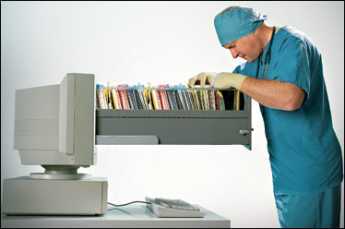 Healthcare is mainly information processing, but utilizing computers has been a disappointment. Be prepared for high costs and continuing disappointment for decades to come.
Healthcare is mainly information processing, but utilizing computers has been a disappointment. Be prepared for high costs and continuing disappointment for decades to come.
Health Maintenance Organizations, Reconsidered
 HMOs are wildly unpopular, giving every sign of phase-out. A pity, because proposed alternatives are worse, while the one corrective measure for HMOs seems so simple.
HMOs are wildly unpopular, giving every sign of phase-out. A pity, because proposed alternatives are worse, while the one corrective measure for HMOs seems so simple.
Healthcare Reform: Looking Ahead (1)
 It's safe to predict two upheavals in the cost of health care which will overwhelm all the old assumptions. The first upheaval comes in 2012 when the boomers retire.
It's safe to predict two upheavals in the cost of health care which will overwhelm all the old assumptions. The first upheaval comes in 2012 when the boomers retire.
Healthcare Reform: Looking Ahead (3)
 If radical new proposals for health care reform appear in the next few years, they are likely to originate in Detroit.
If radical new proposals for health care reform appear in the next few years, they are likely to originate in Detroit.
Segmented Health Insurance
 For a century, insurance has treated all medical care as one big lump. It's time to have a second look at this.
For a century, insurance has treated all medical care as one big lump. It's time to have a second look at this.
Money Bags
 When Medicare started it was chaos, worse confounded.
When Medicare started it was chaos, worse confounded.
Making Money (8): Virtual Money
 When money was tangible you had to guard it, now that it's mostly virtual you have to verify it. Hardly anybody can, and that's a problem.
When money was tangible you had to guard it, now that it's mostly virtual you have to verify it. Hardly anybody can, and that's a problem.
Exit, Pursued by a Bear
 Its medical school consumes 75% of Penn's budget, causing a lot of difficulty for the rest of the University.
Its medical school consumes 75% of Penn's budget, causing a lot of difficulty for the rest of the University.
War Dance
 The Iroquois had politics figured out long before the White Man arrived
The Iroquois had politics figured out long before the White Man arrived
Nation's First Hospital, 1751-2016
 The nation's oldest hospital changed more from 1948 to 2016 than it did from July 4. 1776 to 1948.
The nation's oldest hospital changed more from 1948 to 2016 than it did from July 4. 1776 to 1948.
Intelligensia, Philly Style
 All computer user groups are different. In Philadelphia they are more different.
All computer user groups are different. In Philadelphia they are more different.
Veterans Hospital
 In spite of much effort and expense, Veterans hospitals are not typical of American healthcare.
In spite of much effort and expense, Veterans hospitals are not typical of American healthcare.